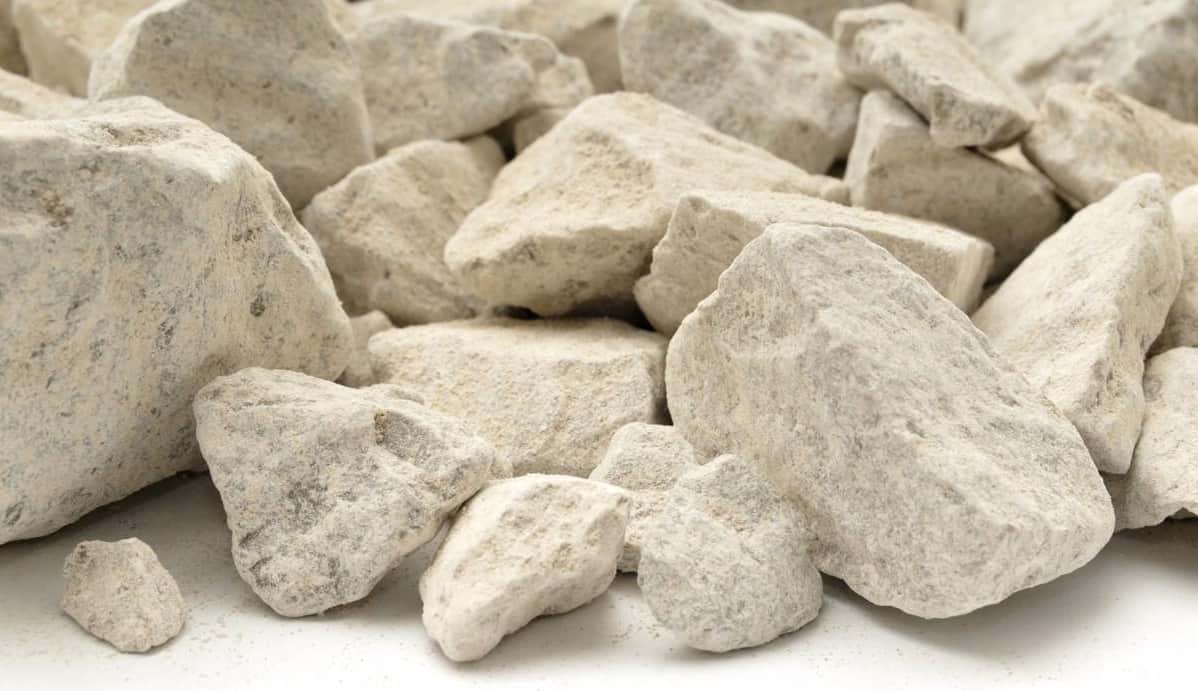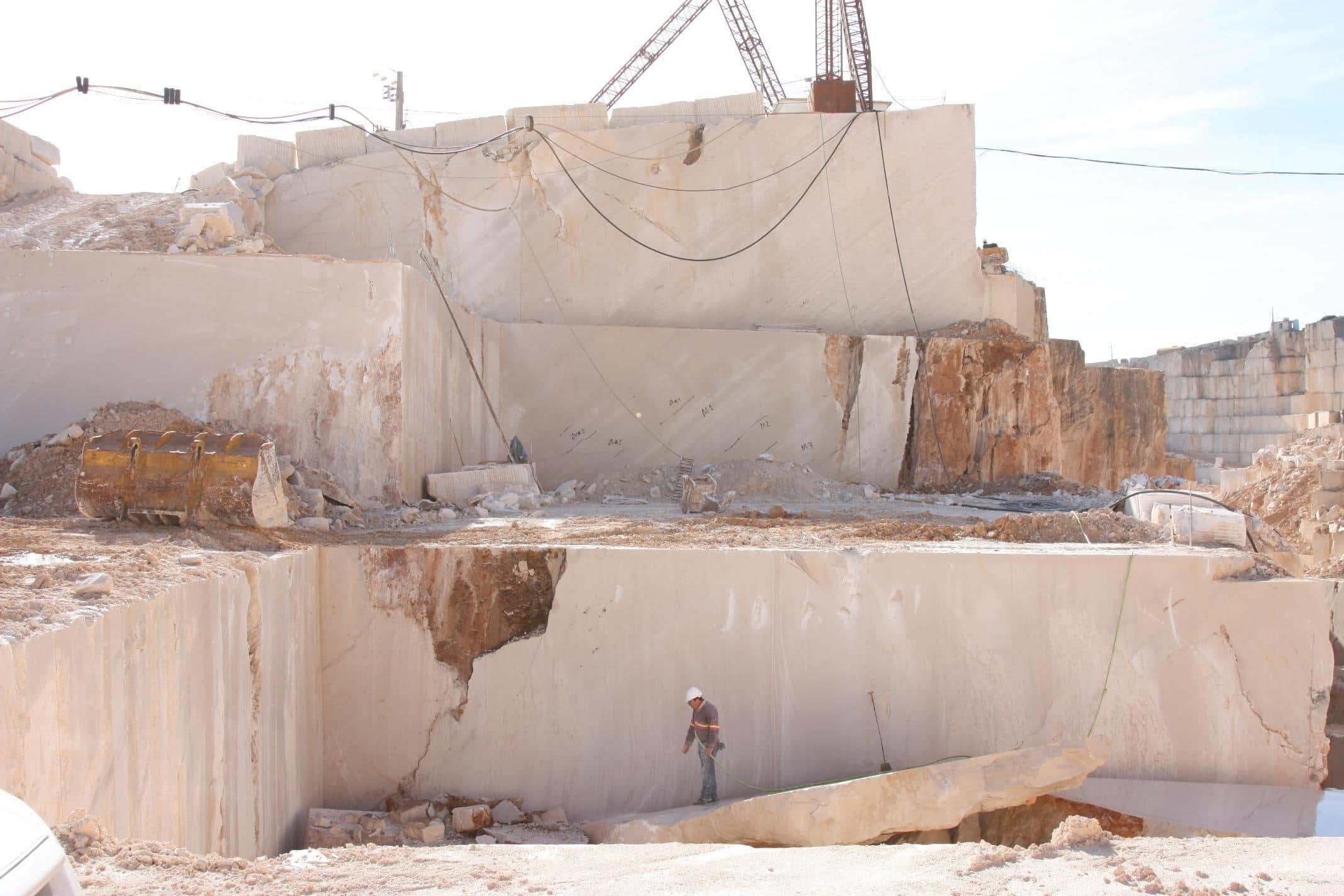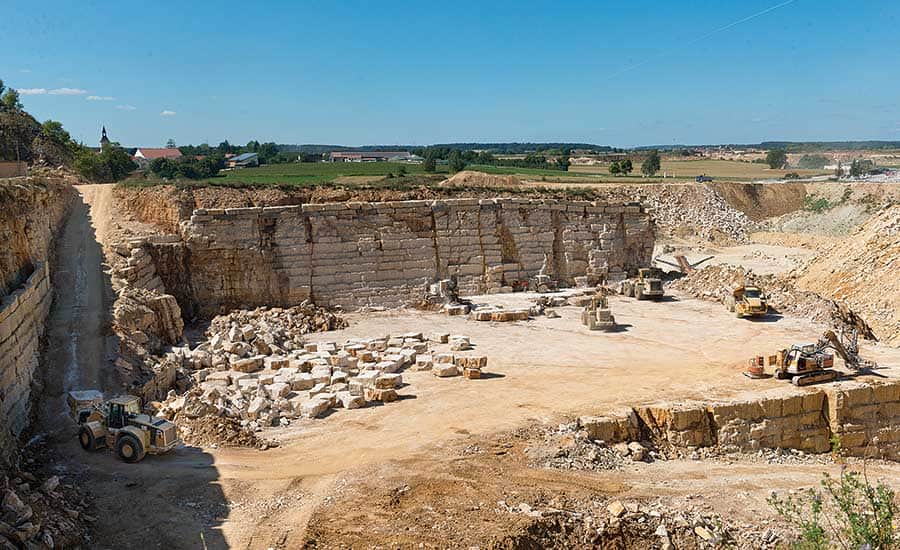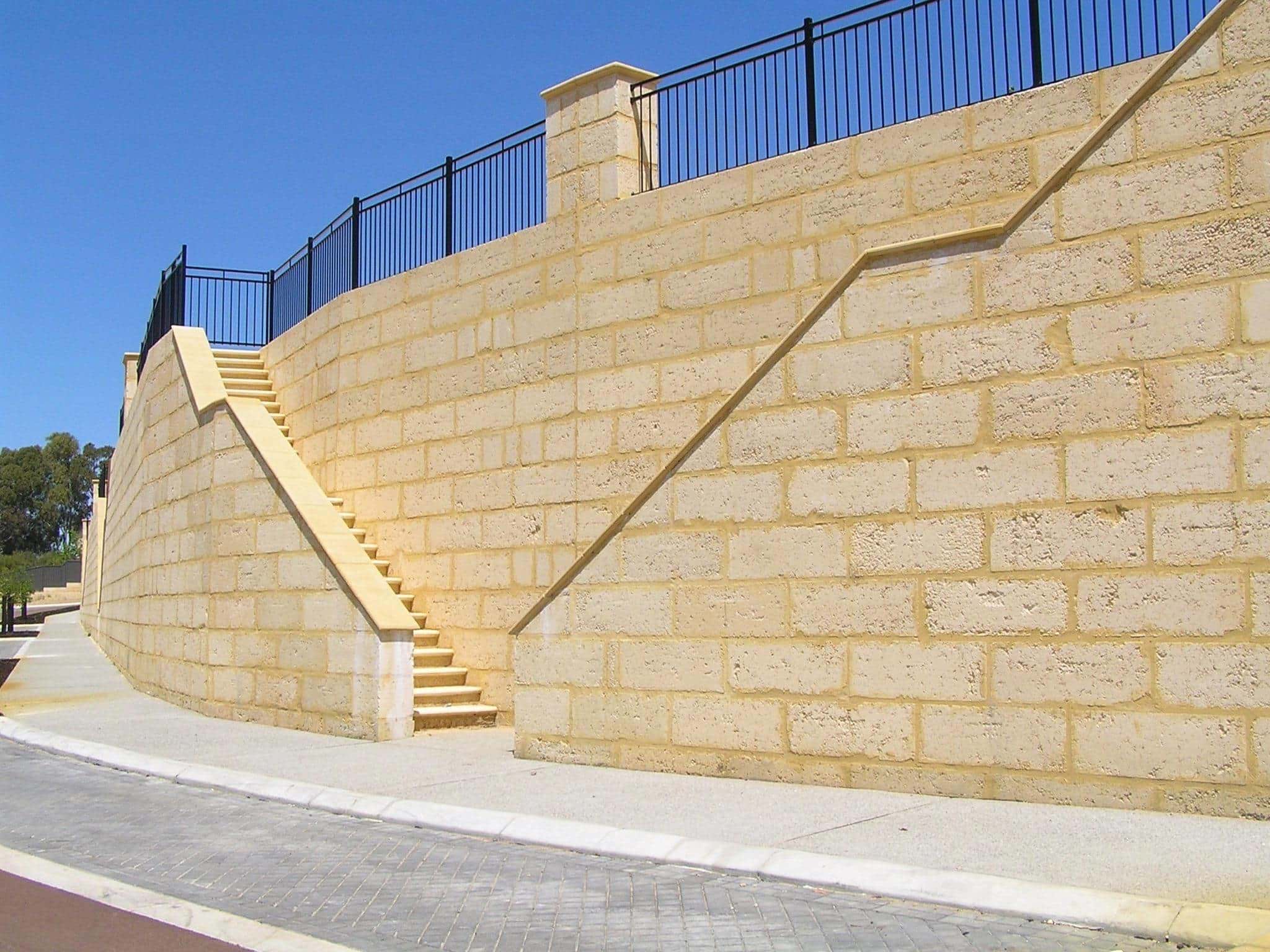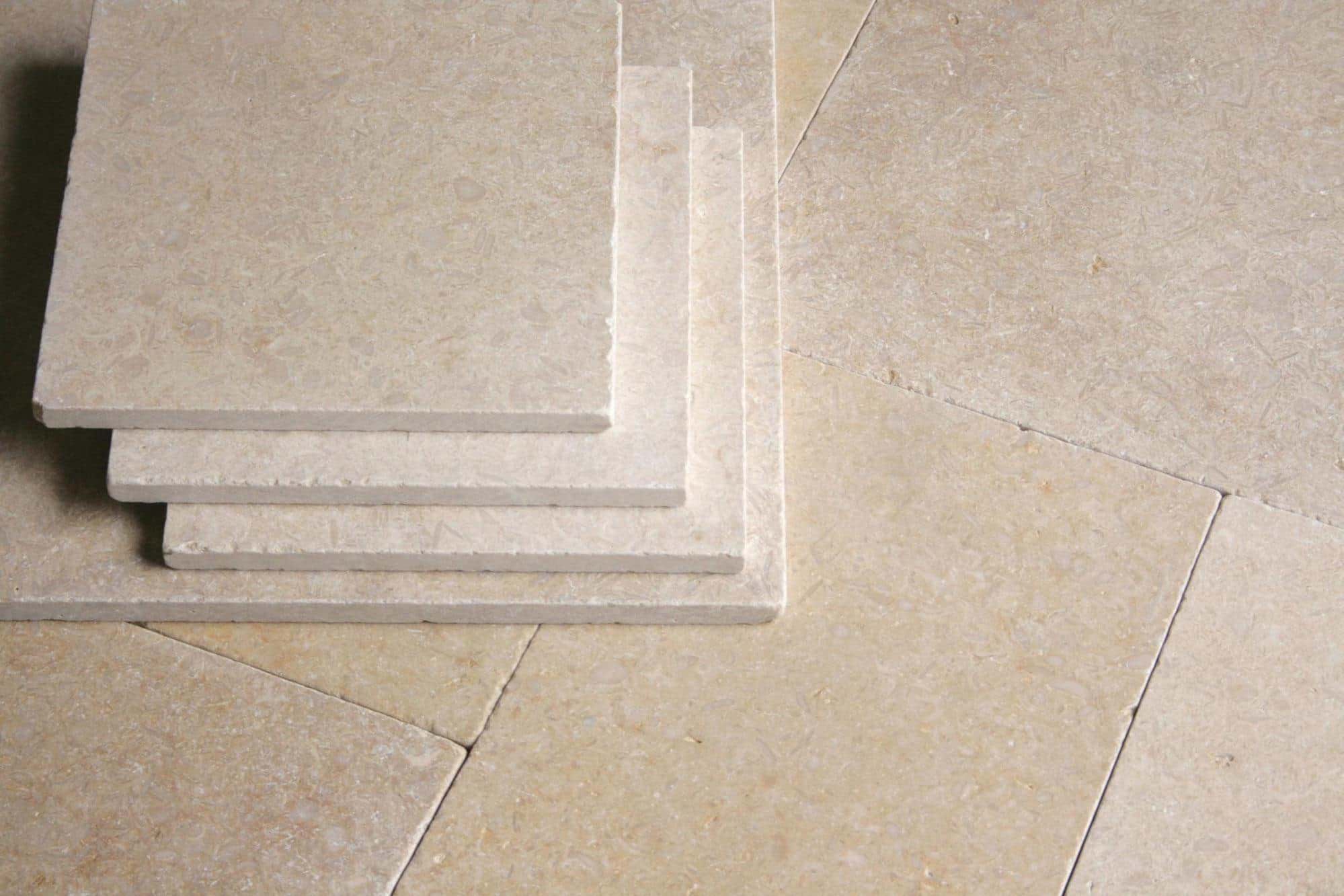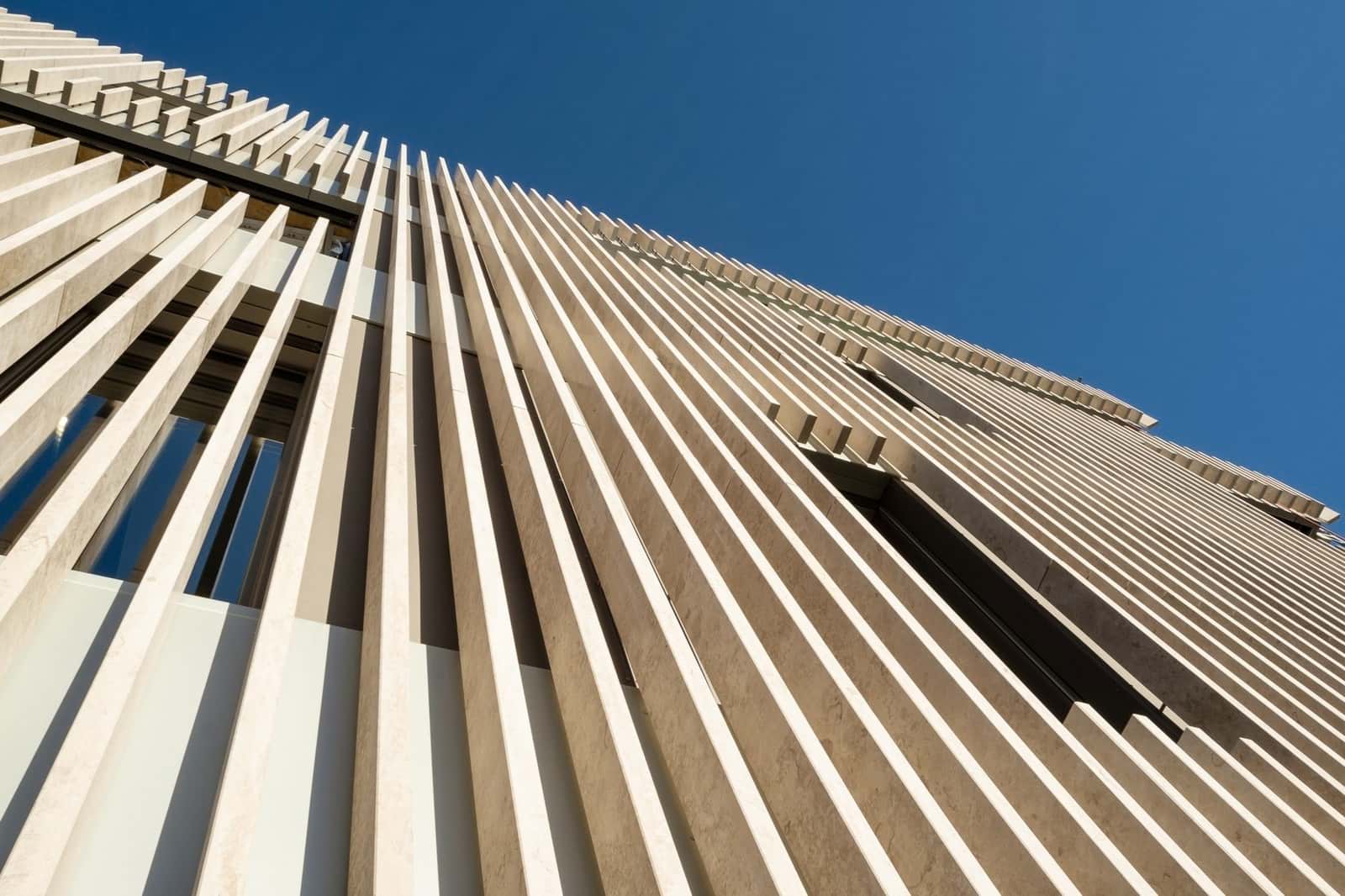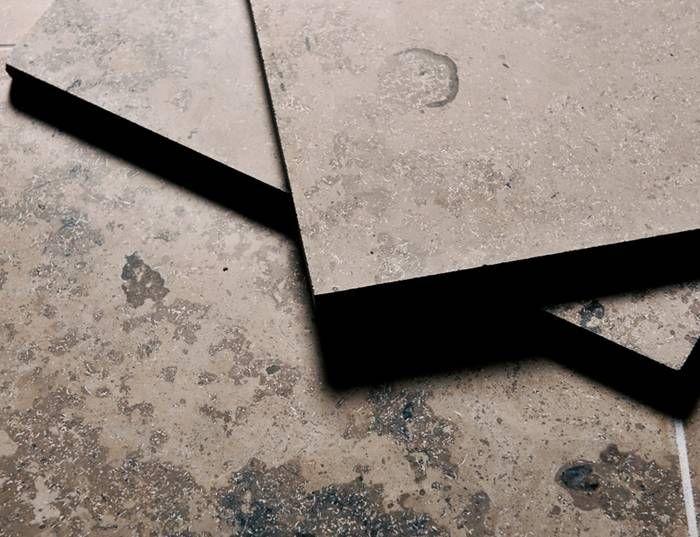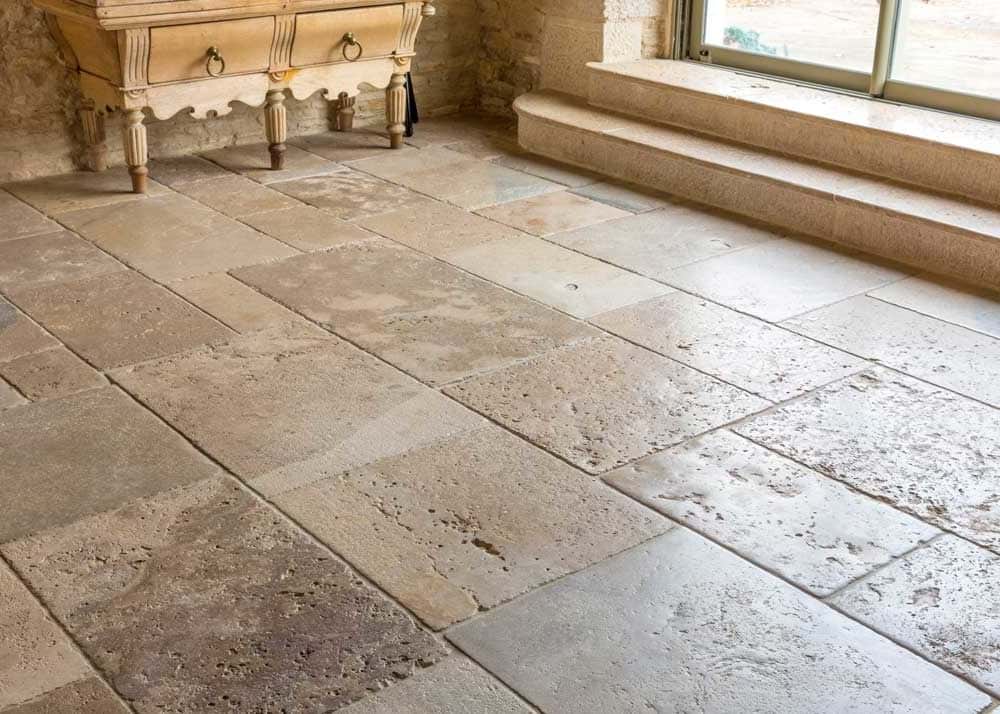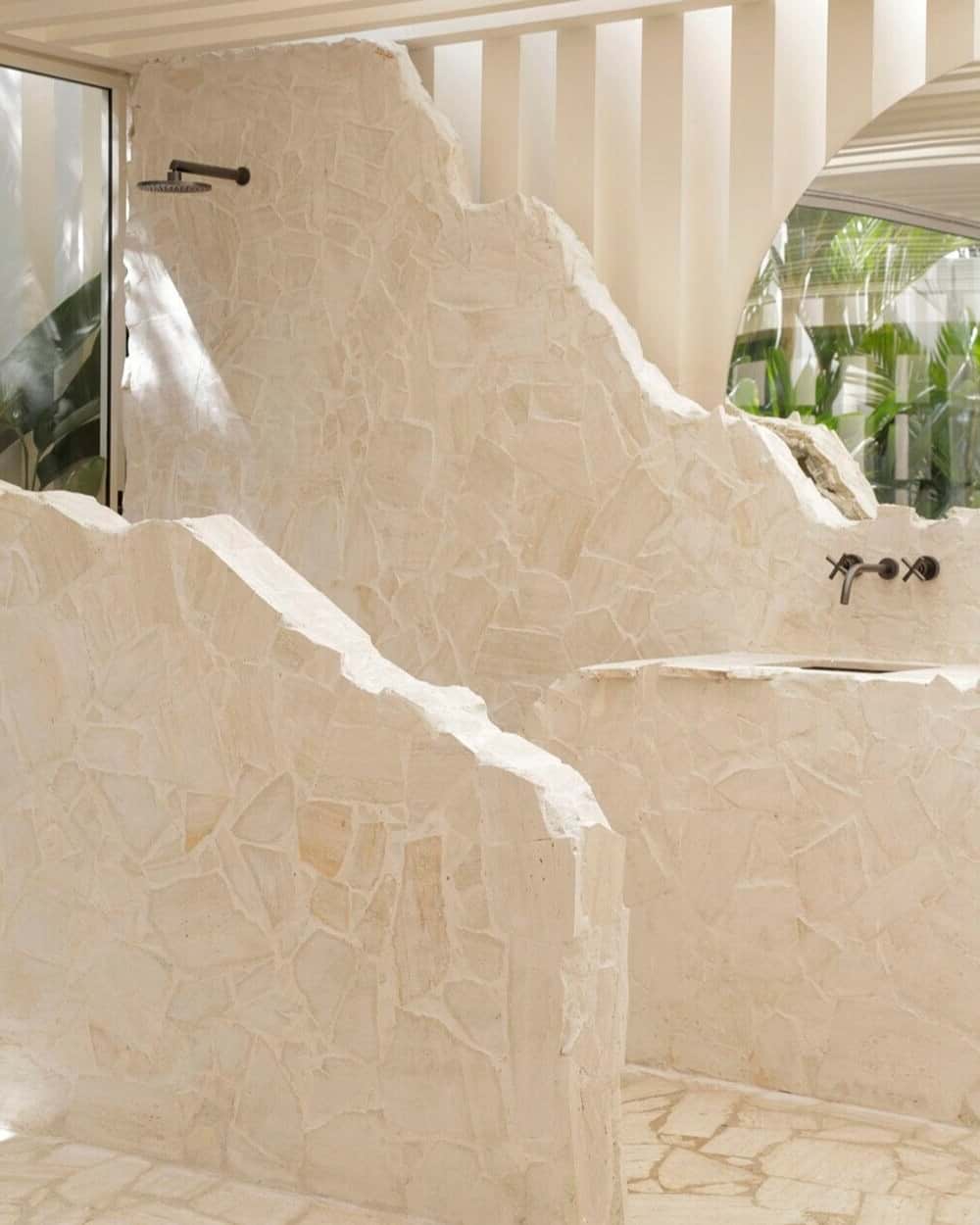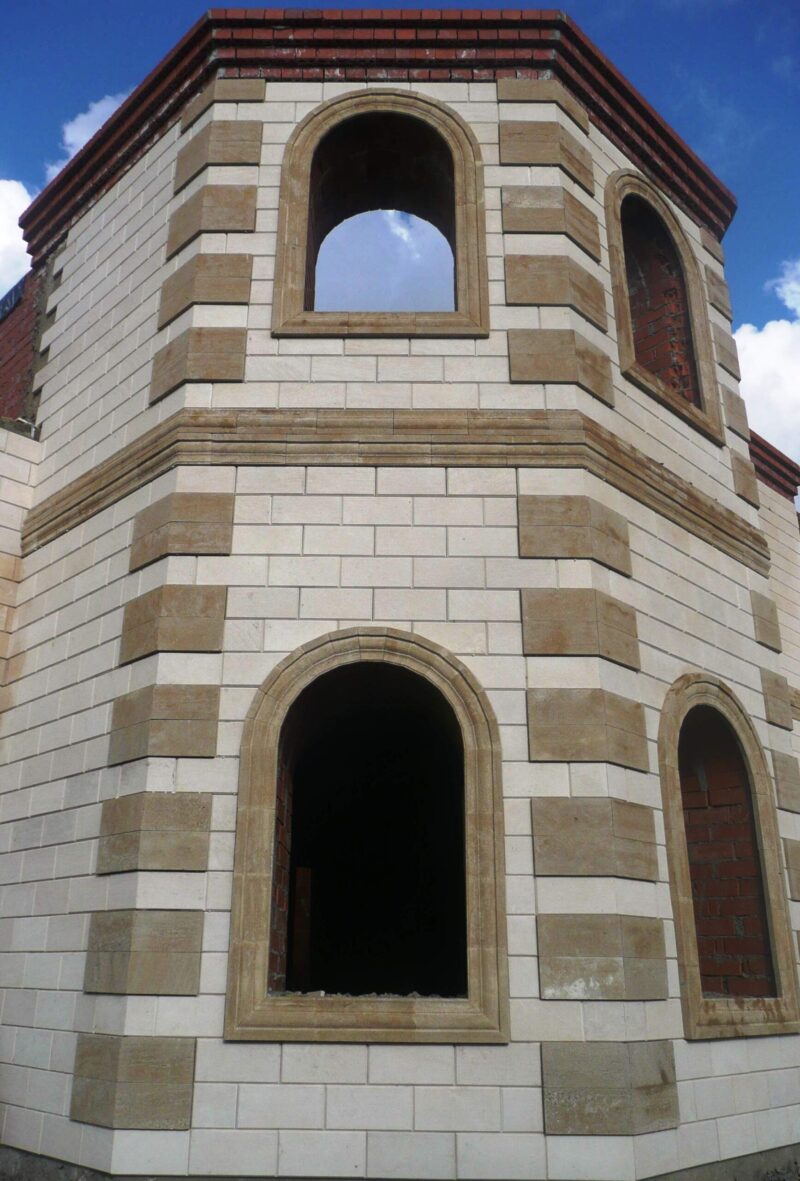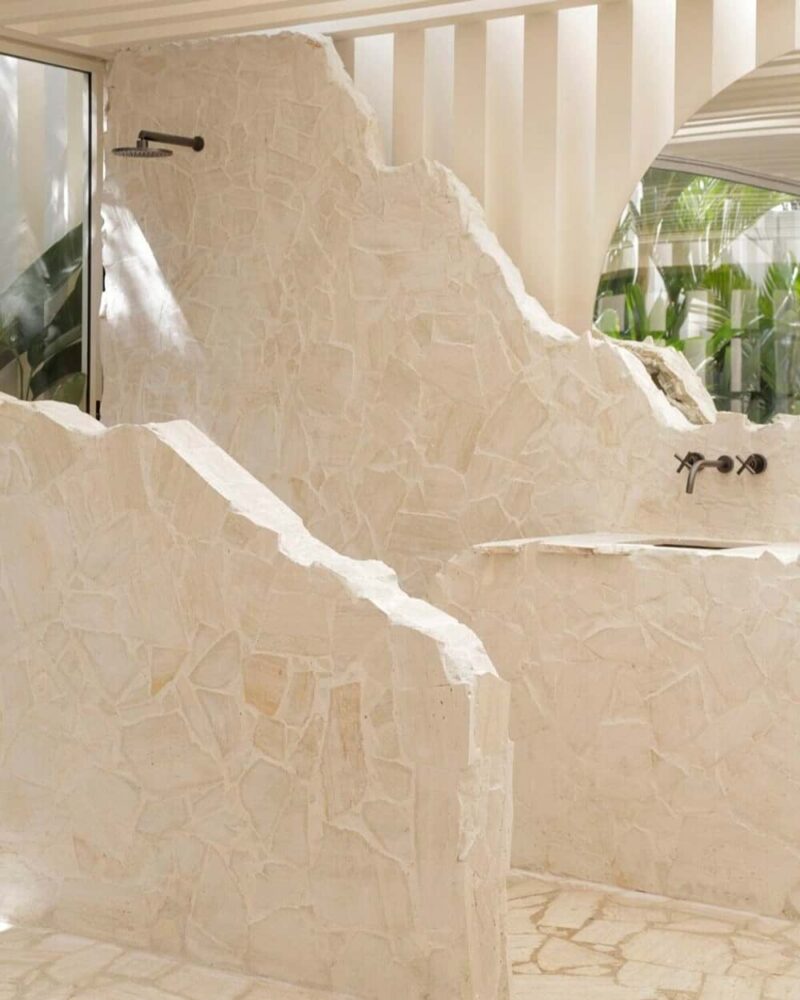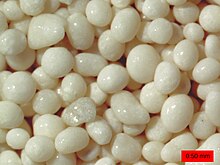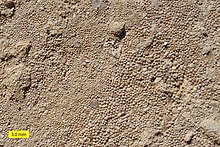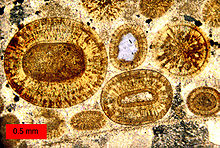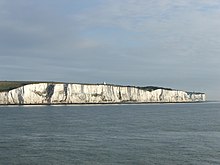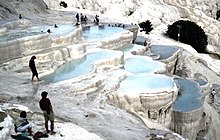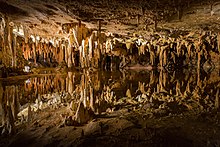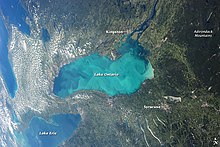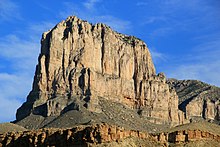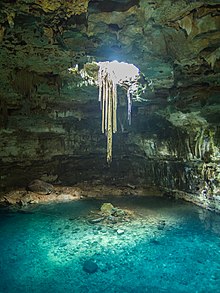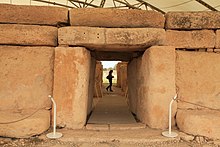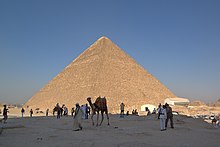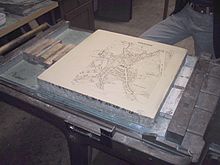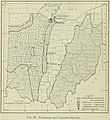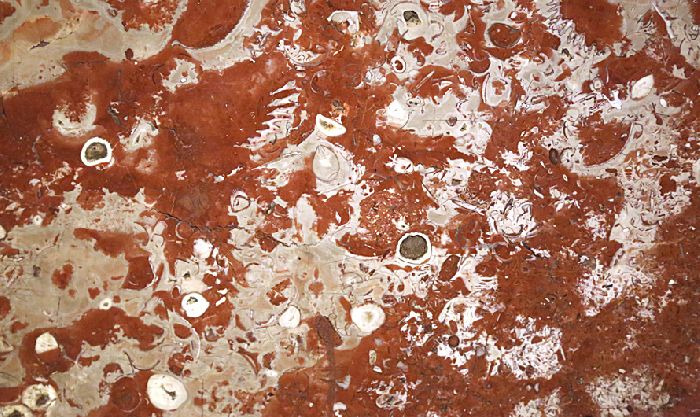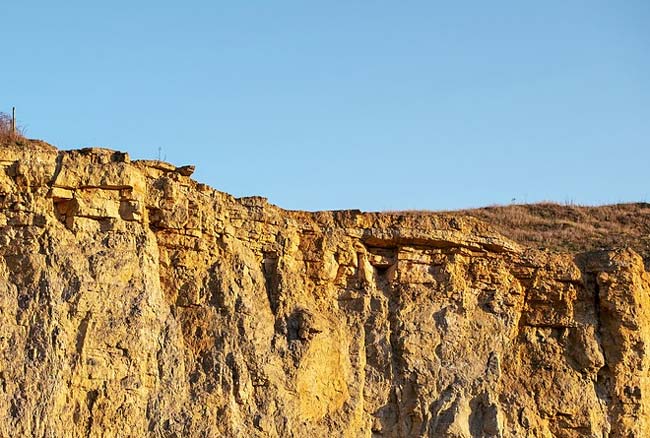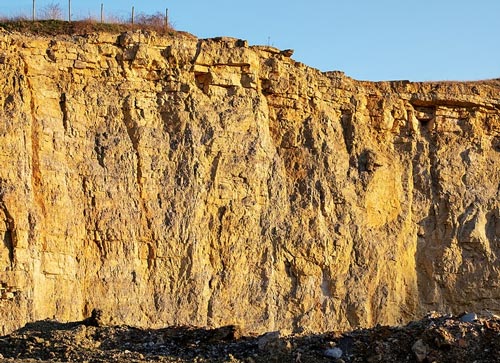Известняк – популярный в строительстве камень, подходящий для возведения стен, отделки фасадов, создания декоративных элементов и малых архитектурных форм.
История известняка в архитектуре, строительстве и зодчестве исчисляется тысячелетиями. Известно, что на территории современной Турции люди строили дома из известняка еще 14 000 лет назад. Пирамида Хеопса в Египте, Стена Плача в Иерусалиме, город Пальмира в Сирии – все это известняк. При строительстве Великой Китайской стены использовался известковый раствор, в Древнем Риме из камня научились делать мозаику.
Что такое известняк
Известняк это осадочная порода, в ходе образования которой формируется пористый камень различной плотности и оттенка с обилием в составе кальцитов (известковых шпатов). В структуру материала также входят другие минералы, которые снижают его пористость и повышают прочность. Известняки отлагаются преимущественно в соленых морских бассейнах, реже – при испарении лагун и озер. Цвет известняков преимущественно светло-серый, бежевый, желтоватый. Присутствие органических, железистых, марганцовистых и других примесей обусловливает тёмно-серую, бурую, красноватую и зеленоватую окраску.
Как правило, происхождение известняка связано с жизнедеятельностью организмов, которые выделяют из соленой воды карбонат кальция для формирования скелетов и раковин. Реже материал имеет хемогенное происхождение. Оседание породы длится миллионы лет (современные пласты остались после высыхания древних морей). Мощность толщ известняковых отложений кардинально отличается: от нескольких сантиметров до пяти километров. Чем меньше возраст отложений, тем более рыхлыми получаются породы.
Виды известняков
По структуре камень делится на такие виды:
- Кристаллический – плотный минерал, по своей структуре близкий к мрамору. Хорошо полируется за счет мелких пор, морозоустойчив.
- Органогенно-обломочный – это всем известный ракушечник, состоящий из остатков морских организмов. Хорошо обрабатывается (пилится, обтесывается), имеет большую пористость. К этому виду также относят рифовый известняк, крайне богатый на остатки морской фауны, и обычный мел – слабосцементированную карбонатную породу (фактически, затвердевший ил теплых морей).
- Обломочно-кристаллический – органогенный детрит, образованный из фрагментов растений, раковин и скелетов животных. Несмотря на мелкие поры, имеет малую прочность и высокую степень водопоглощения.
- Натечный (известковый туф) – формируется в стоячих и проточных подземных водоемах из нерастворимой соли, которая под давлением уплотняется. Камень из стоячих водоемов более плотный, из проточных – пористый и хрупкий.
По происхождению камень делится на:
- Биогенный – это отложения карбонатных остатков морских организмов с небольшой долей карбонатного цемента.
- Хемогенный – образуется в соленой воде или подземных источниках (тот самый туф) путем осаждения извести.
- Обломочный – образуется из угловато-окатанных обломков известняковых пород в ходе их раздробления и смыва.
- Смешанный – следствие одновременного протекания нескольких процессов, в ходе которых формируются карбонатные материалы.
Под воздействием высоких температур и давлений известковая порода постепенно уплотняется и становится более твердой, а ее зернистость уменьшается. В результате получается мрамор – по сути, метаморфизированный известняк с плотной кристаллической структурой. Резкого фазового перехода не происходит, мрамор формируется постепенно, поэтому в природе встречаются промежуточные варианты (например, мраморизированный известняк, одновременно плотный и легко поддающийся резке).
Свойства известняка
Свойства камня разнятся в зависимости от источника происхождения и напрямую зависят от структуры материала. Даже в одном месторождении могут встречаться залежи с различной плотностью, объемной массой и прочностью. Более плотные кристаллические породы хорошо полируются, пористые (например, ракушечник) – легко пилятся и обтесываются.
Физические характеристики материала:
- Плотность – 2700-2900 кг/м³.
- Объемная масса – от 800 кг/м³ (ракушечник) до 2800 кг/м³ (мраморизированные породы).
- Твердость по шкале Мооса – 3.
- Предел прочности при сжатии – от 0,4 МПа (ракушечник) до 300 МПа (кристаллический).
Основа известняка – карбонат кальция (50-95%). Остальное – это кварц, доломит, полевой шпат и другие минералы (5-50%). Именно из-за наличия в составе минералов камень имеет различные оттенки. Цвет известняка преимущественно белый, но в природе в обилии встречаются породы светло-серого, светло-желтого, красноватого, зеленого, бурого оттенка. Существует даже черный известняк – в его составе в обилии присутствуют нефтепродукты. В целом камень известен мягкими, пастельными тонами и ненавязчивыми цветовыми сочетаниями.
Физически и химически камень-известняк не слишком устойчив. Он растворяется в воде (пусть и медленно), поэтому при использовании камня в отделочных работах он обрабатывается водоотталкивающими составами. Особенно уязвим минерал к воздействию кислот (в частности, уксусной, серной, соляной), причем реакция протекает бурно и быстро, с образованием углекислого газа. В природных условиях это чревато образованием карстовых пустот, зачастую внушительных размеров. Морозостойкость камня существенно меняется в зависимости от пористости и наличия трещин. Наибольшую морозостойкость (до 400 циклов) имеют мраморизированные породы с плотной кристаллической структурой.
Добыча известняка
В России минерал добывается и разрабатывается преимущественно посредством буровзрывных работ (БВР). Предварительно проводятся вскрышные работы – верхний слой почвы снимается с помощью бульдозера и в дальнейшем используется для рекультивации. В твердом слое известковой породы бурятся шурфы глубиной до 24 метров, в них закладываются промышленные взрывчатые материалы и детонаторы (тротиловые шашки). Для одного подрыва обычно требуется 2-3 десятка скважин и порядка 5 тонн взрывчатки. Скважины взрываются не одновременно, а с задержкой в доли секунды.
Существует альтернативная европейская технология добычи известняка под названием Rip&Load (рыхление и погрузка), позволяющая работать без применения БВР. Массив забоя разрушается с помощью специального рыхлителя на тяжелом экскаваторе, после чего оператор не выходя из кабины меняет рыхлитель на ковш и грузит разрушенную горную массу в самосвал. Далее операция повторяется. Преимущество такой технологии – селективная выемка известковой породы в месторождениях со слоистой структурой. В обоих случаях используется тяжелая промышленная техника. Например, эксплуатационная масса экскаваторов в карьерах может достигать 240 тонн, а их производительность – 800 т/ч.
Образовавшиеся обломки породы грузятся тяжелым экскаватором в карьерные самосвалы и вывозятся на дробильно-обогатительную фабрику (ДОФ). В результате чаша карьера перемещается в сторону известковых пород, а выработанное пространство постепенно засыпается отсевом и вскрышными породами.
На дробильно-обогатительной фабрике известняк последовательно подвергается крупному, среднему и мелкому дроблению. Мелкие частицы камня (до 1 см) вывозятся обратно в карьер. Готовый продукт (дробленый камень) грузится в ж/д вагоны или автотранспорт и отправляется потребителям. В местах малых залежей известняк просто пилят на прямоугольники нужных размеров и вывозят грузовиками на завод.
В России основные месторождения минерала находятся в Московской и Тульской области. В Туле (помимо обычного) добывается ценный мраморизованный известняк, в Подмосковье – редкую породу кремового оттенка. Известняк встречается практически в любом регионе Земли, а некоторые карьеры используются на протяжении тысяч лет.
Использование известняка
Известняк – универсальный материал, нашедший применение в производстве, сельском хозяйстве, строительстве, дизайне помещений. Сфера применения камня различается в зависимости от его происхождения, физических характеристик, состава. Основные области использования известкового камня:
- Строительство. Прочности некоторых сортов известняка хватает, чтобы возводить из них малоэтажные здания, но в большинстве случаев материал используется в качестве облицовки. Из него делают стеновые панели, облицовочные плиты, декоративные элементы – колонны, пилястры, барельефы. Камень мелких фракций используют в качестве щебня при производстве бетона, крупных – для обустройства оснований автомобильных дорог и гидротехнических сооружений. Бутовый камень (крупные обломки размером до 500 мм) подходит для фундаментных работ.
- Отделка и облицовка. Известняк – популярный фасадный материал, хорошо противостоящий российским климатическим условиям. Тонкие срезы износостойкого камня – готовый материал для укладки садовых дорожек и тротуаров.
- Дизайн помещений. Мраморизированный известняк редких оттенков используется для отделки стен, лестниц, пола, изготовления кухонных столешниц, подоконников, барных стоек. Камень изысканных цветов подходит для создания каминных порталов, журнальных столиков, декоративных колонн. В среде дизайнеров особенно ценится слоистый камень с ярко-выраженным рельефом.
- Производство отделочных материалов. На основе известняка делают белила, краску, шпатлевку.
- Изготовление цемента. Карбонатные компоненты в сырьевой смеси при производстве цемента могут достигать 80% от общего объема сырья. Наряду с известняком в цемент добавляют глину, шлак, корректирующие добавки.
- Химическая промышленность. Материал используется в технологиях производства пластика, резины, фармацевтических препаратов.
- Производство сахара, стекла, соды. Здесь минерал используется в качестве дополнительного сырья. Например, в производстве сахара используется известь, получаемая путем обжига карбонатных пород.
- Металлургия. Известняк – незаменимый компонент при выплавке металлов. Известняковый флюс снижает температуру плавления и облегчает отделение металла от пустой породы. Используется с рудами, богатыми кремнеземом и глиноземом.
Кроме этого, известняк активно используется в качестве компонента зубных паст и кремов для обуви, в производстве фильтров и минеральных удобрений. Минерал также применяется в производстве бумаги – из одной тонны материала можно получить порядка 800 кг готовой продукции. Некоторые виды известняка применяются в производстве абразивных материалов для тонкой шлифовки, а в сельском хозяйстве его используют в качестве минеральной добавки для скота и птицы.
Известняк важен не только для отделки зданий и интерьеров. Он незаменим в создании цемента, а также находит применение в других отраслях промышленности, таких как очистка сахара, производство стекла. Когда известняк нагрет, он используется в производстве железа и стали, а также глинозема и магнезии. Также известняк помогает очистить питьевую воду. Фермеры часто используют удобрение, которое содержит дробленый известняк на зерновых культурах. Известняк в смеси — источник питательных веществ и нейтрализатор кислотности почвы. Порошкообразный известняк используется, чтобы удалить примеси из литых металлов. Известняк используется в качестве наполнителя во множестве изделий, включая бумагу, пластмассу и краску. Самый чистый известняк даже используется в продуктах питания и лекарствах, таких как таблетки кальция и хлопья для завтрака.
Известняк в архитектуре и дизайне
Известняк является очень популярным материалом для строительства и облицовки зданий. Подходит для облицовки фасада, а также для создания декоративных элементов экстерьера – барельефов, колонн и пилястр, кронштейнов. Область дизайнерских решений для интерьера довольно широка: изготовление колонн, арок, каминных порталов, отделка известняком полов и стен, дверных и оконных проемов. Некоторые виды известняка подходят для помещений с повышенной влажностью (ванные комнаты, бассейны).
В ландшафтном дизайне известняк используется при оформлении дорожек, террас, декоративных стенок, оград и сооружения альпийских горок (сохраняет тепло, пропускает воду и воздух, нормализует почвенный состав).
В нашей стране популярны отечественные известняки, Испанские известняки и Немецкие мраморизованные известняки. Благодаря относительно низкой цене (по сравнению с другими натуральными камнями) и устойчивости к перепадам температур (количество циклов зима/лето) известняк является самым популярным материалом для отделки фасадов жилых комплексов и коммерческих зданий и сооружений.
Самые популярные известняки:
Jura Beige
Jura Grey
Jura Rahmweis
Branco Valongo
Branco do Mar
Фотографии известняка
Ниже вы можете посмотреть несколько фотографий известняка в различном применении. Фасады, отделка стен, мощение и тд.
Известняки знакомы каждому человеку. По началу кажется, что этот камень вовсе не интересен и не привлекателен. Однако попытаемся доказать, что это не так!
Камень известняк не отличается разнообразной окраской и часто встречается в горных массивах. В чем же отличительная особенность известняка? Этот камень легко поддается обработке, включает широкий спектр текстурных поверхностей и естественных рисунков. Кроме того, он оставил значимый отпечаток в культуре и истории: Великая Китайская стена, Московский кремль, пирамиды древних египтян и другие сооружения.
Содержание статьи
- Что такое известняк?
- История
- Откуда берётся порода?
- Месторождения
- Добыча известняка
- Свойства камня
- Физико-химические характеристики
- Классификация разновидностей
- По структуре
- По химическому составу
- По сферам применения
- По происхождению
- Где используется?
- Строительство
- Промышленность
- Другие сферы
- Ограничения
- Лечебные свойства
- Магическое влияние
- Известняк для знаков зодиака
- Известняк для профессий
Что такое известняк?
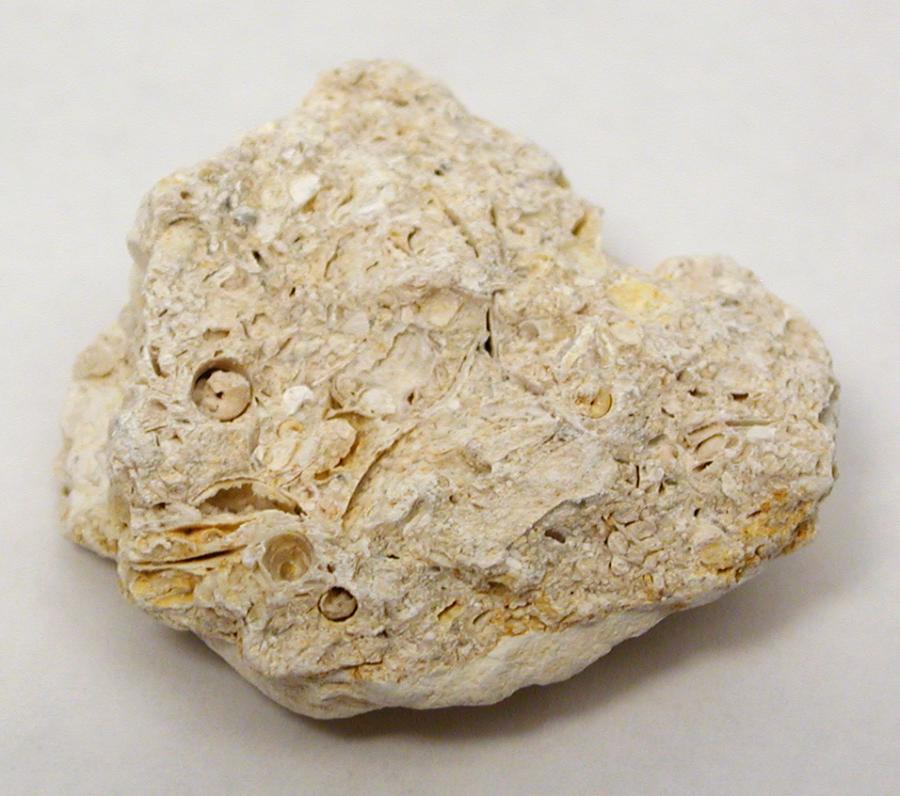
Известняк обычно серый, бежевый, песочный или желтоватый. Однако некоторые разновидности породы окрашены в красный, зелёный и бурый цвета. Минералоги связывают такое изменение цвета с присутствием в некоторых породах известняка примесей марганца и железа.
История
Известняковые породы начали зарождаться сто миллионов лет назад. В результате накопления биологических отложений в маловодных морях и озерах сформировались благоприятные условия для появления карбоната кальция. Сильные ветры, ураганы, бури и течения естественным образом размельчили морские ракушки, камни, кораллы. Образовавшийся песок со временем соединился с отложениями и сформировал известняк, который в дальнейшем из-за сильного давления глубины уплотнился и под движением тектонических плит вышел на поверхность Земли.
Сероватый материал заметили древние люди и стали использовать его для обустройства и укрепления своих жилищ в пещерах. С тех пор известняк стали воспринимать как прочный строительный материал, из которого возводили стены, памятники, скульптуры и многое другое. Монументы культуры, созданные из известняка много веков назад, до сих пор находятся в хорошем состоянии. Это Египетские пирамиды, Китайская стена и Кремль в Москве.
Широкое распространение породы позволило людям с древних времен приспособить известняк в различных сферах. С помощью отвердевших образцов, напоминающих мел, писали и создавали наскальные рисунки с первобытных времен. Известняковая порода помогала им укреплять жилища и сохранять тепло внутри помещений. Именно сюда первобытные люди приносили добычу с охоты, устраивали в пещерах советы старейшин. В ходе эволюции они научились простейший способам обработки горных пород. Тогда в быту древних общин появилась посуда с использованием известняка, а крупные камни послужили орудием труда.
Известно, что из серой осадочной породы были возведены известные всем достопримечательности мирового уровня. Например, Собор Парижской Богоматери, Беленская башня в Лиссабоне, храм Христа Спасителя в Москве и многие другие.
Откуда берётся порода?
Происхождение этого материала связывают с деятельностью породообразующих древних организмов, в ходе которой из соленой воды образуется карбонат кальция для формирования скелетов и раковин. Реже материал возникает в результате химического осаждения из водных растворов или при испарении воды. Известняковая порода образуется в морских и пресных водоёмах, а также в районах морских бассейнов и озёр. В природе известняк залегает в форме толстых пластов, достигающими размеров до тысячи метров. Добыча известняковых пластов производится карьерным способом, так как порода залегает неглубоко.
Месторождения
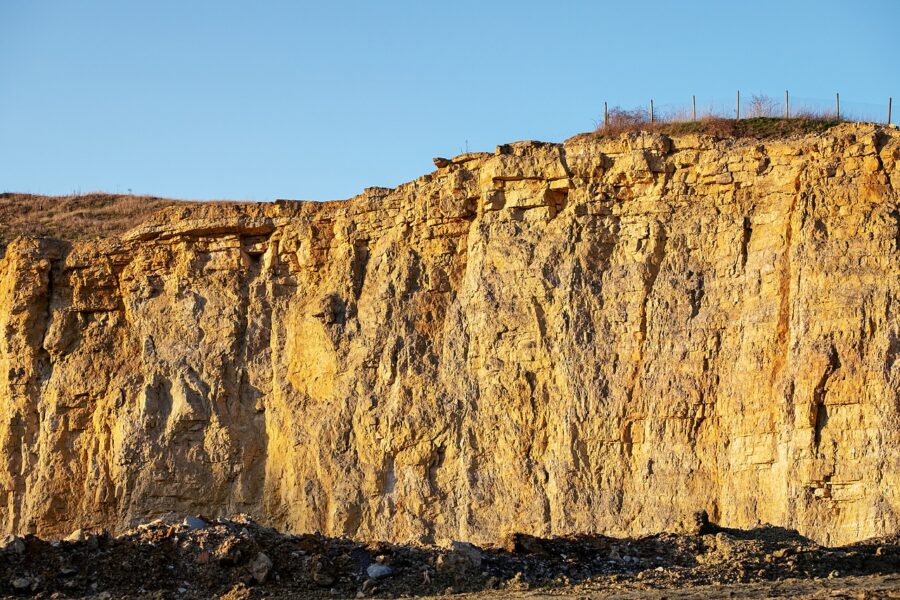
Самыми богатыми на известняк считается Ждановское месторождение, которое построено на территории РФ в Оренбургской области. Известняки добываются здесь и отправляются на заводы в Челябинске и на Урале. Также стоит выделить Кемеровскую и Новосибирскую области.
Известняк также залегает за пределами нашей страны — большие месторождения обнаружены в Америке и Австралии.
Добыча известняка
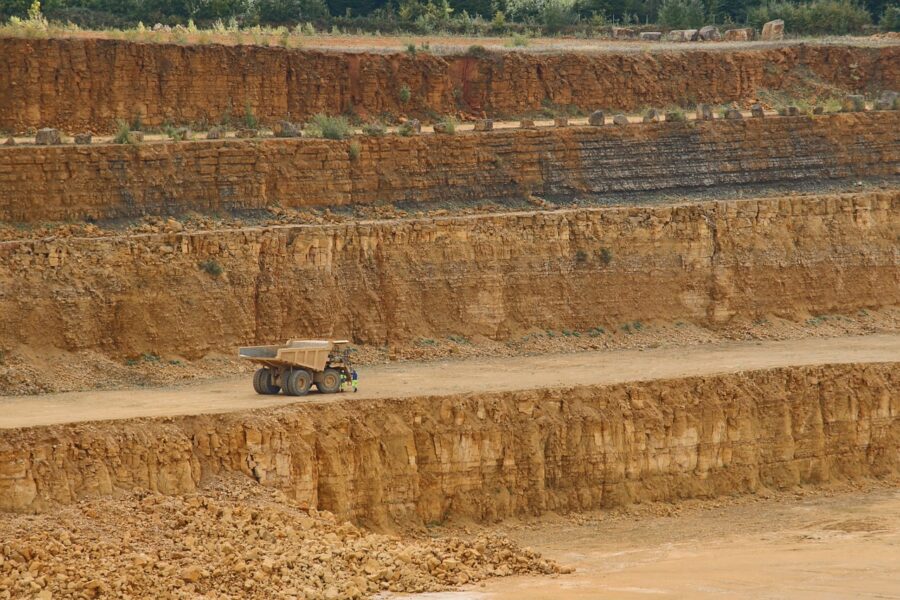
Известняковый камень добывают несколькими способами:
- Карьерный. В месторождениях, где располагаются крупные пласты известняка снимают верхней грунтовых слой и разрабатывают карьеры для добычи. Для транспортировки камня используют карьерные самосвалы.
- Взрывной. На территориях, где размещаются мелкие залежи породы, используют технику взрыва. Изначально с поверхности снимаются верхний грунт и глина, затем формируются специальные пространства, куда закладывается взрывчатка. В результате взрыва образуются контурные щели, где известняк добывают блоками.
- Фрезерный. Этот способ подразумевает добычу известнякового камня механическими средствами. Породу измельчают, погружают и перемещают фрезерными комбайнами.
Важно отметить, что при добыче известняка снимают целые пласты земной поверхности. Это пагубно влияет на экологическую обстановку, так как происходит уничтожение растительного мира на территории проведения работ по добыче породы. Поэтому, как карьер исчерпается по запасам известняка, необходимо провести рекультивацию и посадить деревья.
Свойства камня
Свойства известняка зависят от его происхождения и структуры. В одном месторождении могут находиться залежи с неоднородной плотностью, разной массой и прочностью.
Физико-химические характеристики
Плотность – от 2700 до 900 кг/м³. Зависит от месторождения и содержания различных примесей в породе: доломита, кварца и других минералов.
Масса – от 800 до 2800 кг/м³.
Твердость по шкале Мооса – 3.
Известняк растворяется в воде.
При температуре нагревания до 200 °C стремительно разлагается. При специальном обжиге получается известь.
Прочность при давлении – от 0,4 МПа до 300 МПа.
Известняк представляет собой чистую породу с породообразующим элементом карбонатом кальция (CaCO3). Он в свою очередь разлагается на оксид кальция (СаО) – 56% и углекислый газ (СО2) – 44%.
Наличия в составе породы разнообразных минералов определяет различные оттенки. Известняк представлен в природе белым или серым цветом, хотя встречаются породы и других цветов: голубого, светло-желтого, красного и бурого. Самым необычным является черный известняк – в его составе присутствуют нефтепродукты, что объясняет цвет камня.
Классификация разновидностей
Виды известняка классифицируются по ряду признаков.
По структуре
- кристаллический (плотный материал, сравнимый по структуре с мрамором. Легко подается полировке за счет мелких пор, не боится мороза и влаги);
- органогенно-обломочный (Материал хорошо обрабатывается. Этот вид называют рифовым известняком, насыщенным различными остатками морской фауны и обломками раковин. К этой разновидности известняка также относят обычный мел – слабосцементированную карбонатно-кальциевую породу. В жизни он получил простое название – ракушечник, так как этот вид известняка богат на наличие организмов морской фауны. Такой вид известняка довольно хрупкий и легко рассыпается. Из-за этого его часто используют для изготовления мела);
- натечный (данный вид известняка образуется в проточных подземных водоёмах преимущественно из нерастворимой соли, а затем уплотняется под давлением. Известняковые камни из стоячих водоемов плотные. Породы из проточных вод наоборот имеют структуру более пористую и хрупкую);
- обломочно-кристаллический (такой камень представляет собой органогенный детрит, сформировавшейся из останков рыб, раковин и костей животных. В отличие от других подобных материалов, которые имеют большую прочность и низкую степень водопоглощения, этот материал обладает малой прочностью и высокой степенью водопоглощения).
По химическому составу
- доломитизированные (состав известняка включает в среднем 4-17 % MgO);
- мраморизованные (карбонатные известняки, которые отличаются характерным цветом – голубоватым и серым, а также большим уровнем содержания органических частиц);
- коралловые (пористые и твердые известняки, образующиеся из кусков раковин в рифах и кораллов на дне морей);
- глинистые (породы с частыми включения глины и карбонатов. Обладают повышенной мягкость и хрупкостью).
По сферам применения
- флюсовый (вид известняка, отличающийся высокой прочностью. Применяется в металлургии для выплавки различных металлов);
- облицовочный (камень известняк, который используют в строительстве и для облицовки интерьеров помещений и зданий).
По происхождению
- Хемогенный. Процесс образования известняка в соленой воде и подземных водных источниках. Известь осаждается и формируется в породу.
- Биогенный. Происходит отложение остатков морских организмов, которые со временем превращаются в карбонат и образуют известняк.
- Обломочный. Различные осколки и обломки, образующиеся в ходе приливов и сильных волн, представляют состав обломочного известняка
- Смешанный. Такой известняк получается в ходе протекания одновременно нескольких процессов.
Иногда известняк подвергается воздействию климатических факторов, что влияет на его происхождение и формирование. Повышенная температура нагрева превращает известь в каменный известняк с плотной структурой. На промежуточном этапе нагрева может получиться мрамор.
Интересно! Одним из проявлений известняка в природе являются сталактиты и сталагмиты. Это отложения в пещерах в виде образований, свешивающихся с потолка. Формы сталактитов, в составе которых присутствует известняк, поражают своей красотой и уникальностью. Они включают мелкие кристаллы кальцита и отливают желтоватыми и розовыми цветами сквозь прозрачный верхний слой.
Где используется?
По своим характеристикам и свойствам известняк является универсальным материалом, который нашел применение в производстве, сельском хозяйстве, а также в строительстве. Выбор камня зависит от его происхождения, физических характеристик и состава. Что же касается сферы применения, то она может быть самой разнообразной – от внутренней отделки до внешней облицовки.
Благодаря своей необычной пористости известняк стал популярным материалом, так как его легко пилить и предавать различные формы. Широко распространен в ландшафтном дизайне и экстерьере различных строений. Незаменим и при создании скульптур. Например, в Древней Руси камнечесцы работали именно с известняком для вырезания барельефов на плитах.
Широкое применение обусловлено не только простотой в обработке, но и другими полезными свойствами. Известняк – экологически чистый натуральный материал, поэтому не оказывает негативного влияния на организм человека. Являясь своего рода антисептиком, не вызывает аллергических реакций и раздражений, что важно для людей чувствительных к такому роду вещам.
От разновидности известняка зависит вид обработки породы. Ракушечник легко обтесывается и пилится, поэтому требует аккуратности. Если известняк отличается плотным цементирующим составом, то он обрабатывается не так легко и требует вмешательства механических машин высокой мощности. Слишком пористые известняковые плиты подвергаются специальной затирке и шлифовке, после которой они приобретают ровный и отполированный вид, пригодный к дальнейшей эксплуатации.
Ещё одним способом обработки служит обжиг с помощью печек. Здесь подразумевают последовательный процесс нагревания известняка, в завершении которого порода разлагается на оксид кальция и углекислый газ. Величина температуры зависит от разновидности известняка, и обычно достигает 1200 °C. Далее получившийся материал помещают во вращающиеся печи и после охлаждают. Для очень твёрдых пород известняка используют шахтные печки.
Строительство
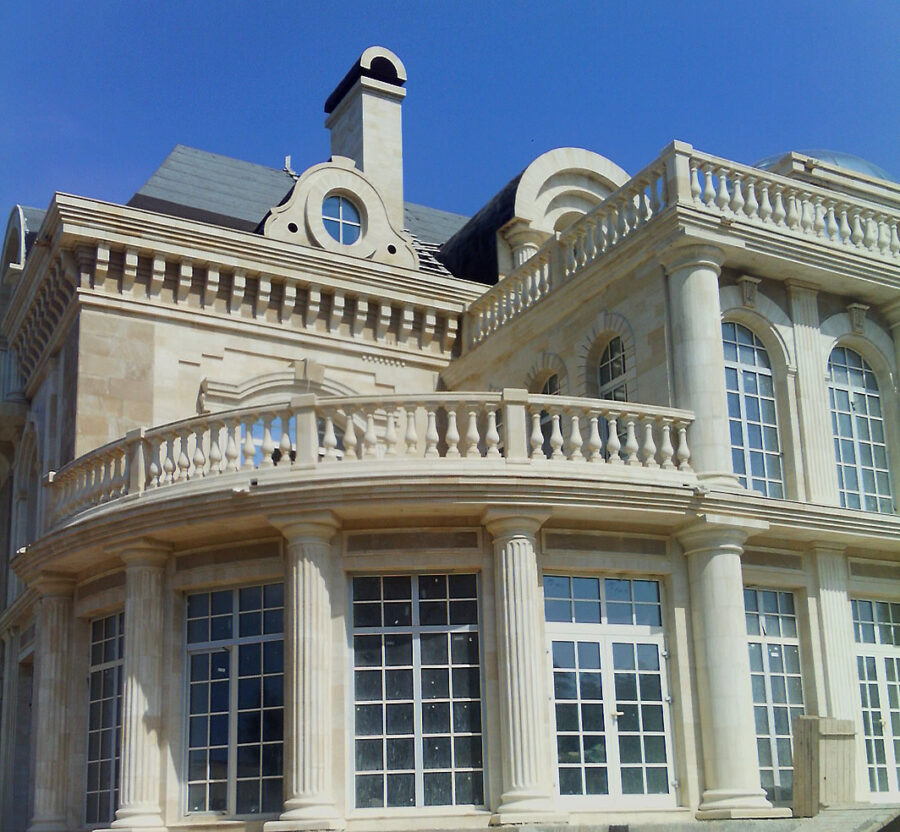
Интересной эстетичной особенностью у известняков считается способность не терять с течением времени своего некого элитарного вида. Стены и конструкции зданий приобретают античный шарм и налет. Плюсом у породы можно считать и отсутствие, как правило, радиоактивного фона. Стены из такого материала прекрасно дышат, пропуская пар и влагу, но при этом обладая звукоизоляцией. Поглощая солнечное тепло, предотвращают нежелательный нагрев здания, что важно для комфортного пребывания в них человека.
Промышленность
В данной сфере известняк используется при производстве стекла в качестве жаропрочного компонента. Камень также применяется в химической промышленности при изготовлении резины, лака и красок. Материал задействуется в сельском хозяйстве – добавки известняка закупают в качестве удобрения почвы и корма для скота.
Другие сферы
Отделка и облицовка. Известняковый материал используется как самостоятельный материал для отделки стен, так и в качестве основы для создания декоративных элементов интерьера. Профилированный камень, который используется для изготовления садовых дорожек и тротуаров, является готовым материалом для укладки.
Дизайн помещений. Из мраморизованного известняка редких оттенков изготавливаются стены, лестницы, мебельные гарнитуры, кухонные столешницы и барные стойки. Изящный камень идеально подходит для отделки каминов, столов и колон. Слоистый известняк отличается выпуклым рельефа, который ценится декораторами и архитекторами.
Ювелирное дело. Как правило, мастера используют для создания ювелирных украшений камни пастельных и нежных оттенков. Известняковые камни проходят специальную обработку и шлифовку до превращения их в полупрозрачные бусины. Они используются для вставки в кулоны, кольца, броши и серьги. Самые редкие по своей окраске разновидности известняка используются ювелирами для создания уникальных и более дорогих украшений.
Стекольное дело. Известняк неплотной структуры мелко дробят и используют в качестве одного из компонентов в производстве термостойкого стекла.
Меловые породы камня применяются при изготовлении карандашей, белого мела, зубных порошков, и в производство бумаги.
Ограничения
Известняк имеет ряд недостатков, которые ограничивают его использование в различных сферах.
Среди минусов:
- впитывает жидкость, что нарушает его прочность со временем и постепенно растворяет структуру камня;
- при сочетании с кислотами из пор известняка выходит углекислый газ. Это способствует разложению известняковых массивов из-за осадков и попаданию кислот в грунтовые воды;
Из-за этих свойств под зданиями, в строительстве которых использовали известняк, могут образовываться пустоты. Для укрепления структуры породы при строительстве его пропитывают специальными водоотталкивающими растворами.
Лечебные свойства
Известняковый камень востребован благодаря не только строительном потенциала, но и лечебным свойствам. Известняк можно смело назвать натуральным камнем, так как он имеет чистую структуру с экологической точки зрения и органический состав. Именно поэтому он благоприятно воздействует на здоровье человека:
Материал представляет собой антисептик природного происхождения. Известняк обеззараживает раны, блокирует распространение инфекции по всему организму и не вызывает раздражения и является гипоаллергенным.
В народной медицине считается полезным пить воду, которая прошла очистку кальцитом, т.е. известняком. Такой раствор способствует улучшению пищеварения и очистки организма от вредных шлаков.
Известняк добавляют в специальные растворы и наносят на стены для того, чтобы избавиться от сырости и грибка.
Важно! Лечебные характеристики известняка принято различать в зависимости от его цвета. Так, жёлтые камни благотворно влияют на ментальное здоровье и часто используются при медитациях; красные применимы при проблемах с нервной системой; голубой известняк снижает давление, а розовый борется с бессонницей. Для достижения эффективного результата камень известняк прикладывают к болезненному месту.
Несмотря на все полезные качества, известняк может и навредить. Если человек будет часто находиться в контакте с известняком, например, при его обработке или добыче, и вдыхать большое количество пыли от этого материала, то это может негативно сказаться на здоровье и вызвать заболевания дыхательных путей.
Магическое влияние
Известняк обладает теми же магическими свойствами, что и кальцит. Камень помогает развитию у человека способностей ясновидения – он позволяет увидеть будущее и предотвратить последствия ошибочных решений и поступков прошлого. Талисманы с известняком наделяют человека развитой интуицией, защищают от зависти окружающих и облегчают жизненный путь человека. Кроме того, магические качества известнякового камня лишают хозяина чрезмерной лени, апатии и усталости, а взамен дарят хорошее настроение на долгое время и приносят успех в творчестве или карьере. Камень часто используют женщины для того, чтобы привлечь внимание понравившегося мужчины. Своими энергетическими волнами камень притягивает противоположный пол.
Благодаря своей чистой энергетике, известняк помогает очистить ауру дома или какого-то либо помещения и наладить семейный быт, оградив партнёров от частых ссор и конфликтов.
Известняк для знаков зодиака
Обереги с известняковым материалом подходят всем знакам зодиака, кроме Скорпионов. Считается, что люди с данным знаком зодиака обладают тёмной энергетикой и чаще напрямую относятся к чёрной магии. Это противоречит известняку, так как он излучает исключительно светлую энергию и обладает духовной чистотой. Важно отметить, что горная порода не подойдёт тем знакам зодиака, обладатели которых явится по характеру агрессивными, вспыльчивыми, нетерпеливыми и волевыми. Остальным же камень подарит умиротворение, спокойствие и принесёт в их жизнь гармонию. Известняковый оберег помогает несовместимым знакам зодиака найти общий язык и достигнуть гармонии, как в деловых, так и в любовных отношениях.
Известняк для профессий
Известковый камень принесёт пользу людям, которые постоянно сталкиваются с обработкой информации, подсчётами или замерами. Например, инженерам, бухгалтерам, финансистам и т.д. Известняк поможет людям таких профессий сосредоточиться, не допустить ошибок и неточностей. Кальцит – основа породы, способная к развитию интуиции и привлечению внимания. Поэтому амулеты и различные обереги рекомендуют носить людям, занятым в деятельности, требующей внимания и сосредоточенности: работникам финансовых и правовых структур, а также медикам.
Считается, что известняк – это камень вдохновения. Он станет помощником для людей творческих специальностей. Талисман из известняковой породы подарит не только новые креативные идеи, но и силы для их реализации
| Sedimentary rock |

Limestone outcrop in the Torcal de Antequera nature reserve of Málaga, Spain |
| Composition |
|---|
| Calcium carbonate: inorganic crystalline calcite or organic calcareous material |
Limestone (calcium carbonate CaCO3) is a type of carbonate sedimentary rock which is the main source of the material lime. It is composed mostly of the minerals calcite and aragonite, which are different crystal forms of CaCO3. Limestone forms when these minerals precipitate out of water containing dissolved calcium. This can take place through both biological and nonbiological processes, though biological processes, such as the accumulation of corals and shells in the sea, have likely been more important for the last 540 million years.[1][2] Limestone often contains fossils which provide scientists with information on ancient environments and on the evolution of life.[3]
About 20% to 25% of sedimentary rock is carbonate rock, and most of this is limestone.[4][3] The remaining carbonate rock is mostly dolomite, a closely related rock, which contains a high percentage of the mineral dolomite, CaMg(CO3)2. Magnesian limestone is an obsolete and poorly-defined term used variously for dolomite, for limestone containing significant dolomite (dolomitic limestone), or for any other limestone containing a significant percentage of magnesium.[5] Most limestone was formed in shallow marine environments, such as continental shelves or platforms, though smaller amounts were formed in many other environments. Much dolomite is secondary dolomite, formed by chemical alteration of limestone.[6][7] Limestone is exposed over large regions of the Earth’s surface, and because limestone is slightly soluble in rainwater, these exposures often are eroded to become karst landscapes. Most cave systems are found in limestone bedrock.
Limestone has numerous uses: as a chemical feedstock for the production of lime used for cement (an essential component of concrete), as aggregate for the base of roads, as white pigment or filler in products such as toothpaste or paints, as a soil conditioner, and as a popular decorative addition to rock gardens. Limestone formations contain about 30% of the world’s petroleum reservoirs.[3]
Description
Limestone is composed mostly of the minerals calcite and aragonite, which are different crystal forms of calcium carbonate (CaCO3). Dolomite, CaMg(CO3)2, is an uncommon mineral in limestone, and siderite or other carbonate minerals are rare. However, the calcite in limestone often contains a few percent of magnesium. Calcite in limestone is divided into low-magnesium and high-magnesium calcite, with the dividing line placed at a composition of 4% magnesium. High-magnesium calcite retains the calcite mineral structure, which is distinct from dolomite. Aragonite does not usually contain significant magnesium.[8] Most limestone is otherwise chemically fairly pure, with clastic sediments (mainly fine-grained quartz and clay minerals) making up less than 5%[9] to 10%[10] of the composition. Organic matter typically makes up around 0.2% of a limestone and rarely exceeds 1%.[11]
Limestone often contains variable amounts of silica in the form of chert or siliceous skeletal fragments (such as sponge spicules, diatoms, or radiolarians).[12] Fossils are also common in limestone.[3]
Limestone is commonly white to gray in color. Limestone that is unusually rich in organic matter can be almost black in color, while traces of iron or manganese can give limestone an off-white to yellow to red color. The density of limestone depends on its porosity, which varies from 0.1% for the densest limestone to 40% for chalk. The density correspondingly ranges from 1.5 to 2.7 g/cm3. Although relatively soft, with a Mohs hardness of 2 to 4, dense limestone can have a crushing strength of up to 180 MPa.[13] For comparison, concrete typically has a crushing strength of about 40 MPa.[14]
Although limestones show little variability in mineral composition, they show great diversity in texture.[15] However, most limestone consists of sand-sized grains in a carbonate mud matrix. Because limestones are often of biological origin and are usually composed of sediment that is deposited close to where it formed, classification of limestone is usually based on its grain type and mud content.[9]
Grains
Ooids in limestone of the Carmel Formation (Middle Jurassic) of southwestern Utah.
Thin-section view of a Middle Jurassic limestone in southern Utah, U.S. The round grains are ooids; the largest is 1.2 mm (0.05 in) in diameter. This limestone is an oosparite.
Most grains in limestone are skeletal fragments of marine organisms such as coral or foraminifera.[16] These organisms secrete structures made of aragonite or calcite, and leave these structures behind when they die. Other carbonate grains composing limestones are ooids, peloids, and limeclasts (intraclasts and extraclasts).[17]
Skeletal grains have a composition reflecting the organisms that produced them and the environment in which they were produced.[18] Low-magnesium calcite skeletal grains are typical of articulate brachiopods, planktonic (free-floating) foraminifera, and coccoliths. High-magnesium calcite skeletal grains are typical of benthic (bottom-dwelling) foraminifera, echinoderms, and coralline algae. Aragonite skeletal grains are typical of molluscs, calcareous green algae, stromatoporoids, corals, and tube worms. The skeletal grains also reflect specific geological periods and environments. For example, coral grains are more common in high-energy environments (characterized by strong currents and turbulence) while bryozoan grains are more common in low-energy environments (characterized by quiet water).[19]
Ooids (sometimes called ooliths) are sand-sized grains (less than 2mm in diameter) consisting of one or more layers of calcite or aragonite around a central quartz grain or carbonate mineral fragment. These likely form by direct precipitation of calcium carbonate onto the ooid. Pisoliths are similar to ooids, but they are larger than 2 mm in diameter and tend to be more irregular in shape. Limestone composed mostly of ooids is called an oolite or sometimes an oolitic limestone. Ooids form in high-energy environments, such as the Bahama platform, and oolites typically show crossbedding and other features associated with deposition in strong currents.[20][21]
Oncoliths resemble ooids but show a radial rather than layered internal structure, indicating that they were formed by algae in a normal marine environment.[20]
Peloids are structureless grains of microcrystalline carbonate likely produced by a variety of processes.[22] Many are thought to be fecal pellets produced by marine organisms. Others may be produced by endolithic (boring) algae[23] or other microorganisms[24] or through breakdown of mollusc shells.[25] They are difficult to see in a limestone sample except in thin section and are less common in ancient limestones, possibly because compaction of carbonate sediments disrupts them.[23]
Limeclasts are fragments of existing limestone or partially lithified carbonate sediments. Intraclasts are limeclasts that originate close to where they are deposited in limestone, while extraclasts come from outside the depositional area. Intraclasts include grapestone, which is clusters of peloids cemented together by organic material or mineral cement. Extraclasts are uncommon, are usually accompanied by other clastic sediments, and indicate deposition in a tectonically active area or as part of a turbidity current.[26]
Mud
The grains of most limestones are embedded in a matrix of carbonate mud. This is typically the largest fraction of an ancient carbonate rock.[23] Mud consisting of individual crystals less than 5 microns in length is described as micrite.[27] In fresh carbonate mud, micrite is mostly small aragonite needles, which may precipitate directly from seawater,[28] be secreted by algae,[29] or be produced by abrasion of carbonate grains in a high-energy environment.[30] This is converted to calcite within a few million years of deposition. Further recrystallization of micrite produces microspar, with grains from 5 to 15 microns in diameter.[28]
Limestone often contains larger crystals of calcite, ranging in size from 0.02 to 0.1 mm, that are described as sparry calcite or sparite. Sparite is distinguished from micrite by a grain size of over 20 microns and because sparite stands out under a hand lens or in thin section as white or transparent crystals. Sparite is distinguished from carbonate grains by its lack of internal structure and its characteristic crystal shapes. [31]
Geologists are careful to distinguish between sparite deposited as cement and sparite formed by recrystallization of micrite or carbonate grains. Sparite cement was likely deposited in pore space between grains, suggesting a high-energy depositional environment that removed carbonate mud. Recrystallized sparite is not diagnostic of depositional environment.[31]
Other characteristics
Limestone outcrops are recognized in the field by their softness (calcite and aragonite both have a Mohs hardness of less than 4, well below common silicate minerals) and because limestone bubbles vigorously when a drop of dilute hydrochloric acid is dropped on it. Dolomite is also soft but reacts only feebly with dilute hydrochloric acid, and it usually weathers to a characteristic dull yellow-brown color due to the presence of ferrous iron. This is released and oxidized as the dolomite weathers.[9] Impurities (such as clay, sand, organic remains, iron oxide, and other materials) will cause limestones to exhibit different colors, especially with weathered surfaces.
The makeup of a carbonate rock outcrop can be estimated in the field by etching the surface with dilute hydrochloric acid. This etches away the calcite and aragonite, leaving behind any silica or dolomite grains. The latter can be identified by their rhombohedral shape.[9]
Crystals of calcite, quartz, dolomite or barite may line small cavities (vugs) in the rock. Vugs are a form of secondary porosity, formed in existing limestone by a change in environment that increases the solubility of calcite.[32]
Dense, massive limestone is sometimes described as «marble». For example, the famous Portoro «marble» of Italy is actually a dense black limestone.[33] True marble is produced by recrystallization of limestone during regional metamorphism that accompanies the mountain building process (orogeny). It is distinguished from dense limestone by its coarse crystalline texture and the formation of distinctive minerals from the silica and clay present in the original limestone.[34]
Classification
Two major classification schemes, the Folk and Dunham, are used for identifying the types of carbonate rocks collectively known as limestone.
Folk classification
Robert L. Folk developed a classification system that places primary emphasis on the detailed composition of grains and interstitial material in carbonate rocks.[35] Based on composition, there are three main components: allochems (grains), matrix (mostly micrite), and cement (sparite). The Folk system uses two-part names; the first refers to the grains and the second to the cement. For example, a limestone consisting mainly of ooids, with a crystalline matrix, would be termed an oosparite. It is helpful to have a petrographic microscope when using the Folk scheme, because it is easier to determine the components present in each sample.[36]
Dunham classification
Robert J. Dunham published his system for limestone in 1962. It focuses on the depositional fabric of carbonate rocks. Dunham divides the rocks into four main groups based on relative proportions of coarser clastic particles, based on criteria such as whether the grains were originally in mutual contact, and therefore self-supporting, or whether the rock is characterized by the presence of frame builders and algal mats. Unlike the Folk scheme, Dunham deals with the original porosity of the rock. The Dunham scheme is more useful for hand samples because it is based on texture, not the grains in the sample.[37]
A revised classification was proposed by Wright (1992). It adds some diagenetic patterns to the classification scheme.[38]
Other descriptive terms
Travertine is a term applied to calcium carbonate deposits formed in freshwater environments, particularly hot springs. Such deposits are typically massive, dense, and banded. When the deposits are highly porous, so that they have a spongelike texture, they are typically described as tufa. Secondary calcite deposited by supersaturated meteoric waters (groundwater) in caves is also sometimes described as travertine. This produces speleothems, such as stalagmites and stalactites.[39]
Coquina is a poorly consolidated limestone composed of abraded pieces of coral, shells, or other fossil debris. When better consolidated, it is described as coquinite.[40]
Chalk is a soft, earthy, fine-textured limestone composed of the tests of planktonic microorganisms such as foraminifera, while
marl is an earthy mixture of carbonates and silicate sediments.[40]
Formation
Limestone forms when calcite or aragonite precipitate out of water containing dissolved calcium, which can take place through both biological and nonbiological processes.[41] The solubility of calcium carbonate (CaCO3) is controlled largely by the amount of dissolved carbon dioxide (CO2) in the water. This is summarized in the reaction:
-
- CaCO3 + H2O + CO2 → Ca2+ + 2HCO−3
Increases in temperature or decreases in pressure tend to reduce the amount of dissolved CO2 and precipitate CaCO3. Reduction in salinity also reduces the solubility of CaCO3, by several orders of magnitude for fresh water versus seawater.
[42]
Near-surface water of the earth’s oceans are oversaturated with CaCO3 by a factor of more than six.[43] The failure of CaCO3 to rapidly precipitate out of these waters is likely due to interference by dissolved magnesium ions with nucleation of calcite crystals, the necessary first step in precipitation. Precipitation of aragonite may be suppressed by the presence of naturally occurring organic phosphates in the water. Although ooids likely form through purely inorganic processes, the bulk of CaCO3 precipitation in the oceans is the result of biological activity.[44] Much of this takes place on carbonate platforms.
An aerial view of a whiting event precipitation cloud in Lake Ontario.
The origin of carbonate mud,[30] and the processes by which it is converted to micrite,[45] continue to be a subject of research. Modern carbonate mud is composed mostly of aragonite needles around 5 microns in length. Needles of this shape and composition are produced by calcareous algae such as Penicillus, making this a plausible source of mud.[46] Another possibility is direct precipitation from the water. A phenomenon known as whitings occurs in shallow waters, in which white streaks containing dispersed micrite appear on the surface of the water. It is uncertain whether this is freshly precipitated aragonite or simply material stirred up from the bottom, but there is some evidence that whitings are caused by biological precipitation of aragonite as part of a bloom of cyanobacteria or microalgae.[47] However, stable isotope ratios in modern carbonate mud appear to be inconsistent with either of these mechanisms, and abrasion of carbonate grains in high-energy environments has been put forward as a third possibility.[30]
Formation of limestone has likely been dominated by biological processes throughout the Phanerozoic, the last 540 million years of the Earth’s history. Limestone may have been deposited by microorganisms in the Precambrian, prior to 540 million years ago, but inorganic processes were probably more important and likely took place in an ocean more highly oversaturated in calcium carbonate than the modern ocean.[48]
Diagenesis
Diagenesis is the process in which sediments are compacted and turned into solid rock. During diagenesis of carbonate sediments, significant chemical and textural changes take place. For example, aragonite is converted to low-magnesium calcite. Diagenesis is the likely origin of pisoliths, concentrically layered particles ranging from 1 to 10 millimeters (0.039 to 0.394 in) in diameter found in some limestones. Pisoliths superficially resemble ooids but have no nucleus of foreign matter, fit together tightly, and show other signs that they formed after the original deposition of the sediments.[49]
Akcakoca chert nodules within soft limestone
Silicification occurs early in diagenesis, at low pH and temperature, and contributes to fossil preservation.[50] Silicification takes place through the reaction:[50]
-
- CaCO3 + H2O + CO2 + H4SiO4 → SiO2 + Ca2+ + 2HCO−3 + 2 H2O
Fossils are often preserved in exquisite detail as chert.[50][51]
Cementing takes place rapidly in carbonate sediments, typically within less than a million years of deposition. Some cementing occurs while the sediments are still under water, forming hardgrounds. Cementing accelerates after the retreat of the sea from the depositional environment, as rainwater infiltrates the sediment beds, often within just a few thousand years. As rainwater mixes with groundwater, aragonite and high-magnesium calcite are converted to low-calcium calcite. Cementing of thick carbonate deposits by rainwater may commence even before the retreat of the sea, as rainwater can infiltrate over 100 kilometers (60 mi) into sediments beneath the continental shelf.[52]
As carbonate sediments are increasingly deeply buried under younger sediments, chemical and mechanical compaction of the sediments increases. Chemical compaction takes place by pressure solution of the sediments. This process dissolves minerals from points of contact between grains and redeposits it in pore space, reducing the porosity of the limestone from an initial high value of 40% to 80% to less than 10%.[53] Pressure solution produces distinctive stylolites, irregular surfaces within the limestone at which silica-rich sediments accumulate. These may reflect dissolution and loss of a considerable fraction of the limestone bed. At depths greater than 1 kilometer (0.62 mi), burial cementation completes the lithification process. Burial cementation does not produce stylolites.[54]
When overlying beds are eroded, bringing limestone closer to the surface, the final stage of diagenesis takes place. This produces secondary porosity as some of the cement is dissolved by rainwater infiltrating the beds. This may include the formation of vugs, which are crystal-lined cavities within the limestone.[54]
Diagenesis may include conversion of limestone to dolomite by magnesium-rich fluids. There is considerable evidence of replacement of limestone by dolomite, including sharp replacement boundaries that cut across bedding.[55] The process of dolomitization remains an area of active research,[56] but possible mechanisms include exposure to concentrated brines in hot environments (evaporative reflux) or exposure to diluted seawater in delta or estuary environments (Dorag dolomitization).[57] However, Dorag dolomitization has fallen into disfavor as a mechanism for dolomitization,[58] with one 2004 review paper describing it bluntly as «a myth».[56] Ordinary seawater is capable of converting calcite to dolomite, if the seawater is regularly flushed through the rock, as by the ebb and flow of tides (tidal pumping).[55] Once dolomitization begins, it proceeds rapidly, so that there is very little carbonate rock containing mixed calcite and dolomite. Carbonate rock tends to be either almost all calcite/aragonite or almost all dolomite.[57]
Occurrence
About 20% to 25% of sedimentary rock is carbonate rock,[3] and most of this is limestone.[17][3] Limestone is found in sedimentary sequences as old as 2.7 billion years.[59] However, the compositions of carbonate rocks show an uneven distribution in time in the geologic record. About 95% of modern carbonates are composed of high-magnesium calcite and aragonite.[60] The aragonite needles in carbonate mud are converted to low-magnesium calcite within a few million years, as this is the most stable form of calcium carbonate.[28] Ancient carbonate formations of the Precambrian and Paleozoic contain abundant dolomite, but limestone dominates the carbonate beds of the Mesozoic and Cenozoic. Modern dolomite is quite rare. There is evidence that, while the modern ocean favors precipitation of aragonite, the oceans of the Paleozoic and middle to late Cenozoic favored precipitation of calcite. This may indicate a lower Mg/Ca ratio in the ocean water of those times.[61] This magnesium depletion may be a consequence of more rapid sea floor spreading, which removes magnesium from ocean water. The modern ocean and the ocean of the Mesozoic have been described as «aragonite seas».[62]
Most limestone was formed in shallow marine environments, such as continental shelves or platforms. Such environments form only about 5% of the ocean basins, but limestone is rarely preserved in continental slope and deep sea environments. The best environments for deposition are warm waters, which have both a high organic productivity and increased saturation of calcium carbonate due to lower concentrations of dissolved carbon dioxide. Modern limestone deposits are almost always in areas with very little silica-rich sedimentation, reflected in the relative purity of most limestones. Reef organisms are destroyed by muddy, brackish river water, and carbonate grains are ground down by much harder silicate grains.[63] Unlike clastic sedimentary rock, limestone is produced almost entirely from sediments originating at or near the place of deposition.[64]
Limestone formations tend to show abrupt changes in thickness. Large moundlike features in a limestone formation are interpreted as ancient reefs, which when they appear in the geologic record are called bioherms. Many are rich in fossils, but most lack any connected organic framework like that seen in modern reefs. The fossil remains are present as separate fragments embedded in ample mud matrix. Much of the sedimentation shows indications of occurring in the intertidal or supratidal zones, suggesting sediments rapidly fill available accommodation space in the shelf or platform.[65] Deposition is also favored on the seaward margin of shelves and platforms, where there is upwelling deep ocean water rich in nutrients that increase organic productivity. Reefs are common here, but when lacking, ooid shoals are found instead. Finer sediments are deposited close to shore.[66]
The lack of deep sea limestones is due in part to rapid subduction of oceanic crust, but is more a result of dissolution of calcium carbonate at depth. The solubility of calcium carbonate increases with pressure and even more with higher concentrations of carbon dioxide, which is produced by decaying organic matter settling into the deep ocean that is not removed by photosynthesis in the dark depths. As a result, there is a fairly sharp transition from water saturated with calcium carbonate to water unsaturated with calcium carbonate, the lysocline, which occurs at the calcite compensation depth of 4,000 to 7,000 meters (13,000 to 23,000 ft). Below this depth, foraminifera tests and other skeletal particles rapidly dissolve, and the sediments of the ocean floor abruptly transition from carbonate ooze rich in foraminifera and coccolith remains (Globigerina ooze) to silicic mud lacking carbonates.[67]
In rare cases, turbidites or other silica-rich sediments bury and preserve benthic (deep ocean) carbonate deposits. Ancient benthic limestones are microcrystalline and are identified by their tectonic setting. Fossils typically are foraminifera and coccoliths. No pre-Jurassic benthic limestones are known, probably because carbonate-shelled plankton had not yet evolved.[68]
Limestones also form in freshwater environments.[69] These limestones are not unlike marine limestone, but have a lower diversity of organisms and a greater fraction of silica and clay minerals characteristic of marls. The Green River Formation is an example of a prominent freshwater sedimentary formation containing numerous limestone beds.[70] Freshwater limestone is typically micritic. Fossils of charophyte (stonewort), a form of freshwater green algae, are characteristic of these environments, where the charophytes produce and trap carbonates.[71]
Limestones may also form in evaporite depositional environments.[72][73] Calcite is one of the first minerals to precipitate in marine evaporites.[74]
Limestone and living organisms
Most limestone is formed by the activities of living organisms near reefs, but the organisms responsible for reef formation have changed over geologic time. For example, stromatolites are mound-shaped structures in ancient limestones, interpreted as colonies of cyanobacteria that accumulated carbonate sediments, but stromatolites are rare in younger limestones.[75] Organisms precipitate limestone both directly as part of their skeletons, and indirectly by removing carbon dioxide from the water by photosynthesis and thereby decreasing the solubility of calcium carbonate.[71]
Limestone shows the same range of sedimentary structures found in other sedimentary rocks. However, finer structures, such as lamination, are often destroyed by the burrowing activities of organisms (bioturbation). Fine lamination is characteristic of limestone formed in playa lakes, which lack the burrowing organisms.[76] Limestones also show distinctive features such as geopetal structures, which form when curved shells settle to the bottom with the concave face downwards. This traps a void space that can later be filled by sparite. Geologists use geopetal structures to determine which direction was up at the time of deposition, which is not always obvious with highly deformed limestone formations.[77]
The cyanobacterium Hyella balani can bore through limestone; as can the green alga Eugamantia sacculata and the fungus Ostracolaba implexa.[78]
Micritic mud mounds
Micricitic mud mounds are subcircular domes of micritic calcite that lacks internal structure. Modern examples are up to several hundred meters thick and a kilometer across, and have steep slopes (with slope angles of around 50 degrees). They may be composed of peloids swept together by currents and stabilized by Thallasia grass or mangroves. Bryozoa may also contribute to mound formation by helping to trap sediments.[79]
Mud mounds are found throughout the geologic record, and prior to the early Ordovician, they were the dominant reef type in both deep and shallow water. These mud mounds likely are microbial in origin. Following the appearance of frame-building reef organisms, mud mounds were restricted mainly to deeper water.[80]
Organic reefs
Organic reefs form at low latitudes in shallow water, not more than a few meters deep. They are complex, diverse structures found throughout the fossil record. The frame-building organisms responsible for organic reef formation are characteristic of different geologic time periods: Archaeocyathids appeared in the early Cambrian; these gave way to sponges by the late Cambrian; later successions included stromatoporoids, corals, algae, bryozoa, and rudists (a form of bivalve mollusc).[81][82][83] The extent of organic reefs has varied over geologic time, and they were likely most extensive in the middle Devonian, when they covered an area estimated at 5,000,000 square kilometers (1,900,000 sq mi). This is roughly ten times the extent of modern reefs. The Devonian reefs were constructed largely by stromatoporoids and tabulate corals, which were devastated by the late Devonian extinction.[84]
Organic reefs typically have a complex internal structure. Whole body fossils are usually abundant, but ooids and interclasts are rare within the reef. The core of a reef is typically massive and unbedded, and is surrounded by a talus that is greater in volume than the core. The talus contains abundant intraclasts and is usually either floatstone, with 10% or more of grains over 2mm in size embedded in abundant matrix, or rudstone, which is mostly large grains with sparse matrix. The talus grades to planktonic fine-grained carbonate mud, then noncarbonate mud away from the reef.[81]
Limestone landscape
Limestone is partially soluble, especially in acid, and therefore forms many erosional landforms. These include limestone pavements, pot holes, cenotes, caves and gorges. Such erosion landscapes are known as karsts. Limestone is less resistant to erosion than most igneous rocks, but more resistant than most other sedimentary rocks. It is therefore usually associated with hills and downland, and occurs in regions with other sedimentary rocks, typically clays.[85][86]
Karst regions overlying limestone bedrock tend to have fewer visible above-ground sources (ponds and streams), as surface water easily drains downward through joints in the limestone. While draining, water and organic acid from the soil slowly (over thousands or millions of years) enlarges these cracks, dissolving the calcium carbonate and carrying it away in solution. Most cave systems are through limestone bedrock. Cooling groundwater or mixing of different groundwaters will also create conditions suitable for cave formation.[85]
Coastal limestones are often eroded by organisms which bore into the rock by various means. This process is known as bioerosion. It is most common in the tropics, and it is known throughout the fossil record.[87]
Bands of limestone emerge from the Earth’s surface in often spectacular rocky outcrops and islands. Examples include the Rock of Gibraltar,[88] the Burren in County Clare, Ireland;[89] Malham Cove in North Yorkshire and the Isle of Wight,[90] England; the Great Orme in Wales;[91] on Fårö near the Swedish island of Gotland,[92] the Niagara Escarpment in Canada/United States;[93] Notch Peak in Utah;[94] the Ha Long Bay National Park in Vietnam;[95] and the hills around the Lijiang River and Guilin city in China.[96]
The Florida Keys, islands off the south coast of Florida, are composed mainly of oolitic limestone (the Lower Keys) and the carbonate skeletons of coral reefs (the Upper Keys), which thrived in the area during interglacial periods when sea level was higher than at present.[97]
Unique habitats are found on alvars, extremely level expanses of limestone with thin soil mantles. The largest such expanse in Europe is the Stora Alvaret on the island of Öland, Sweden.[98] Another area with large quantities of limestone is the island of Gotland, Sweden.[99] Huge quarries in northwestern Europe, such as those of Mount Saint Peter (Belgium/Netherlands), extend for more than a hundred kilometers.[100]
Uses
Limestone is a raw material that is used globally in a variety of different ways including construction, agriculture and as industrial materials.[102] Limestone is very common in architecture, especially in Europe and North America. Many landmarks across the world, including the Great Pyramid and its associated complex in Giza, Egypt, were made of limestone. So many buildings in Kingston, Ontario, Canada were, and continue to be, constructed from it that it is nicknamed the ‘Limestone City’.[103] Limestone, metamorphosed by heat and pressure produces marble, which has been used for many statues, buildings and stone tabletops.[104] On the island of Malta, a variety of limestone called Globigerina limestone was, for a long time, the only building material available, and is still very frequently used on all types of buildings and sculptures.[105]
Limestone can be processed into many various forms such as brick, cement, powdered/crushed, or as a filler.[102] Limestone is readily available and relatively easy to cut into blocks or more elaborate carving.[101] Ancient American sculptors valued limestone because it was easy to work and good for fine detail. Going back to the Late Preclassic period (by 200–100 BCE), the Maya civilization (Ancient Mexico) created refined sculpture using limestone because of these excellent carving properties. The Maya would decorate the ceilings of their sacred buildings (known as lintels) and cover the walls with carved limestone panels. Carved on these sculptures were political and social stories, and this helped communicate messages of the king to his people.[106] Limestone is long-lasting and stands up well to exposure, which explains why many limestone ruins survive. However, it is very heavy (density 2.6[107]), making it impractical for tall buildings, and relatively expensive as a building material.
Limestone was most popular in the late 19th and early 20th centuries. Railway stations, banks and other structures from that era were made of limestone in some areas. It is used as a facade on some skyscrapers, but only in thin plates for covering, rather than solid blocks. In the United States, Indiana, most notably the Bloomington area, has long been a source of high-quality quarried limestone, called Indiana limestone. Many famous buildings in London are built from Portland limestone. Houses built in Odessa in Ukraine in the 19th century were mostly constructed from limestone and the extensive remains of the mines now form the Odessa Catacombs.[108]
Limestone was also a very popular building block in the Middle Ages in the areas where it occurred, since it is hard, durable, and commonly occurs in easily accessible surface exposures. Many medieval churches and castles in Europe are made of limestone. Beer stone was a popular kind of limestone for medieval buildings in southern England.[109]
-
Cutting limestone blocks at a quarry in Gozo, Malta
-
Limestone as building material
-
Limestone is used worldwide as building material.
Limestone is the raw material for production of lime, primarily known for treating soils, purifying water and smelting copper. Lime is an important ingredient used in chemical industries.[110] Limestone and (to a lesser extent) marble are reactive to acid solutions, making acid rain a significant problem to the preservation of artifacts made from this stone. Many limestone statues and building surfaces have suffered severe damage due to acid rain.[111][112] Likewise limestone gravel has been used to protect lakes vulnerable to acid rain, acting as a pH buffering agent.[113] Acid-based cleaning chemicals can also etch limestone, which should only be cleaned with a neutral or mild alkali-based cleaner.[114]
A limestone plate with a negative map of Moosburg in Bavaria is prepared for a lithography print.
Plastic bag «made mainly from limestone»
Other uses include:
- It is the raw material for the manufacture of quicklime (calcium oxide), slaked lime (calcium hydroxide), cement and mortar.[59]
- Pulverized limestone is used as a soil conditioner to neutralize acidic soils (agricultural lime).[115]
- Is crushed for use as aggregate—the solid base for many roads as well as in asphalt concrete.[59]
- As a reagent in flue-gas desulfurization, where it reacts with sulfur dioxide for air pollution control.[116]
- In glass making, particularly in the manufacture of soda–lime glass.[117]
- As an additive toothpaste, paper, plastics, paint, tiles, and other materials as both white pigment and a cheap filler.[118]
- As rock dust, to suppress methane explosions in underground coal mines.[119]
- Purified, it is added to bread and cereals as a source of calcium.[120]
- As a calcium supplement in livestock feed, such as for poultry (when ground up).[121]
- For remineralizing and increasing the alkalinity of purified water to prevent pipe corrosion and to restore essential nutrient levels.[122]
- In blast furnaces, limestone binds with silica and other impurities to remove them from the iron.[123]
- It can aid in the removal of toxic components created from coal burning plants and layers of polluted molten metals.[124]
Many limestone formations are porous and permeable, which makes them important petroleum reservoirs.[125] About 20% of North American hydrocarbon reserves are found in carbonate rock. Carbonate reservoirs are very common in the petroleum-rich Middle East,[59] and carbonate reservoirs hold about a third of all petroleum reserves worldwide.[126] Limestone formations are also common sources of metal ores, because their porosity and permeability, together with their chemical activity, promotes ore deposition in the limestone. The lead-zinc deposits of Missouri and the Northwest Territories are examples of ore deposits hosted in limestone.[59]
Scarcity
Limestone is a major industrial raw material that is in constant demand. This raw material has been essential in the iron and steel industry since the nineteenth century.[127] Companies have never had a shortage of limestone; however, it has become a concern as the demand continues to increase[128] and it remains in high demand today.[129] The major potential threats to supply in the nineteenth century were regional availability and accessibility.[127] The two main accessibility issues were transportation and property rights. Other problems were high capital costs on plants and facilities due to environmental regulations and the requirement of zoning and mining permits.[104] These two dominant factors led to the adaptation and selection of other materials that were created and formed to design alternatives for limestone that suited economic demands.[127]
Limestone was classified as a critical raw material, and with the potential risk of shortages, it drove industries to find new alternative materials and technological systems. This allowed limestone to no longer be classified as critical as replacement substances increased in production; minette ore is a common substitute, for example.[127]
Occupational safety and health
| NFPA 704 fire diamond |
|---|
|
[130] 1 0 0 Limestone |
Powdered limestone as a food additive is generally recognized as safe[131] and limestone is not regarded as a hazardous material. However, limestone dust can be a mild respiratory and skin irritant, and dust that gets into the eyes can cause corneal abrasions. Because limestone contains small amounts of silica, inhalation of limestone dust could potentially lead to silicosis or cancer.[130]
United States
The Occupational Safety and Health Administration (OSHA) has set the legal limit (permissible exposure limit) for limestone exposure in the workplace as 15 mg/m3 total exposure and 5 mg/m3 respiratory exposure over an 8-hour workday. The National Institute for Occupational Safety and Health (NIOSH) has set a recommended exposure limit (REL) of 10 mg/m3 total exposure and 5 mg/m3 respiratory exposure over an 8-hour workday.[132]
Graffiti
Removing graffiti from weathered limestone is difficult because it is a porous and permeable material. The surface is fragile so usual abrasion methods run the risk of severe surface loss. Because it is an acid-sensitive stone some cleaning agents cannot be used due to adverse effects.[133]
Gallery
-
-
Fossils in limestone from the northern Black Sea region
-
Limestone distribution in Ohio, from «Geography of Ohio,» 1923
-
Chalk is a variety of limestone. It is a softer, and more powdery material.
See also
- Coral sand
- In Praise of Limestone – Poem by W. H. Auden
- Kurkar – Regional name for an aeolian quartz calcrete on the Levantine coast
- Limepit – Old method of calcining limestone
- Sandstone – Type of sedimentary rock
- Agricultural lime
- Liming (soil)
References
- ^ Boggs, Sam (2006). Principles of sedimentology and stratigraphy (4th ed.). Upper Saddle River, N.J.: Pearson Prentice Hall. pp. 177, 181. ISBN 0131547283.
- ^ Leong, Goh Cheng (27 October 1995). Certificate Physics And Human Geography; Indian Edition. Oxford University Press. p. 62. ISBN 978-0-19-562816-6.
- ^ a b c d e f Boggs 2006, p. 159.
- ^ Blatt, Harvey; Tracy, Robert J. (1996). Petrology : igneous, sedimentary, and metamorphic (2nd ed.). New York: W.H. Freeman. pp. 295–300. ISBN 0716724383.
- ^ Jackson, Julia A., ed. (1997). «Magnesian limestone». Glossary of geology (Fourth ed.). Alexandria, Virginia: American Geological Institute. ISBN 0922152349.
- ^ Blatt, Harvey; Middleton, Gerard; Murray, Raymond (1980). Origin of sedimentary rocks (2d ed.). Englewood Cliffs, N.J.: Prentice-Hall. pp. 446, 510–531. ISBN 0136427103.
- ^ Boggs 2006, p. 182-194.
- ^ Blatt, Middleton & Murray 1980, p. 448-449.
- ^ a b c d Blatt & Tracy 1996, p. 295.
- ^ Boggs 2006, p. 160.
- ^ Blatt, Middleton & Murray 1980, p. 467.
- ^ Blatt & Tracy 1996, pp. 301–302.
- ^ Oates, Tony (17 September 2010). «Lime and Limestone». Kirk-Othmer Encyclopedia of Chemical Technology: 1209130507212019.a01.pub3. doi:10.1002/0471238961.1209130507212019.a01.pub3. ISBN 978-0471238966.
- ^ «Compressive strength test». Encyclopedia Britannica. Retrieved 4 February 2021.
- ^ Blatt & Tracy 1996, pp. 295–296.
- ^ Blatt, Middleton & Murray 1980, p. 452.
- ^ a b Blatt & Tracy 1996, pp. 295–300.
- ^ Blatt, Middleton & Murray 1980, p. 449.
- ^ Boggs 2006, p. 161-164.
- ^ a b Blatt et al.
- ^ Boggs 2006, pp. 164–165.
- ^ Adachi, Natsuko; Ezaki, Yoichi; Liu, Jianbo (February 2004). «The fabrics and origins of peloids immediately after the end-Permian extinction, Guizhou Province, South China». Sedimentary Geology. 164 (1–2): 161–178. Bibcode:2004SedG..164..161A. doi:10.1016/j.sedgeo.2003.10.007.
- ^ a b c Blatt & Tracy 1996, p. 298.
- ^ Chafetz, Henry S. (1986). «Marine Peloids: A Product of Bacterially Induced Precipitation of Calcite». SEPM Journal of Sedimentary Research. 56 (6): 812–817. doi:10.1306/212F8A58-2B24-11D7-8648000102C1865D.
- ^ Samankassou, Elias; Tresch, Jonas; Strasser, André (26 November 2005). «Origin of peloids in Early Cretaceous deposits, Dorset, South England» (PDF). Facies. 51 (1–4): 264–274. doi:10.1007/s10347-005-0002-8. S2CID 128851366.
- ^ Blatt & Tracy 1996, p. 299-300, 304.
- ^ Blatt, Middleton & Murray 1980, p. 460.
- ^ a b c Blatt & Tracy 1996, p. 300.
- ^ Boggs 2006, p. 166.
- ^ a b c Trower, Elizabeth J.; Lamb, Michael P.; Fischer, Woodward W. (16 March 2019). «The Origin of Carbonate Mud». Geophysical Research Letters. 46 (5): 2696–2703. Bibcode:2019GeoRL..46.2696T. doi:10.1029/2018GL081620. S2CID 134970335.
- ^ a b Boggs 2006, pp. 166–167.
- ^ Blatt & Tracy 1996, pp. 315–317.
- ^ Fratini, Fabio; Pecchioni, Elena; Cantisani, Emma; Antonelli, Fabrizio; Giamello, Marco; Lezzerini, Marco; Canova, Roberta (December 2015). «Portoro, the black and gold Italian «marble»«. Rendiconti Lincei. 26 (4): 415–423. doi:10.1007/s12210-015-0420-7. S2CID 129625906.
- ^ Blatt & Tracy 1996, pp. 474.
- ^ «Carbonate Classification: SEPM STRATA».
- ^ Folk, R. L. (1974). Petrology of Sedimentary Rocks. Austin, Texas: Hemphill Publishing. ISBN 0-914696-14-9.
- ^ Dunham, R. J. (1962). «Classification of carbonate rocks according to depositional textures». In Ham, W. E. (ed.). Classification of Carbonate Rocks. American Association of Petroleum Geologists Memoirs. Vol. 1. pp. 108–121.
- ^ Wright, V.P. (1992). «A revised Classification of Limestones». Sedimentary Geology. 76 (3–4): 177–185. Bibcode:1992SedG…76..177W. doi:10.1016/0037-0738(92)90082-3.
- ^ Blatt, Middleton & Murray 1980, p. 479-480.
- ^ a b Boggs 2006, p. 172.
- ^ Boggs 2006, p. 177.
- ^ Boggs 2006, pp. 174–176.
- ^ Morse, John W.; Mackenzie, F.T. (1990). Geochemistry of sedimentary carbonates. Amsterdam: Elsevier. p. 217. ISBN 9780080869629.
- ^ Boggs 2006, pp. 176–182.
- ^ Jerry Lucia, F. (September 2017). «Observations on the origin of micrite crystals». Marine and Petroleum Geology. 86: 823–833. doi:10.1016/j.marpetgeo.2017.06.039.
- ^ Blatt, Middleton & Murray 1980, pp. 460–464.
- ^ Boggs 2006, p. 180.
- ^ Boggs 2006, pp. 177, 181.
- ^ Blatt, Middleton & Murray 1980, pp. 497–501.
- ^ a b c Götz, Annette E.; Montenari, Michael; Costin, Gelu (2017). «Silicification and organic matter preservation in the Anisian Muschelkalk: Implications for the basin dynamics of the central European Muschelkalk Sea». Central European Geology. 60 (1): 35–52. Bibcode:2017CEJGl..60…35G. doi:10.1556/24.60.2017.002. ISSN 1788-2281.
- ^ Blatt, Middleton & Murray 1980, p. 497-503.
- ^ Blatt & Tracy 1996, p. 312.
- ^ Blatt, Middleton & Murray 1980, pp. 507–509.
- ^ a b Blatt & Tracy 1996, p. 312-316.
- ^ a b Boggs 2006, pp. 186–187.
- ^ a b Machel, Hans G. (2004). «Concepts and models of dolomitization: a critical reappraisal». Geological Society, London, Special Publications. 235 (1): 7–63. Bibcode:2004GSLSP.235….7M. doi:10.1144/GSL.SP.2004.235.01.02. S2CID 131159219.
- ^ a b Blatt, Middleton & Murray 1980, pp. 512–528.
- ^ Luczaj, John A. (November 2006). «Evidence against the Dorag (mixing-zone) model for dolomitization along the Wisconsin arch ― A case for hydrothermal diagenesis». AAPG Bulletin. 90 (11): 1719–1738. doi:10.1306/01130605077.
- ^ a b c d e Blatt, Middleton & Murray 1980, p. 445.
- ^ Blatt, Middleton & Murray 1980, p. 448.
- ^ Boggs 2006, p. 159-161.
- ^ Boggs 2006, p. 176-177.
- ^ Blatt, Middleton & Murray 1980, p. 446, 733.
- ^ Blatt, Middleton & Murray 1980, p. 468-470.
- ^ Blatt, Middleton & Murray 1980, p. 446-447.
- ^ Blatt & Tracy 1996, p. 306-307.
- ^ Blatt, Middleton & Murray 1980, p. 474-479.
- ^ Blatt & Tracy 1996, p. 308-309.
- ^ Roeser, Patricia; Franz, Sven O.; Litt, Thomas (1 December 2016). «Aragonite and calcite preservation in sediments from Lake Iznik related to bottom lake oxygenation and water column depth». Sedimentology. 63 (7): 2253–2277. doi:10.1111/sed.12306. ISSN 1365-3091. S2CID 133211098.
- ^ Blatt, Middleton & Murray 1980, p. 480-482.
- ^ a b Blatt & Tracy 1996, p. 309-310.
- ^ Trewin, N. H.; Davidson, R. G. (1999). «Lake-level changes, sedimentation and faunas in a Middle Devonian basin-margin fish bed». Journal of the Geological Society. 156 (3): 535–548. Bibcode:1999JGSoc.156..535T. doi:10.1144/gsjgs.156.3.0535. S2CID 131241083.
- ^ «Term ‘evaporite’«. Oilfield Glossary. Archived from the original on 31 January 2012. Retrieved 25 November 2011.
- ^ Boggs 2006, p. 662.
- ^ Blatt, Middleton & Murray 1980, pp. 446, 471–474.
- ^ Blatt, Middleton & Murray 1980, pp. 446–471.
- ^ Blatt & Tracy 1996, p. 304.
- ^ Ehrlich, Henry Lutz; Newman, Dianne K. (2009). Geomicrobiology (5th ed.). pp. 181–182. ISBN 9780849379079. Archived from the original on 10 May 2016.
- ^ Blatt & Tracy 1996, p. 307.
- ^ Pratt, Brian R. (1995). «The origin, biota, and evolution of deep-water mud-mounds». Spec. Publs Int. Ass. Sediment. 23: 49–123. ISBN 9781444304121. Retrieved 4 February 2021.
- ^ a b Blatt & Tracy 1996, pp. 307–308.
- ^ Riding, Robert (July 2002). «Structure and composition of organic reefs and carbonate mud mounds: concepts and categories». Earth-Science Reviews. 58 (1–2): 163–231. Bibcode:2002ESRv…58..163R. doi:10.1016/S0012-8252(01)00089-7.
- ^ Wood, Rachel (1999). Reef evolution. Oxford: Oxford University Press. ISBN 0198577842. Retrieved 5 February 2021.
- ^ McGhee, George R. (2013). When the invasion of land failed : the legacy of the Devonian extinctions. New York: Columbia University Press. p. 101. ISBN 9780231160575.
- ^ a b Thornbury, William D. (1969). Principles of geomorphology (2d ed.). New York: Wiley. pp. 303–344. ISBN 0471861979.
- ^ «Karst Landscapes of Illinois: Dissolving Bedrock and Collapsing Soil». Prairie Research Institute. Illinois State Geological Survey. Retrieved 26 December 2020.
- ^ Taylor, P. D.; Wilson, M. A. (2003). «Palaeoecology and evolution of marine hard substrate communities» (PDF). Earth-Science Reviews. 62 (1–2): 1–103. Bibcode:2003ESRv…62….1T. doi:10.1016/S0012-8252(02)00131-9. Archived from the original (PDF) on 25 March 2009.
- ^ Rodrı́guez-Vidal, J.; Cáceres, L.M.; Finlayson, J.C.; Gracia, F.J.; Martı́nez-Aguirre, A. (October 2004). «Neotectonics and shoreline history of the Rock of Gibraltar, southern Iberia». Quaternary Science Reviews. Elsevier (2004). 23 (18–19): 2017–2029. Bibcode:2004QSRv…23.2017R. doi:10.1016/j.quascirev.2004.02.008. Retrieved 23 June 2016.
- ^ McNamara, M.; Hennessy, R. (2010). «The geology of the Burren region, Co. Clare, Ireland» (PDF). Project NEEDN, The Burren Connect Project. Ennistymon: Clare County Council. Retrieved 3 February 2021.
- ^ «Isle of Wight, Minerals» (PDF). Archived from the original (PDF) on 2 November 2006. Retrieved 8 October 2006.
- ^ Juerges, A.; Hollis, C. E.; Marshall, J.; Crowley, S. (May 2016). «The control of basin evolution on patterns of sedimentation and diagenesis: an example from the Mississippian Great Orme, North Wales». Journal of the Geological Society. 173 (3): 438–456. Bibcode:2016JGSoc.173..438J. doi:10.1144/jgs2014-149.
- ^ Cruslock, Eva M.; Naylor, Larissa A.; Foote, Yolanda L.; Swantesson, Jan O.H. (January 2010). «Geomorphologic equifinality: A comparison between shore platforms in Höga Kusten and Fårö, Sweden and the Vale of Glamorgan, South Wales, UK». Geomorphology. 114 (1–2): 78–88. Bibcode:2010Geomo.114…78C. doi:10.1016/j.geomorph.2009.02.019.
- ^ Luczaj, John A. (2013). «Geology of the Niagara Escarpment in Wisconsin». Geoscience Wisconsin. 22 (1): 1–34. Retrieved 5 February 2021.
- ^ Miller, James F. (1969). «Conodont Fauna of the Notch Peak Limestone (Cambro-Ordovician), House Range, Utah». Journal of Paleontology. 43 (2): 413–439. JSTOR 1302317.
- ^ Tran Duc Thanh; Waltham Tony (1 September 2001). «The outstanding value of the geology of Ha Long Bay». Advances in Natural Sciences. 2 (3). ISSN 0866-708X.
- ^ Waltham, Tony (2010). Migon, Piotr (ed.). Guangxi Karst: The Fenglin and Fengcong Karst of Guilin and Yangshuo, in Geomorphological Landscapes of the World. Springer. pp. 293–302. ISBN 9789048130542.
- ^ Mitchell-Tapping, Hugh J. (Spring 1980). «Depositional History of the Oolite of the Miami Limestone Formation». Florida Scientist. 43 (2): 116–125. JSTOR 24319647.
- ^ Thorsten Jansson, Stora Alvaret, Lenanders Tryckeri, Kalmar, 1999
- ^ Laufeld, S. (1974). Silurian Chitinozoa from Gotland. Fossils and Strata. Universitetsforlaget.
- ^ Pereira, Dolores; Tourneur, Francis; Bernáldez, Lorenzo; Blázquez, Ana García (2014). «Petit Granit: A Belgian limestone used in heritage, construction and sculpture» (PDF). Episodes. 38 (2): 30. Bibcode:2014EGUGA..16…30P. Retrieved 5 February 2021.
- ^ a b Cassar, Joann (2010). «The use of limestone in historic context». In Smith, Bernard J. (ed.). Limestone in the Built Environment: Present-day Challenges for the Preservation of the Past. Geographical Society of London. pp. 13–23. ISBN 9781862392946. Archived from the original on 15 February 2017.
- ^ a b Oates, J. A. H. (11 July 2008). «7.2 Market Overview». Lime and Limestone: Chemistry and Technology, Production and Uses. John Wiley & Sons. p. 64. ISBN 978-3-527-61201-7.
- ^ «Welcome to the Limestone City». Archived from the original on 20 February 2008. Retrieved 13 February 2008.
- ^ a b Corathers, L.A. (15 February 2019). «Lime». Metals and minerals: US Geological Survey Minerals Yearbook 2014, Volume 1. Washington, DC: USGS (published 2018). p. 43.1. ISBN 978-1-4113-4253-8.
- ^ Cassar, Joann (2010). «The use of limestone in a historic context – the experience of Malta». Geological Society, London, Special Publications. 331 (1): 13–25. Bibcode:2010GSLSP.331…13C. doi:10.1144/SP331.2. S2CID 129082854.
- ^ Schele, Linda; Miller, Mary Ellen. The Blood of Kings: Dynasty and Ritual in Maya Art. Kimbell Art Museum. p. 41.
- ^ P. V. Sharma (1997), Environmental and Engineering Geophysics, Cambridge University Press, p. 17, doi:10.1017/CBO9781139171168, ISBN 9781139171168
- ^ «Odessa catacombs». Odessa travel guide. Retrieved 13 June 2020.
- ^ Ashurst, John; Dimes, Francis G. (1998). Conservation of building and decorative stone. Butterworth-Heinemann. p. 117. ISBN 978-0-7506-3898-2.
- ^ Bliss, J. D., Hayes, T. S., & Orris, G. J. (2012, August). Limestone—A Crucial and Versatile Industrial Mineral Commodity. Retrieved February 23, 2021, from https://pubs.usgs.gov/fs/2008/3089/fs2008-3089.pdf
- ^ Reisener, A.; Stäckle, B.; Snethlage, R. (1995). «ICP on effects on materials». Water, Air, & Soil Pollution. 85 (4): 2701–2706. Bibcode:1995WASP…85.2701R. doi:10.1007/BF01186242. S2CID 94721996.
- ^ «Approaches in modeling the impact of air pollution-induced material degradation» (PDF). Archived from the original (PDF) on 16 July 2011. Retrieved 18 November 2010.
- ^ Clayton, Janet L.; Dannaway, Eric S.; Menendez, Raymond; Rauch, Henry W.; Renton, John J.; Sherlock, Sean M.; Zurbuch, Peter E. (1998). «Application of Limestone to Restore Fish Communities in Acidified Streams». North American Journal of Fisheries Management. 18 (2): 347–360. doi:10.1577/1548-8675(1998)018<0347:AOLTRF>2.0.CO;2.
- ^ Hatch, Jonathan (18 April 2018). «How to clean limestone». How to Clean Things. Saint Paul Media, Inc. Retrieved 5 February 2021.
- ^ Oates, J. A. H. (11 July 2008). Lime and Limestone: Chemistry and Technology, Production and Uses. John Wiley & Sons. pp. 111–3. ISBN 978-3-527-61201-7.
- ^ Gutiérrez Ortiz, F. J.; Vidal, F.; Ollero, P.; Salvador, L.; Cortés, V.; Giménez, A. (February 2006). «Pilot-Plant Technical Assessment of Wet Flue Gas Desulfurization Using Limestone». Industrial & Engineering Chemistry Research. 45 (4): 1466–1477. doi:10.1021/ie051316o.
- ^ Kogel, Jessica Elzea (2006). Industrial Minerals & Rocks: Commodities, Markets, and Uses. SME. ISBN 9780873352338. Archived from the original on 16 December 2017.
- ^ Huwald, Eberhard (2001). «Calcium carbonate — pigment and filler». Calcium Carbonate: 160–170. doi:10.1007/978-3-0348-8245-3_7. ISBN 978-3-0348-9490-6.
- ^ Man, C.K.; Teacoach, K.A. (2009). «How does limestone rock dust prevent coal dust explosions in coal mines?» (PDF). Mining Engineering: 61. Retrieved 30 November 2020.
- ^ «Why Fortified Flour?». Wessex Mill. Retrieved 5 February 2021.
- ^ «A Guide to Giving Your Layer Hens Enough Calcium». Poultry One. Archived from the original on 3 April 2009.
- ^ «Nutrient minerals in drinking-water and the potential health consequences of consumption of demineralized and remineralized and altered mineral content drinking-water: Consensus of the meeting». World Health Organization report. Archived from the original on 24 December 2007.
- ^ Tylecote, R. F. (1992). A history of metallurgy (2nd ed.). London: Institute of Materials. ISBN 978-0901462886.
- ^ Bliss, J. D., Hayes, T. S., & Orris, G. J. (2012, August). Limestone—A Crucial and Versatile Industrial Mineral Commodity. Retrieved February 23, 2021, from https://pubs.usgs.gov/fs/2008/3089/fs2008-3089.pdf
- ^ Archie, G.E. (1952). «Classification of Carbonate Reservoir Rocks and Petrophysical Considerations». AAPG Bulletin. 36. doi:10.1306/3D9343F7-16B1-11D7-8645000102C1865D.
- ^ Boggs 2006, p. p=159.
- ^ a b c d Haumann, S. (2020). «Critical and scarce: the remarkable career of limestone 1850–1914». European Review of History: Revue européenne d’histoire. 27 (3): 273–293. doi:10.1080/13507486.2020.1737651. S2CID 221052279.
- ^ Sparenberg, O.; Heymann, M. (2020). «Introduction: resource challenges and constructions of scarcity in the nineteenth and twentieth centuries». European Review of History: Revue européenne d’histoire. 27 (3): 243–252. doi:10.1080/13507486.2020.1737653. S2CID 221055042.
- ^ ResearchAndMarkets.com (9 June 2020). «Global Limestone Market Analysis and Forecasts 2020-2027 — Steady Growth Projected over the Next Few Years — ResearchAndMarkets.com». Limestone — Global Market Trajectory & Analytics. businesswire.com. Retrieved 24 March 2021.
- ^ a b Lhoist North America. «Material Safety Data Sheet: Limestone» (PDF). Retrieved 5 February 2021.
- ^ «CFR — Code of Federal Regulations Title 21». US Food & Drug Administration. US Department of Health & Human Services. Retrieved 5 February 2021.
- ^ «Limestone». NIOSH Pocket Guide to Chemical Hazards. CDC. Archived from the original on 20 November 2015. Retrieved 19 November 2015.
- ^ Weaver, Martin E. (October 1995). «Removing Graffiti from Historic Masonry». National Park Service. Retrieved 5 February 2019.
Further reading
Wikimedia Commons has media related to Limestone.
- Boynton, Robert S. (1980). Chemistry and Technology of Lime and Limestone. Wiley. ISBN 0471027715.
| Sedimentary rock |

Limestone outcrop in the Torcal de Antequera nature reserve of Málaga, Spain |
| Composition |
|---|
| Calcium carbonate: inorganic crystalline calcite or organic calcareous material |
Limestone (calcium carbonate CaCO3) is a type of carbonate sedimentary rock which is the main source of the material lime. It is composed mostly of the minerals calcite and aragonite, which are different crystal forms of CaCO3. Limestone forms when these minerals precipitate out of water containing dissolved calcium. This can take place through both biological and nonbiological processes, though biological processes, such as the accumulation of corals and shells in the sea, have likely been more important for the last 540 million years.[1][2] Limestone often contains fossils which provide scientists with information on ancient environments and on the evolution of life.[3]
About 20% to 25% of sedimentary rock is carbonate rock, and most of this is limestone.[4][3] The remaining carbonate rock is mostly dolomite, a closely related rock, which contains a high percentage of the mineral dolomite, CaMg(CO3)2. Magnesian limestone is an obsolete and poorly-defined term used variously for dolomite, for limestone containing significant dolomite (dolomitic limestone), or for any other limestone containing a significant percentage of magnesium.[5] Most limestone was formed in shallow marine environments, such as continental shelves or platforms, though smaller amounts were formed in many other environments. Much dolomite is secondary dolomite, formed by chemical alteration of limestone.[6][7] Limestone is exposed over large regions of the Earth’s surface, and because limestone is slightly soluble in rainwater, these exposures often are eroded to become karst landscapes. Most cave systems are found in limestone bedrock.
Limestone has numerous uses: as a chemical feedstock for the production of lime used for cement (an essential component of concrete), as aggregate for the base of roads, as white pigment or filler in products such as toothpaste or paints, as a soil conditioner, and as a popular decorative addition to rock gardens. Limestone formations contain about 30% of the world’s petroleum reservoirs.[3]
Description
Limestone is composed mostly of the minerals calcite and aragonite, which are different crystal forms of calcium carbonate (CaCO3). Dolomite, CaMg(CO3)2, is an uncommon mineral in limestone, and siderite or other carbonate minerals are rare. However, the calcite in limestone often contains a few percent of magnesium. Calcite in limestone is divided into low-magnesium and high-magnesium calcite, with the dividing line placed at a composition of 4% magnesium. High-magnesium calcite retains the calcite mineral structure, which is distinct from dolomite. Aragonite does not usually contain significant magnesium.[8] Most limestone is otherwise chemically fairly pure, with clastic sediments (mainly fine-grained quartz and clay minerals) making up less than 5%[9] to 10%[10] of the composition. Organic matter typically makes up around 0.2% of a limestone and rarely exceeds 1%.[11]
Limestone often contains variable amounts of silica in the form of chert or siliceous skeletal fragments (such as sponge spicules, diatoms, or radiolarians).[12] Fossils are also common in limestone.[3]
Limestone is commonly white to gray in color. Limestone that is unusually rich in organic matter can be almost black in color, while traces of iron or manganese can give limestone an off-white to yellow to red color. The density of limestone depends on its porosity, which varies from 0.1% for the densest limestone to 40% for chalk. The density correspondingly ranges from 1.5 to 2.7 g/cm3. Although relatively soft, with a Mohs hardness of 2 to 4, dense limestone can have a crushing strength of up to 180 MPa.[13] For comparison, concrete typically has a crushing strength of about 40 MPa.[14]
Although limestones show little variability in mineral composition, they show great diversity in texture.[15] However, most limestone consists of sand-sized grains in a carbonate mud matrix. Because limestones are often of biological origin and are usually composed of sediment that is deposited close to where it formed, classification of limestone is usually based on its grain type and mud content.[9]
Grains
Ooids in limestone of the Carmel Formation (Middle Jurassic) of southwestern Utah.
Thin-section view of a Middle Jurassic limestone in southern Utah, U.S. The round grains are ooids; the largest is 1.2 mm (0.05 in) in diameter. This limestone is an oosparite.
Most grains in limestone are skeletal fragments of marine organisms such as coral or foraminifera.[16] These organisms secrete structures made of aragonite or calcite, and leave these structures behind when they die. Other carbonate grains composing limestones are ooids, peloids, and limeclasts (intraclasts and extraclasts).[17]
Skeletal grains have a composition reflecting the organisms that produced them and the environment in which they were produced.[18] Low-magnesium calcite skeletal grains are typical of articulate brachiopods, planktonic (free-floating) foraminifera, and coccoliths. High-magnesium calcite skeletal grains are typical of benthic (bottom-dwelling) foraminifera, echinoderms, and coralline algae. Aragonite skeletal grains are typical of molluscs, calcareous green algae, stromatoporoids, corals, and tube worms. The skeletal grains also reflect specific geological periods and environments. For example, coral grains are more common in high-energy environments (characterized by strong currents and turbulence) while bryozoan grains are more common in low-energy environments (characterized by quiet water).[19]
Ooids (sometimes called ooliths) are sand-sized grains (less than 2mm in diameter) consisting of one or more layers of calcite or aragonite around a central quartz grain or carbonate mineral fragment. These likely form by direct precipitation of calcium carbonate onto the ooid. Pisoliths are similar to ooids, but they are larger than 2 mm in diameter and tend to be more irregular in shape. Limestone composed mostly of ooids is called an oolite or sometimes an oolitic limestone. Ooids form in high-energy environments, such as the Bahama platform, and oolites typically show crossbedding and other features associated with deposition in strong currents.[20][21]
Oncoliths resemble ooids but show a radial rather than layered internal structure, indicating that they were formed by algae in a normal marine environment.[20]
Peloids are structureless grains of microcrystalline carbonate likely produced by a variety of processes.[22] Many are thought to be fecal pellets produced by marine organisms. Others may be produced by endolithic (boring) algae[23] or other microorganisms[24] or through breakdown of mollusc shells.[25] They are difficult to see in a limestone sample except in thin section and are less common in ancient limestones, possibly because compaction of carbonate sediments disrupts them.[23]
Limeclasts are fragments of existing limestone or partially lithified carbonate sediments. Intraclasts are limeclasts that originate close to where they are deposited in limestone, while extraclasts come from outside the depositional area. Intraclasts include grapestone, which is clusters of peloids cemented together by organic material or mineral cement. Extraclasts are uncommon, are usually accompanied by other clastic sediments, and indicate deposition in a tectonically active area or as part of a turbidity current.[26]
Mud
The grains of most limestones are embedded in a matrix of carbonate mud. This is typically the largest fraction of an ancient carbonate rock.[23] Mud consisting of individual crystals less than 5 microns in length is described as micrite.[27] In fresh carbonate mud, micrite is mostly small aragonite needles, which may precipitate directly from seawater,[28] be secreted by algae,[29] or be produced by abrasion of carbonate grains in a high-energy environment.[30] This is converted to calcite within a few million years of deposition. Further recrystallization of micrite produces microspar, with grains from 5 to 15 microns in diameter.[28]
Limestone often contains larger crystals of calcite, ranging in size from 0.02 to 0.1 mm, that are described as sparry calcite or sparite. Sparite is distinguished from micrite by a grain size of over 20 microns and because sparite stands out under a hand lens or in thin section as white or transparent crystals. Sparite is distinguished from carbonate grains by its lack of internal structure and its characteristic crystal shapes. [31]
Geologists are careful to distinguish between sparite deposited as cement and sparite formed by recrystallization of micrite or carbonate grains. Sparite cement was likely deposited in pore space between grains, suggesting a high-energy depositional environment that removed carbonate mud. Recrystallized sparite is not diagnostic of depositional environment.[31]
Other characteristics
Limestone outcrops are recognized in the field by their softness (calcite and aragonite both have a Mohs hardness of less than 4, well below common silicate minerals) and because limestone bubbles vigorously when a drop of dilute hydrochloric acid is dropped on it. Dolomite is also soft but reacts only feebly with dilute hydrochloric acid, and it usually weathers to a characteristic dull yellow-brown color due to the presence of ferrous iron. This is released and oxidized as the dolomite weathers.[9] Impurities (such as clay, sand, organic remains, iron oxide, and other materials) will cause limestones to exhibit different colors, especially with weathered surfaces.
The makeup of a carbonate rock outcrop can be estimated in the field by etching the surface with dilute hydrochloric acid. This etches away the calcite and aragonite, leaving behind any silica or dolomite grains. The latter can be identified by their rhombohedral shape.[9]
Crystals of calcite, quartz, dolomite or barite may line small cavities (vugs) in the rock. Vugs are a form of secondary porosity, formed in existing limestone by a change in environment that increases the solubility of calcite.[32]
Dense, massive limestone is sometimes described as «marble». For example, the famous Portoro «marble» of Italy is actually a dense black limestone.[33] True marble is produced by recrystallization of limestone during regional metamorphism that accompanies the mountain building process (orogeny). It is distinguished from dense limestone by its coarse crystalline texture and the formation of distinctive minerals from the silica and clay present in the original limestone.[34]
Classification
Two major classification schemes, the Folk and Dunham, are used for identifying the types of carbonate rocks collectively known as limestone.
Folk classification
Robert L. Folk developed a classification system that places primary emphasis on the detailed composition of grains and interstitial material in carbonate rocks.[35] Based on composition, there are three main components: allochems (grains), matrix (mostly micrite), and cement (sparite). The Folk system uses two-part names; the first refers to the grains and the second to the cement. For example, a limestone consisting mainly of ooids, with a crystalline matrix, would be termed an oosparite. It is helpful to have a petrographic microscope when using the Folk scheme, because it is easier to determine the components present in each sample.[36]
Dunham classification
Robert J. Dunham published his system for limestone in 1962. It focuses on the depositional fabric of carbonate rocks. Dunham divides the rocks into four main groups based on relative proportions of coarser clastic particles, based on criteria such as whether the grains were originally in mutual contact, and therefore self-supporting, or whether the rock is characterized by the presence of frame builders and algal mats. Unlike the Folk scheme, Dunham deals with the original porosity of the rock. The Dunham scheme is more useful for hand samples because it is based on texture, not the grains in the sample.[37]
A revised classification was proposed by Wright (1992). It adds some diagenetic patterns to the classification scheme.[38]
Other descriptive terms
Travertine is a term applied to calcium carbonate deposits formed in freshwater environments, particularly hot springs. Such deposits are typically massive, dense, and banded. When the deposits are highly porous, so that they have a spongelike texture, they are typically described as tufa. Secondary calcite deposited by supersaturated meteoric waters (groundwater) in caves is also sometimes described as travertine. This produces speleothems, such as stalagmites and stalactites.[39]
Coquina is a poorly consolidated limestone composed of abraded pieces of coral, shells, or other fossil debris. When better consolidated, it is described as coquinite.[40]
Chalk is a soft, earthy, fine-textured limestone composed of the tests of planktonic microorganisms such as foraminifera, while
marl is an earthy mixture of carbonates and silicate sediments.[40]
Formation
Limestone forms when calcite or aragonite precipitate out of water containing dissolved calcium, which can take place through both biological and nonbiological processes.[41] The solubility of calcium carbonate (CaCO3) is controlled largely by the amount of dissolved carbon dioxide (CO2) in the water. This is summarized in the reaction:
-
- CaCO3 + H2O + CO2 → Ca2+ + 2HCO−3
Increases in temperature or decreases in pressure tend to reduce the amount of dissolved CO2 and precipitate CaCO3. Reduction in salinity also reduces the solubility of CaCO3, by several orders of magnitude for fresh water versus seawater.
[42]
Near-surface water of the earth’s oceans are oversaturated with CaCO3 by a factor of more than six.[43] The failure of CaCO3 to rapidly precipitate out of these waters is likely due to interference by dissolved magnesium ions with nucleation of calcite crystals, the necessary first step in precipitation. Precipitation of aragonite may be suppressed by the presence of naturally occurring organic phosphates in the water. Although ooids likely form through purely inorganic processes, the bulk of CaCO3 precipitation in the oceans is the result of biological activity.[44] Much of this takes place on carbonate platforms.
An aerial view of a whiting event precipitation cloud in Lake Ontario.
The origin of carbonate mud,[30] and the processes by which it is converted to micrite,[45] continue to be a subject of research. Modern carbonate mud is composed mostly of aragonite needles around 5 microns in length. Needles of this shape and composition are produced by calcareous algae such as Penicillus, making this a plausible source of mud.[46] Another possibility is direct precipitation from the water. A phenomenon known as whitings occurs in shallow waters, in which white streaks containing dispersed micrite appear on the surface of the water. It is uncertain whether this is freshly precipitated aragonite or simply material stirred up from the bottom, but there is some evidence that whitings are caused by biological precipitation of aragonite as part of a bloom of cyanobacteria or microalgae.[47] However, stable isotope ratios in modern carbonate mud appear to be inconsistent with either of these mechanisms, and abrasion of carbonate grains in high-energy environments has been put forward as a third possibility.[30]
Formation of limestone has likely been dominated by biological processes throughout the Phanerozoic, the last 540 million years of the Earth’s history. Limestone may have been deposited by microorganisms in the Precambrian, prior to 540 million years ago, but inorganic processes were probably more important and likely took place in an ocean more highly oversaturated in calcium carbonate than the modern ocean.[48]
Diagenesis
Diagenesis is the process in which sediments are compacted and turned into solid rock. During diagenesis of carbonate sediments, significant chemical and textural changes take place. For example, aragonite is converted to low-magnesium calcite. Diagenesis is the likely origin of pisoliths, concentrically layered particles ranging from 1 to 10 millimeters (0.039 to 0.394 in) in diameter found in some limestones. Pisoliths superficially resemble ooids but have no nucleus of foreign matter, fit together tightly, and show other signs that they formed after the original deposition of the sediments.[49]
Akcakoca chert nodules within soft limestone
Silicification occurs early in diagenesis, at low pH and temperature, and contributes to fossil preservation.[50] Silicification takes place through the reaction:[50]
-
- CaCO3 + H2O + CO2 + H4SiO4 → SiO2 + Ca2+ + 2HCO−3 + 2 H2O
Fossils are often preserved in exquisite detail as chert.[50][51]
Cementing takes place rapidly in carbonate sediments, typically within less than a million years of deposition. Some cementing occurs while the sediments are still under water, forming hardgrounds. Cementing accelerates after the retreat of the sea from the depositional environment, as rainwater infiltrates the sediment beds, often within just a few thousand years. As rainwater mixes with groundwater, aragonite and high-magnesium calcite are converted to low-calcium calcite. Cementing of thick carbonate deposits by rainwater may commence even before the retreat of the sea, as rainwater can infiltrate over 100 kilometers (60 mi) into sediments beneath the continental shelf.[52]
As carbonate sediments are increasingly deeply buried under younger sediments, chemical and mechanical compaction of the sediments increases. Chemical compaction takes place by pressure solution of the sediments. This process dissolves minerals from points of contact between grains and redeposits it in pore space, reducing the porosity of the limestone from an initial high value of 40% to 80% to less than 10%.[53] Pressure solution produces distinctive stylolites, irregular surfaces within the limestone at which silica-rich sediments accumulate. These may reflect dissolution and loss of a considerable fraction of the limestone bed. At depths greater than 1 kilometer (0.62 mi), burial cementation completes the lithification process. Burial cementation does not produce stylolites.[54]
When overlying beds are eroded, bringing limestone closer to the surface, the final stage of diagenesis takes place. This produces secondary porosity as some of the cement is dissolved by rainwater infiltrating the beds. This may include the formation of vugs, which are crystal-lined cavities within the limestone.[54]
Diagenesis may include conversion of limestone to dolomite by magnesium-rich fluids. There is considerable evidence of replacement of limestone by dolomite, including sharp replacement boundaries that cut across bedding.[55] The process of dolomitization remains an area of active research,[56] but possible mechanisms include exposure to concentrated brines in hot environments (evaporative reflux) or exposure to diluted seawater in delta or estuary environments (Dorag dolomitization).[57] However, Dorag dolomitization has fallen into disfavor as a mechanism for dolomitization,[58] with one 2004 review paper describing it bluntly as «a myth».[56] Ordinary seawater is capable of converting calcite to dolomite, if the seawater is regularly flushed through the rock, as by the ebb and flow of tides (tidal pumping).[55] Once dolomitization begins, it proceeds rapidly, so that there is very little carbonate rock containing mixed calcite and dolomite. Carbonate rock tends to be either almost all calcite/aragonite or almost all dolomite.[57]
Occurrence
About 20% to 25% of sedimentary rock is carbonate rock,[3] and most of this is limestone.[17][3] Limestone is found in sedimentary sequences as old as 2.7 billion years.[59] However, the compositions of carbonate rocks show an uneven distribution in time in the geologic record. About 95% of modern carbonates are composed of high-magnesium calcite and aragonite.[60] The aragonite needles in carbonate mud are converted to low-magnesium calcite within a few million years, as this is the most stable form of calcium carbonate.[28] Ancient carbonate formations of the Precambrian and Paleozoic contain abundant dolomite, but limestone dominates the carbonate beds of the Mesozoic and Cenozoic. Modern dolomite is quite rare. There is evidence that, while the modern ocean favors precipitation of aragonite, the oceans of the Paleozoic and middle to late Cenozoic favored precipitation of calcite. This may indicate a lower Mg/Ca ratio in the ocean water of those times.[61] This magnesium depletion may be a consequence of more rapid sea floor spreading, which removes magnesium from ocean water. The modern ocean and the ocean of the Mesozoic have been described as «aragonite seas».[62]
Most limestone was formed in shallow marine environments, such as continental shelves or platforms. Such environments form only about 5% of the ocean basins, but limestone is rarely preserved in continental slope and deep sea environments. The best environments for deposition are warm waters, which have both a high organic productivity and increased saturation of calcium carbonate due to lower concentrations of dissolved carbon dioxide. Modern limestone deposits are almost always in areas with very little silica-rich sedimentation, reflected in the relative purity of most limestones. Reef organisms are destroyed by muddy, brackish river water, and carbonate grains are ground down by much harder silicate grains.[63] Unlike clastic sedimentary rock, limestone is produced almost entirely from sediments originating at or near the place of deposition.[64]
Limestone formations tend to show abrupt changes in thickness. Large moundlike features in a limestone formation are interpreted as ancient reefs, which when they appear in the geologic record are called bioherms. Many are rich in fossils, but most lack any connected organic framework like that seen in modern reefs. The fossil remains are present as separate fragments embedded in ample mud matrix. Much of the sedimentation shows indications of occurring in the intertidal or supratidal zones, suggesting sediments rapidly fill available accommodation space in the shelf or platform.[65] Deposition is also favored on the seaward margin of shelves and platforms, where there is upwelling deep ocean water rich in nutrients that increase organic productivity. Reefs are common here, but when lacking, ooid shoals are found instead. Finer sediments are deposited close to shore.[66]
The lack of deep sea limestones is due in part to rapid subduction of oceanic crust, but is more a result of dissolution of calcium carbonate at depth. The solubility of calcium carbonate increases with pressure and even more with higher concentrations of carbon dioxide, which is produced by decaying organic matter settling into the deep ocean that is not removed by photosynthesis in the dark depths. As a result, there is a fairly sharp transition from water saturated with calcium carbonate to water unsaturated with calcium carbonate, the lysocline, which occurs at the calcite compensation depth of 4,000 to 7,000 meters (13,000 to 23,000 ft). Below this depth, foraminifera tests and other skeletal particles rapidly dissolve, and the sediments of the ocean floor abruptly transition from carbonate ooze rich in foraminifera and coccolith remains (Globigerina ooze) to silicic mud lacking carbonates.[67]
In rare cases, turbidites or other silica-rich sediments bury and preserve benthic (deep ocean) carbonate deposits. Ancient benthic limestones are microcrystalline and are identified by their tectonic setting. Fossils typically are foraminifera and coccoliths. No pre-Jurassic benthic limestones are known, probably because carbonate-shelled plankton had not yet evolved.[68]
Limestones also form in freshwater environments.[69] These limestones are not unlike marine limestone, but have a lower diversity of organisms and a greater fraction of silica and clay minerals characteristic of marls. The Green River Formation is an example of a prominent freshwater sedimentary formation containing numerous limestone beds.[70] Freshwater limestone is typically micritic. Fossils of charophyte (stonewort), a form of freshwater green algae, are characteristic of these environments, where the charophytes produce and trap carbonates.[71]
Limestones may also form in evaporite depositional environments.[72][73] Calcite is one of the first minerals to precipitate in marine evaporites.[74]
Limestone and living organisms
Most limestone is formed by the activities of living organisms near reefs, but the organisms responsible for reef formation have changed over geologic time. For example, stromatolites are mound-shaped structures in ancient limestones, interpreted as colonies of cyanobacteria that accumulated carbonate sediments, but stromatolites are rare in younger limestones.[75] Organisms precipitate limestone both directly as part of their skeletons, and indirectly by removing carbon dioxide from the water by photosynthesis and thereby decreasing the solubility of calcium carbonate.[71]
Limestone shows the same range of sedimentary structures found in other sedimentary rocks. However, finer structures, such as lamination, are often destroyed by the burrowing activities of organisms (bioturbation). Fine lamination is characteristic of limestone formed in playa lakes, which lack the burrowing organisms.[76] Limestones also show distinctive features such as geopetal structures, which form when curved shells settle to the bottom with the concave face downwards. This traps a void space that can later be filled by sparite. Geologists use geopetal structures to determine which direction was up at the time of deposition, which is not always obvious with highly deformed limestone formations.[77]
The cyanobacterium Hyella balani can bore through limestone; as can the green alga Eugamantia sacculata and the fungus Ostracolaba implexa.[78]
Micritic mud mounds
Micricitic mud mounds are subcircular domes of micritic calcite that lacks internal structure. Modern examples are up to several hundred meters thick and a kilometer across, and have steep slopes (with slope angles of around 50 degrees). They may be composed of peloids swept together by currents and stabilized by Thallasia grass or mangroves. Bryozoa may also contribute to mound formation by helping to trap sediments.[79]
Mud mounds are found throughout the geologic record, and prior to the early Ordovician, they were the dominant reef type in both deep and shallow water. These mud mounds likely are microbial in origin. Following the appearance of frame-building reef organisms, mud mounds were restricted mainly to deeper water.[80]
Organic reefs
Organic reefs form at low latitudes in shallow water, not more than a few meters deep. They are complex, diverse structures found throughout the fossil record. The frame-building organisms responsible for organic reef formation are characteristic of different geologic time periods: Archaeocyathids appeared in the early Cambrian; these gave way to sponges by the late Cambrian; later successions included stromatoporoids, corals, algae, bryozoa, and rudists (a form of bivalve mollusc).[81][82][83] The extent of organic reefs has varied over geologic time, and they were likely most extensive in the middle Devonian, when they covered an area estimated at 5,000,000 square kilometers (1,900,000 sq mi). This is roughly ten times the extent of modern reefs. The Devonian reefs were constructed largely by stromatoporoids and tabulate corals, which were devastated by the late Devonian extinction.[84]
Organic reefs typically have a complex internal structure. Whole body fossils are usually abundant, but ooids and interclasts are rare within the reef. The core of a reef is typically massive and unbedded, and is surrounded by a talus that is greater in volume than the core. The talus contains abundant intraclasts and is usually either floatstone, with 10% or more of grains over 2mm in size embedded in abundant matrix, or rudstone, which is mostly large grains with sparse matrix. The talus grades to planktonic fine-grained carbonate mud, then noncarbonate mud away from the reef.[81]
Limestone landscape
Limestone is partially soluble, especially in acid, and therefore forms many erosional landforms. These include limestone pavements, pot holes, cenotes, caves and gorges. Such erosion landscapes are known as karsts. Limestone is less resistant to erosion than most igneous rocks, but more resistant than most other sedimentary rocks. It is therefore usually associated with hills and downland, and occurs in regions with other sedimentary rocks, typically clays.[85][86]
Karst regions overlying limestone bedrock tend to have fewer visible above-ground sources (ponds and streams), as surface water easily drains downward through joints in the limestone. While draining, water and organic acid from the soil slowly (over thousands or millions of years) enlarges these cracks, dissolving the calcium carbonate and carrying it away in solution. Most cave systems are through limestone bedrock. Cooling groundwater or mixing of different groundwaters will also create conditions suitable for cave formation.[85]
Coastal limestones are often eroded by organisms which bore into the rock by various means. This process is known as bioerosion. It is most common in the tropics, and it is known throughout the fossil record.[87]
Bands of limestone emerge from the Earth’s surface in often spectacular rocky outcrops and islands. Examples include the Rock of Gibraltar,[88] the Burren in County Clare, Ireland;[89] Malham Cove in North Yorkshire and the Isle of Wight,[90] England; the Great Orme in Wales;[91] on Fårö near the Swedish island of Gotland,[92] the Niagara Escarpment in Canada/United States;[93] Notch Peak in Utah;[94] the Ha Long Bay National Park in Vietnam;[95] and the hills around the Lijiang River and Guilin city in China.[96]
The Florida Keys, islands off the south coast of Florida, are composed mainly of oolitic limestone (the Lower Keys) and the carbonate skeletons of coral reefs (the Upper Keys), which thrived in the area during interglacial periods when sea level was higher than at present.[97]
Unique habitats are found on alvars, extremely level expanses of limestone with thin soil mantles. The largest such expanse in Europe is the Stora Alvaret on the island of Öland, Sweden.[98] Another area with large quantities of limestone is the island of Gotland, Sweden.[99] Huge quarries in northwestern Europe, such as those of Mount Saint Peter (Belgium/Netherlands), extend for more than a hundred kilometers.[100]
Uses
Limestone is a raw material that is used globally in a variety of different ways including construction, agriculture and as industrial materials.[102] Limestone is very common in architecture, especially in Europe and North America. Many landmarks across the world, including the Great Pyramid and its associated complex in Giza, Egypt, were made of limestone. So many buildings in Kingston, Ontario, Canada were, and continue to be, constructed from it that it is nicknamed the ‘Limestone City’.[103] Limestone, metamorphosed by heat and pressure produces marble, which has been used for many statues, buildings and stone tabletops.[104] On the island of Malta, a variety of limestone called Globigerina limestone was, for a long time, the only building material available, and is still very frequently used on all types of buildings and sculptures.[105]
Limestone can be processed into many various forms such as brick, cement, powdered/crushed, or as a filler.[102] Limestone is readily available and relatively easy to cut into blocks or more elaborate carving.[101] Ancient American sculptors valued limestone because it was easy to work and good for fine detail. Going back to the Late Preclassic period (by 200–100 BCE), the Maya civilization (Ancient Mexico) created refined sculpture using limestone because of these excellent carving properties. The Maya would decorate the ceilings of their sacred buildings (known as lintels) and cover the walls with carved limestone panels. Carved on these sculptures were political and social stories, and this helped communicate messages of the king to his people.[106] Limestone is long-lasting and stands up well to exposure, which explains why many limestone ruins survive. However, it is very heavy (density 2.6[107]), making it impractical for tall buildings, and relatively expensive as a building material.
Limestone was most popular in the late 19th and early 20th centuries. Railway stations, banks and other structures from that era were made of limestone in some areas. It is used as a facade on some skyscrapers, but only in thin plates for covering, rather than solid blocks. In the United States, Indiana, most notably the Bloomington area, has long been a source of high-quality quarried limestone, called Indiana limestone. Many famous buildings in London are built from Portland limestone. Houses built in Odessa in Ukraine in the 19th century were mostly constructed from limestone and the extensive remains of the mines now form the Odessa Catacombs.[108]
Limestone was also a very popular building block in the Middle Ages in the areas where it occurred, since it is hard, durable, and commonly occurs in easily accessible surface exposures. Many medieval churches and castles in Europe are made of limestone. Beer stone was a popular kind of limestone for medieval buildings in southern England.[109]
-
Cutting limestone blocks at a quarry in Gozo, Malta
-
Limestone as building material
-
Limestone is used worldwide as building material.
Limestone is the raw material for production of lime, primarily known for treating soils, purifying water and smelting copper. Lime is an important ingredient used in chemical industries.[110] Limestone and (to a lesser extent) marble are reactive to acid solutions, making acid rain a significant problem to the preservation of artifacts made from this stone. Many limestone statues and building surfaces have suffered severe damage due to acid rain.[111][112] Likewise limestone gravel has been used to protect lakes vulnerable to acid rain, acting as a pH buffering agent.[113] Acid-based cleaning chemicals can also etch limestone, which should only be cleaned with a neutral or mild alkali-based cleaner.[114]
A limestone plate with a negative map of Moosburg in Bavaria is prepared for a lithography print.
Plastic bag «made mainly from limestone»
Other uses include:
- It is the raw material for the manufacture of quicklime (calcium oxide), slaked lime (calcium hydroxide), cement and mortar.[59]
- Pulverized limestone is used as a soil conditioner to neutralize acidic soils (agricultural lime).[115]
- Is crushed for use as aggregate—the solid base for many roads as well as in asphalt concrete.[59]
- As a reagent in flue-gas desulfurization, where it reacts with sulfur dioxide for air pollution control.[116]
- In glass making, particularly in the manufacture of soda–lime glass.[117]
- As an additive toothpaste, paper, plastics, paint, tiles, and other materials as both white pigment and a cheap filler.[118]
- As rock dust, to suppress methane explosions in underground coal mines.[119]
- Purified, it is added to bread and cereals as a source of calcium.[120]
- As a calcium supplement in livestock feed, such as for poultry (when ground up).[121]
- For remineralizing and increasing the alkalinity of purified water to prevent pipe corrosion and to restore essential nutrient levels.[122]
- In blast furnaces, limestone binds with silica and other impurities to remove them from the iron.[123]
- It can aid in the removal of toxic components created from coal burning plants and layers of polluted molten metals.[124]
Many limestone formations are porous and permeable, which makes them important petroleum reservoirs.[125] About 20% of North American hydrocarbon reserves are found in carbonate rock. Carbonate reservoirs are very common in the petroleum-rich Middle East,[59] and carbonate reservoirs hold about a third of all petroleum reserves worldwide.[126] Limestone formations are also common sources of metal ores, because their porosity and permeability, together with their chemical activity, promotes ore deposition in the limestone. The lead-zinc deposits of Missouri and the Northwest Territories are examples of ore deposits hosted in limestone.[59]
Scarcity
Limestone is a major industrial raw material that is in constant demand. This raw material has been essential in the iron and steel industry since the nineteenth century.[127] Companies have never had a shortage of limestone; however, it has become a concern as the demand continues to increase[128] and it remains in high demand today.[129] The major potential threats to supply in the nineteenth century were regional availability and accessibility.[127] The two main accessibility issues were transportation and property rights. Other problems were high capital costs on plants and facilities due to environmental regulations and the requirement of zoning and mining permits.[104] These two dominant factors led to the adaptation and selection of other materials that were created and formed to design alternatives for limestone that suited economic demands.[127]
Limestone was classified as a critical raw material, and with the potential risk of shortages, it drove industries to find new alternative materials and technological systems. This allowed limestone to no longer be classified as critical as replacement substances increased in production; minette ore is a common substitute, for example.[127]
Occupational safety and health
| NFPA 704 fire diamond |
|---|
|
[130] 1 0 0 Limestone |
Powdered limestone as a food additive is generally recognized as safe[131] and limestone is not regarded as a hazardous material. However, limestone dust can be a mild respiratory and skin irritant, and dust that gets into the eyes can cause corneal abrasions. Because limestone contains small amounts of silica, inhalation of limestone dust could potentially lead to silicosis or cancer.[130]
United States
The Occupational Safety and Health Administration (OSHA) has set the legal limit (permissible exposure limit) for limestone exposure in the workplace as 15 mg/m3 total exposure and 5 mg/m3 respiratory exposure over an 8-hour workday. The National Institute for Occupational Safety and Health (NIOSH) has set a recommended exposure limit (REL) of 10 mg/m3 total exposure and 5 mg/m3 respiratory exposure over an 8-hour workday.[132]
Graffiti
Removing graffiti from weathered limestone is difficult because it is a porous and permeable material. The surface is fragile so usual abrasion methods run the risk of severe surface loss. Because it is an acid-sensitive stone some cleaning agents cannot be used due to adverse effects.[133]
Gallery
-
-
Fossils in limestone from the northern Black Sea region
-
Limestone distribution in Ohio, from «Geography of Ohio,» 1923
-
Chalk is a variety of limestone. It is a softer, and more powdery material.
See also
- Coral sand
- In Praise of Limestone – Poem by W. H. Auden
- Kurkar – Regional name for an aeolian quartz calcrete on the Levantine coast
- Limepit – Old method of calcining limestone
- Sandstone – Type of sedimentary rock
- Agricultural lime
- Liming (soil)
References
- ^ Boggs, Sam (2006). Principles of sedimentology and stratigraphy (4th ed.). Upper Saddle River, N.J.: Pearson Prentice Hall. pp. 177, 181. ISBN 0131547283.
- ^ Leong, Goh Cheng (27 October 1995). Certificate Physics And Human Geography; Indian Edition. Oxford University Press. p. 62. ISBN 978-0-19-562816-6.
- ^ a b c d e f Boggs 2006, p. 159.
- ^ Blatt, Harvey; Tracy, Robert J. (1996). Petrology : igneous, sedimentary, and metamorphic (2nd ed.). New York: W.H. Freeman. pp. 295–300. ISBN 0716724383.
- ^ Jackson, Julia A., ed. (1997). «Magnesian limestone». Glossary of geology (Fourth ed.). Alexandria, Virginia: American Geological Institute. ISBN 0922152349.
- ^ Blatt, Harvey; Middleton, Gerard; Murray, Raymond (1980). Origin of sedimentary rocks (2d ed.). Englewood Cliffs, N.J.: Prentice-Hall. pp. 446, 510–531. ISBN 0136427103.
- ^ Boggs 2006, p. 182-194.
- ^ Blatt, Middleton & Murray 1980, p. 448-449.
- ^ a b c d Blatt & Tracy 1996, p. 295.
- ^ Boggs 2006, p. 160.
- ^ Blatt, Middleton & Murray 1980, p. 467.
- ^ Blatt & Tracy 1996, pp. 301–302.
- ^ Oates, Tony (17 September 2010). «Lime and Limestone». Kirk-Othmer Encyclopedia of Chemical Technology: 1209130507212019.a01.pub3. doi:10.1002/0471238961.1209130507212019.a01.pub3. ISBN 978-0471238966.
- ^ «Compressive strength test». Encyclopedia Britannica. Retrieved 4 February 2021.
- ^ Blatt & Tracy 1996, pp. 295–296.
- ^ Blatt, Middleton & Murray 1980, p. 452.
- ^ a b Blatt & Tracy 1996, pp. 295–300.
- ^ Blatt, Middleton & Murray 1980, p. 449.
- ^ Boggs 2006, p. 161-164.
- ^ a b Blatt et al.
- ^ Boggs 2006, pp. 164–165.
- ^ Adachi, Natsuko; Ezaki, Yoichi; Liu, Jianbo (February 2004). «The fabrics and origins of peloids immediately after the end-Permian extinction, Guizhou Province, South China». Sedimentary Geology. 164 (1–2): 161–178. Bibcode:2004SedG..164..161A. doi:10.1016/j.sedgeo.2003.10.007.
- ^ a b c Blatt & Tracy 1996, p. 298.
- ^ Chafetz, Henry S. (1986). «Marine Peloids: A Product of Bacterially Induced Precipitation of Calcite». SEPM Journal of Sedimentary Research. 56 (6): 812–817. doi:10.1306/212F8A58-2B24-11D7-8648000102C1865D.
- ^ Samankassou, Elias; Tresch, Jonas; Strasser, André (26 November 2005). «Origin of peloids in Early Cretaceous deposits, Dorset, South England» (PDF). Facies. 51 (1–4): 264–274. doi:10.1007/s10347-005-0002-8. S2CID 128851366.
- ^ Blatt & Tracy 1996, p. 299-300, 304.
- ^ Blatt, Middleton & Murray 1980, p. 460.
- ^ a b c Blatt & Tracy 1996, p. 300.
- ^ Boggs 2006, p. 166.
- ^ a b c Trower, Elizabeth J.; Lamb, Michael P.; Fischer, Woodward W. (16 March 2019). «The Origin of Carbonate Mud». Geophysical Research Letters. 46 (5): 2696–2703. Bibcode:2019GeoRL..46.2696T. doi:10.1029/2018GL081620. S2CID 134970335.
- ^ a b Boggs 2006, pp. 166–167.
- ^ Blatt & Tracy 1996, pp. 315–317.
- ^ Fratini, Fabio; Pecchioni, Elena; Cantisani, Emma; Antonelli, Fabrizio; Giamello, Marco; Lezzerini, Marco; Canova, Roberta (December 2015). «Portoro, the black and gold Italian «marble»«. Rendiconti Lincei. 26 (4): 415–423. doi:10.1007/s12210-015-0420-7. S2CID 129625906.
- ^ Blatt & Tracy 1996, pp. 474.
- ^ «Carbonate Classification: SEPM STRATA».
- ^ Folk, R. L. (1974). Petrology of Sedimentary Rocks. Austin, Texas: Hemphill Publishing. ISBN 0-914696-14-9.
- ^ Dunham, R. J. (1962). «Classification of carbonate rocks according to depositional textures». In Ham, W. E. (ed.). Classification of Carbonate Rocks. American Association of Petroleum Geologists Memoirs. Vol. 1. pp. 108–121.
- ^ Wright, V.P. (1992). «A revised Classification of Limestones». Sedimentary Geology. 76 (3–4): 177–185. Bibcode:1992SedG…76..177W. doi:10.1016/0037-0738(92)90082-3.
- ^ Blatt, Middleton & Murray 1980, p. 479-480.
- ^ a b Boggs 2006, p. 172.
- ^ Boggs 2006, p. 177.
- ^ Boggs 2006, pp. 174–176.
- ^ Morse, John W.; Mackenzie, F.T. (1990). Geochemistry of sedimentary carbonates. Amsterdam: Elsevier. p. 217. ISBN 9780080869629.
- ^ Boggs 2006, pp. 176–182.
- ^ Jerry Lucia, F. (September 2017). «Observations on the origin of micrite crystals». Marine and Petroleum Geology. 86: 823–833. doi:10.1016/j.marpetgeo.2017.06.039.
- ^ Blatt, Middleton & Murray 1980, pp. 460–464.
- ^ Boggs 2006, p. 180.
- ^ Boggs 2006, pp. 177, 181.
- ^ Blatt, Middleton & Murray 1980, pp. 497–501.
- ^ a b c Götz, Annette E.; Montenari, Michael; Costin, Gelu (2017). «Silicification and organic matter preservation in the Anisian Muschelkalk: Implications for the basin dynamics of the central European Muschelkalk Sea». Central European Geology. 60 (1): 35–52. Bibcode:2017CEJGl..60…35G. doi:10.1556/24.60.2017.002. ISSN 1788-2281.
- ^ Blatt, Middleton & Murray 1980, p. 497-503.
- ^ Blatt & Tracy 1996, p. 312.
- ^ Blatt, Middleton & Murray 1980, pp. 507–509.
- ^ a b Blatt & Tracy 1996, p. 312-316.
- ^ a b Boggs 2006, pp. 186–187.
- ^ a b Machel, Hans G. (2004). «Concepts and models of dolomitization: a critical reappraisal». Geological Society, London, Special Publications. 235 (1): 7–63. Bibcode:2004GSLSP.235….7M. doi:10.1144/GSL.SP.2004.235.01.02. S2CID 131159219.
- ^ a b Blatt, Middleton & Murray 1980, pp. 512–528.
- ^ Luczaj, John A. (November 2006). «Evidence against the Dorag (mixing-zone) model for dolomitization along the Wisconsin arch ― A case for hydrothermal diagenesis». AAPG Bulletin. 90 (11): 1719–1738. doi:10.1306/01130605077.
- ^ a b c d e Blatt, Middleton & Murray 1980, p. 445.
- ^ Blatt, Middleton & Murray 1980, p. 448.
- ^ Boggs 2006, p. 159-161.
- ^ Boggs 2006, p. 176-177.
- ^ Blatt, Middleton & Murray 1980, p. 446, 733.
- ^ Blatt, Middleton & Murray 1980, p. 468-470.
- ^ Blatt, Middleton & Murray 1980, p. 446-447.
- ^ Blatt & Tracy 1996, p. 306-307.
- ^ Blatt, Middleton & Murray 1980, p. 474-479.
- ^ Blatt & Tracy 1996, p. 308-309.
- ^ Roeser, Patricia; Franz, Sven O.; Litt, Thomas (1 December 2016). «Aragonite and calcite preservation in sediments from Lake Iznik related to bottom lake oxygenation and water column depth». Sedimentology. 63 (7): 2253–2277. doi:10.1111/sed.12306. ISSN 1365-3091. S2CID 133211098.
- ^ Blatt, Middleton & Murray 1980, p. 480-482.
- ^ a b Blatt & Tracy 1996, p. 309-310.
- ^ Trewin, N. H.; Davidson, R. G. (1999). «Lake-level changes, sedimentation and faunas in a Middle Devonian basin-margin fish bed». Journal of the Geological Society. 156 (3): 535–548. Bibcode:1999JGSoc.156..535T. doi:10.1144/gsjgs.156.3.0535. S2CID 131241083.
- ^ «Term ‘evaporite’«. Oilfield Glossary. Archived from the original on 31 January 2012. Retrieved 25 November 2011.
- ^ Boggs 2006, p. 662.
- ^ Blatt, Middleton & Murray 1980, pp. 446, 471–474.
- ^ Blatt, Middleton & Murray 1980, pp. 446–471.
- ^ Blatt & Tracy 1996, p. 304.
- ^ Ehrlich, Henry Lutz; Newman, Dianne K. (2009). Geomicrobiology (5th ed.). pp. 181–182. ISBN 9780849379079. Archived from the original on 10 May 2016.
- ^ Blatt & Tracy 1996, p. 307.
- ^ Pratt, Brian R. (1995). «The origin, biota, and evolution of deep-water mud-mounds». Spec. Publs Int. Ass. Sediment. 23: 49–123. ISBN 9781444304121. Retrieved 4 February 2021.
- ^ a b Blatt & Tracy 1996, pp. 307–308.
- ^ Riding, Robert (July 2002). «Structure and composition of organic reefs and carbonate mud mounds: concepts and categories». Earth-Science Reviews. 58 (1–2): 163–231. Bibcode:2002ESRv…58..163R. doi:10.1016/S0012-8252(01)00089-7.
- ^ Wood, Rachel (1999). Reef evolution. Oxford: Oxford University Press. ISBN 0198577842. Retrieved 5 February 2021.
- ^ McGhee, George R. (2013). When the invasion of land failed : the legacy of the Devonian extinctions. New York: Columbia University Press. p. 101. ISBN 9780231160575.
- ^ a b Thornbury, William D. (1969). Principles of geomorphology (2d ed.). New York: Wiley. pp. 303–344. ISBN 0471861979.
- ^ «Karst Landscapes of Illinois: Dissolving Bedrock and Collapsing Soil». Prairie Research Institute. Illinois State Geological Survey. Retrieved 26 December 2020.
- ^ Taylor, P. D.; Wilson, M. A. (2003). «Palaeoecology and evolution of marine hard substrate communities» (PDF). Earth-Science Reviews. 62 (1–2): 1–103. Bibcode:2003ESRv…62….1T. doi:10.1016/S0012-8252(02)00131-9. Archived from the original (PDF) on 25 March 2009.
- ^ Rodrı́guez-Vidal, J.; Cáceres, L.M.; Finlayson, J.C.; Gracia, F.J.; Martı́nez-Aguirre, A. (October 2004). «Neotectonics and shoreline history of the Rock of Gibraltar, southern Iberia». Quaternary Science Reviews. Elsevier (2004). 23 (18–19): 2017–2029. Bibcode:2004QSRv…23.2017R. doi:10.1016/j.quascirev.2004.02.008. Retrieved 23 June 2016.
- ^ McNamara, M.; Hennessy, R. (2010). «The geology of the Burren region, Co. Clare, Ireland» (PDF). Project NEEDN, The Burren Connect Project. Ennistymon: Clare County Council. Retrieved 3 February 2021.
- ^ «Isle of Wight, Minerals» (PDF). Archived from the original (PDF) on 2 November 2006. Retrieved 8 October 2006.
- ^ Juerges, A.; Hollis, C. E.; Marshall, J.; Crowley, S. (May 2016). «The control of basin evolution on patterns of sedimentation and diagenesis: an example from the Mississippian Great Orme, North Wales». Journal of the Geological Society. 173 (3): 438–456. Bibcode:2016JGSoc.173..438J. doi:10.1144/jgs2014-149.
- ^ Cruslock, Eva M.; Naylor, Larissa A.; Foote, Yolanda L.; Swantesson, Jan O.H. (January 2010). «Geomorphologic equifinality: A comparison between shore platforms in Höga Kusten and Fårö, Sweden and the Vale of Glamorgan, South Wales, UK». Geomorphology. 114 (1–2): 78–88. Bibcode:2010Geomo.114…78C. doi:10.1016/j.geomorph.2009.02.019.
- ^ Luczaj, John A. (2013). «Geology of the Niagara Escarpment in Wisconsin». Geoscience Wisconsin. 22 (1): 1–34. Retrieved 5 February 2021.
- ^ Miller, James F. (1969). «Conodont Fauna of the Notch Peak Limestone (Cambro-Ordovician), House Range, Utah». Journal of Paleontology. 43 (2): 413–439. JSTOR 1302317.
- ^ Tran Duc Thanh; Waltham Tony (1 September 2001). «The outstanding value of the geology of Ha Long Bay». Advances in Natural Sciences. 2 (3). ISSN 0866-708X.
- ^ Waltham, Tony (2010). Migon, Piotr (ed.). Guangxi Karst: The Fenglin and Fengcong Karst of Guilin and Yangshuo, in Geomorphological Landscapes of the World. Springer. pp. 293–302. ISBN 9789048130542.
- ^ Mitchell-Tapping, Hugh J. (Spring 1980). «Depositional History of the Oolite of the Miami Limestone Formation». Florida Scientist. 43 (2): 116–125. JSTOR 24319647.
- ^ Thorsten Jansson, Stora Alvaret, Lenanders Tryckeri, Kalmar, 1999
- ^ Laufeld, S. (1974). Silurian Chitinozoa from Gotland. Fossils and Strata. Universitetsforlaget.
- ^ Pereira, Dolores; Tourneur, Francis; Bernáldez, Lorenzo; Blázquez, Ana García (2014). «Petit Granit: A Belgian limestone used in heritage, construction and sculpture» (PDF). Episodes. 38 (2): 30. Bibcode:2014EGUGA..16…30P. Retrieved 5 February 2021.
- ^ a b Cassar, Joann (2010). «The use of limestone in historic context». In Smith, Bernard J. (ed.). Limestone in the Built Environment: Present-day Challenges for the Preservation of the Past. Geographical Society of London. pp. 13–23. ISBN 9781862392946. Archived from the original on 15 February 2017.
- ^ a b Oates, J. A. H. (11 July 2008). «7.2 Market Overview». Lime and Limestone: Chemistry and Technology, Production and Uses. John Wiley & Sons. p. 64. ISBN 978-3-527-61201-7.
- ^ «Welcome to the Limestone City». Archived from the original on 20 February 2008. Retrieved 13 February 2008.
- ^ a b Corathers, L.A. (15 February 2019). «Lime». Metals and minerals: US Geological Survey Minerals Yearbook 2014, Volume 1. Washington, DC: USGS (published 2018). p. 43.1. ISBN 978-1-4113-4253-8.
- ^ Cassar, Joann (2010). «The use of limestone in a historic context – the experience of Malta». Geological Society, London, Special Publications. 331 (1): 13–25. Bibcode:2010GSLSP.331…13C. doi:10.1144/SP331.2. S2CID 129082854.
- ^ Schele, Linda; Miller, Mary Ellen. The Blood of Kings: Dynasty and Ritual in Maya Art. Kimbell Art Museum. p. 41.
- ^ P. V. Sharma (1997), Environmental and Engineering Geophysics, Cambridge University Press, p. 17, doi:10.1017/CBO9781139171168, ISBN 9781139171168
- ^ «Odessa catacombs». Odessa travel guide. Retrieved 13 June 2020.
- ^ Ashurst, John; Dimes, Francis G. (1998). Conservation of building and decorative stone. Butterworth-Heinemann. p. 117. ISBN 978-0-7506-3898-2.
- ^ Bliss, J. D., Hayes, T. S., & Orris, G. J. (2012, August). Limestone—A Crucial and Versatile Industrial Mineral Commodity. Retrieved February 23, 2021, from https://pubs.usgs.gov/fs/2008/3089/fs2008-3089.pdf
- ^ Reisener, A.; Stäckle, B.; Snethlage, R. (1995). «ICP on effects on materials». Water, Air, & Soil Pollution. 85 (4): 2701–2706. Bibcode:1995WASP…85.2701R. doi:10.1007/BF01186242. S2CID 94721996.
- ^ «Approaches in modeling the impact of air pollution-induced material degradation» (PDF). Archived from the original (PDF) on 16 July 2011. Retrieved 18 November 2010.
- ^ Clayton, Janet L.; Dannaway, Eric S.; Menendez, Raymond; Rauch, Henry W.; Renton, John J.; Sherlock, Sean M.; Zurbuch, Peter E. (1998). «Application of Limestone to Restore Fish Communities in Acidified Streams». North American Journal of Fisheries Management. 18 (2): 347–360. doi:10.1577/1548-8675(1998)018<0347:AOLTRF>2.0.CO;2.
- ^ Hatch, Jonathan (18 April 2018). «How to clean limestone». How to Clean Things. Saint Paul Media, Inc. Retrieved 5 February 2021.
- ^ Oates, J. A. H. (11 July 2008). Lime and Limestone: Chemistry and Technology, Production and Uses. John Wiley & Sons. pp. 111–3. ISBN 978-3-527-61201-7.
- ^ Gutiérrez Ortiz, F. J.; Vidal, F.; Ollero, P.; Salvador, L.; Cortés, V.; Giménez, A. (February 2006). «Pilot-Plant Technical Assessment of Wet Flue Gas Desulfurization Using Limestone». Industrial & Engineering Chemistry Research. 45 (4): 1466–1477. doi:10.1021/ie051316o.
- ^ Kogel, Jessica Elzea (2006). Industrial Minerals & Rocks: Commodities, Markets, and Uses. SME. ISBN 9780873352338. Archived from the original on 16 December 2017.
- ^ Huwald, Eberhard (2001). «Calcium carbonate — pigment and filler». Calcium Carbonate: 160–170. doi:10.1007/978-3-0348-8245-3_7. ISBN 978-3-0348-9490-6.
- ^ Man, C.K.; Teacoach, K.A. (2009). «How does limestone rock dust prevent coal dust explosions in coal mines?» (PDF). Mining Engineering: 61. Retrieved 30 November 2020.
- ^ «Why Fortified Flour?». Wessex Mill. Retrieved 5 February 2021.
- ^ «A Guide to Giving Your Layer Hens Enough Calcium». Poultry One. Archived from the original on 3 April 2009.
- ^ «Nutrient minerals in drinking-water and the potential health consequences of consumption of demineralized and remineralized and altered mineral content drinking-water: Consensus of the meeting». World Health Organization report. Archived from the original on 24 December 2007.
- ^ Tylecote, R. F. (1992). A history of metallurgy (2nd ed.). London: Institute of Materials. ISBN 978-0901462886.
- ^ Bliss, J. D., Hayes, T. S., & Orris, G. J. (2012, August). Limestone—A Crucial and Versatile Industrial Mineral Commodity. Retrieved February 23, 2021, from https://pubs.usgs.gov/fs/2008/3089/fs2008-3089.pdf
- ^ Archie, G.E. (1952). «Classification of Carbonate Reservoir Rocks and Petrophysical Considerations». AAPG Bulletin. 36. doi:10.1306/3D9343F7-16B1-11D7-8645000102C1865D.
- ^ Boggs 2006, p. p=159.
- ^ a b c d Haumann, S. (2020). «Critical and scarce: the remarkable career of limestone 1850–1914». European Review of History: Revue européenne d’histoire. 27 (3): 273–293. doi:10.1080/13507486.2020.1737651. S2CID 221052279.
- ^ Sparenberg, O.; Heymann, M. (2020). «Introduction: resource challenges and constructions of scarcity in the nineteenth and twentieth centuries». European Review of History: Revue européenne d’histoire. 27 (3): 243–252. doi:10.1080/13507486.2020.1737653. S2CID 221055042.
- ^ ResearchAndMarkets.com (9 June 2020). «Global Limestone Market Analysis and Forecasts 2020-2027 — Steady Growth Projected over the Next Few Years — ResearchAndMarkets.com». Limestone — Global Market Trajectory & Analytics. businesswire.com. Retrieved 24 March 2021.
- ^ a b Lhoist North America. «Material Safety Data Sheet: Limestone» (PDF). Retrieved 5 February 2021.
- ^ «CFR — Code of Federal Regulations Title 21». US Food & Drug Administration. US Department of Health & Human Services. Retrieved 5 February 2021.
- ^ «Limestone». NIOSH Pocket Guide to Chemical Hazards. CDC. Archived from the original on 20 November 2015. Retrieved 19 November 2015.
- ^ Weaver, Martin E. (October 1995). «Removing Graffiti from Historic Masonry». National Park Service. Retrieved 5 February 2019.
Further reading
Wikimedia Commons has media related to Limestone.
- Boynton, Robert S. (1980). Chemistry and Technology of Lime and Limestone. Wiley. ISBN 0471027715.
Известняк — горная порода
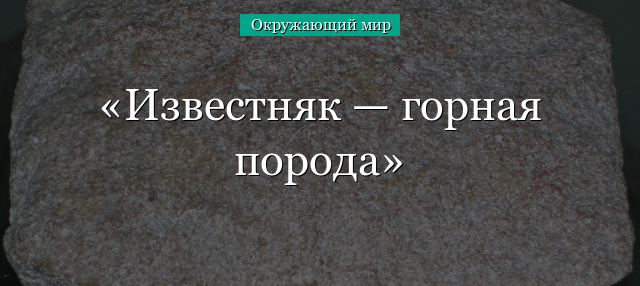
4.5
Средняя оценка: 4.5
Всего получено оценок: 53.
Обновлено 24 Сентября, 2021
4.5
Средняя оценка: 4.5
Всего получено оценок: 53.
Обновлено 24 Сентября, 2021
На улицах южных городов часто встречаются дома из светлого камня с раковинами моллюсков. В метро облицовка стен плитами с раковинами разного вида привлекает внимание пассажиров. В щебне, на речном пляже, в старом карьере также можно найти обломки с причудливыми ракушками. Как называется эта порода, где она образуется, как используется, рассмотрим в статье.
Раковины в камне
Осадочная горная порода, состоящая из раковин древних моллюсков, называется известняком. Моллюски, кораллы, морские лилии, известковые водоросли и другие обитатели древних, тёплых, неглубоких морей миллионы лет назад жили и погибали, их раковины, веточки опускались на дно.
Останки организмов цементировались известковым илом — кальцитом, выпадающим в осадок из морской воды.
Моря отступали, их дно постепенно воздымалось. Слои известняков оказались на суше. Мощность горизонтов, сложенных известняками, колеблется от нескольких сантиметров до десятков-сотен метров, иногда — нескольких километров.
Название известняку даётся в соответствии с теми организмами, которые в нём преобладают. Например, известняк коралловый, водорослевый. Известняк, сложенный раковинами или их обломками, называется ракушечник.
Характеристика известняка
Известняк — горная порода, состоящая из кальцита. Именно из кальцита состоит внешний скелет древних и многих современных обитателей водоёмов.
Порода мягкая, легко царапается, при обилии раковин непрочная. Цвет зависит от состава примесей: от белого, желтоватого до красного, почти чёрного.
Порода легко определяется по реакции с кислотой — выделяется газ, поверхность вспенивается, слышно шипение. Вода постепенно растворяет известняк. Это свойство объясняет образование пещер.
Типы известняков
Среди известняков выделяются типы, указывающие на происхождение или строение породы.
- Органогенный — образован остатками древних морских обитателей.
- Мел, состоящий из микроскопических обломков раковин, также относится к органогенному типу.
- Оолитовый — результат осаждения кальцита из морской воды. Представляет собой скопление мелких округлых образований. Каждый «шарик» — это песчинка, обросшая кальцитом.
- Травертин возникает в минеральных источниках, где кальцит осаждается на дно, ветки и листья растений. Порода пористая с микроскопическим размером кристаллов.
Под действием высокого давления и температуры известняк превращается в мрамор.
Многие станции московского метро отделаны известняковыми плитами. На 50 станциях наблюдаются окаменевшие раковины древних моллюсков, кораллов.
Использование известняка
Известняк используется как отделочный и строительный материал. Известные постройки в Павловском парке, Казанский собор в Санкт-Петербурге, Гатчинский дворец строились и украшались с применением известняка.
Известняк требуется в производстве цемента, стекла, бумаги, в металлургии. В сельском хозяйстве служит добавкой в корм, улучшает почву.
В докладе на урок по окружающему миру во 2 классе можно привести описание разных типов известняка, кратко рассказать, какая горная порода образуется из известняка.
Что мы узнали?
Известняк — осадочная порода, распространённая в природе, состоящая из раковин древних моллюсков. Известняк применяется в строительстве и отделке, например, многие станции метро отделаны известняковыми плитами.
Тест по теме
Доска почёта

Чтобы попасть сюда — пройдите тест.
Пока никого нет. Будьте первым!
Оценка доклада
4.5
Средняя оценка: 4.5
Всего получено оценок: 53.
А какая ваша оценка?
Эта горная порода используется человеком со времен Древнего Египта. Из нее сложены культовые здания в разных уголках планеты. Сегодня известняк – доступный строительный камень. Ценим магами и лекарями.
Содержание
- Что представляет собой
- История
- Откуда берется порода
- Физико-химические характеристики
- Классификация, разновидности
- По виду примесей
- По структуре, составу
- По текстуре, сфере применения
- Месторождения
- Добыча
- Где используется
- Строительство
- Промышленность
- Другие сферы
- Ограничения
- Лечебный потенциал
- Магическое влияние
- Известняк по Зодиаку и профессии
Что представляет собой
Известняк – это обломочная либо осадочная горная порода.
- Состоит из карбоната кальция в форме разнокалиберных кристаллов кальцита. Лишен блеска.
- Камень известняк по составу – это кальцит плюс примеси.
- Классический известняк не особо прочен, светлый с сероватостью, желтизной, бежеватостью. Наличие в составе минералов обеспечивает заполнение пор, повышая прочность. Попутно обогащается цветовая палитра осадочной породы.
История
Формирование известняковых пород стартовало 240 млн. лет назад, во времена триасового периода. Это триасовая разновидность. Возраст залежей остальных видов втрое меньше.
Еще первобытные люди оценили как кров «выемки» в массивах известняков.
Со времен раннего Средневековья это строительный камень в Европе и на Руси.
Из известняка сделаны фрагменты Великой Китайской стены, пирамиды Египта, стены Кремля.
Откуда берется порода
Известняки формируются тремя путями:
- Биологически. Обитатели морей и океанов вычленяют из воды карбонат кальция – строительный материал раковин, панцирей, скелетов. Пример – кораллы, ракушечник.
- Хемогенно. Осадочная порода – результат осаждения из водных соленых растворов при химических реакциях либо испарении воды. Примеры – туфы, мергели.
- Смешанный тип.
Длительность обоих процессов – миллионы лет. Отлагаясь, порода создает пласты известняка от десятка сантиметров до 4-5 километров. Чем «моложе» отложения, тем рыхлее порода.
Особый случай происхождения породы – метаморфизм. В процессе магматической перекристаллизации под воздействием запредельных температур и давления известковая порода уплотняется, твердеет, зернистость мельчает. Известняк становится мрамором.
Физико-химические характеристики
Натуральный известняк не особо плотен, прочен, легко режется. Исключение – «мраморы» и «кораллы».
Единых показателей базовых физических характеристик – плотность, предел прочности, другие – у известняков нет. Значение определяется происхождением, структурой, возрастом, типом породы. Это касается и материала из одного и того же месторождения.
Классификация, разновидности
Известняк как порода осадочного происхождения – это массивы разного цвета, пористости, прочности. Диапазон – от крошащегося мела до несокрушимого гранита.
Такое разнообразие создают примеси в составе камня – химические и органические.
Разработана классификация известняков по видам на основе базовых свойств.
По виду примесей
Наличие химического элемента в составе создает цвет камня:
| Цвет камня | Вид примеси |
| Коричневый, охряно-желтый | Железо |
| Красный, буроватый | Марганец |
| Серый до черного | Органика (нефть и подобное) |
| Зеленые | Морская растительность |
| Белый, сероватый | Без примесей |
Серо-черный камень известняк – самый редкий.
По структуре, составу
По составу выделяют следующие виды породы:
- Мраморизованные. Твердая малопористая порода бежевых оттенков.
- Коралловые. Твердые пористой структуры камни, строительным материалом для которых становятся раковины, панцири ископаемых моллюсков. Формируют колонии-рифы и атоллы.
- Доломитизированные. Образцы с 3,9-16,8% оксида магния.
- Мергели. Материал с серой в составе.
Промежуточное звено между известняками и мергелем – глинистые известняки. Они хрупче сланцевых глин, мягче известняков. Плюс плавающее соотношение глины и карбонатов в составе камня.
По текстуре, сфере применения
Различают материал слоистой либо трещиноватой текстуры.
По сфере использования известняки классифицируются как флюсовые и облицовочные.
Месторождения
Известняк – повсеместно распространенная порода с объемами в миллиарды тонн.
За что обрел репутацию «неисчерпаемого»:
- Залежи осадочного происхождения есть на всех континентах, кроме Антарктиды и Австралии.
- Альпы, Пиренеи, Крымские горы сложены из известняков.
- Крупнейшее месторождение выявлено на востоке Украины.
Львиная доля российских месторождений известняка сосредоточена на Европейской части: здесь миллионы лет назад плескались морские волны.
Камень добывают от Архангельска до Краснодарского края. Богаты известняками окрестности Белгорода, Тулы, Москвы, Санкт-Петербурга, Вологды, Воронежа.
Самый молодой – Ждановский рудник в Оренбуржье.
Камень есть на Урале, Кавказе, в Сибири, но это единичные случаи.
Добыча
Как правило, известняк залегает неглубоко.
Поэтому добыча камня ведется не шахтным, а взрыво-вскрышным методом:
- Поверхностный слой почвы снимается.
- В массиве бурятся шурфы, в которые укладывается взрывчатка и тротил.
- Материал подрывается.
- Образовавшимися обломками загружают самосвалы и вывозят на дробильно-обогатительную фабрику.
- Здесь породу дробят на фракции и отправляют заказчикам.
- Некондицию – материал мельче сантиметра – возвращают на карьер.
На маломощных участках природный камень распиливают на фрагменты нужных габаритов и вывозят на завод.
Европейцы используют технологию «взрыхление плюс погрузка». Применение взрывчатки не предусмотрено.
Где используется
Утилитарные характеристики известняка – прочность, полируемость, шлифовка, другие виды обработки – обусловили востребованность камня.
Строительство
Главные потребители продукции – строители, архитектурные и ландшафтные дизайнеры:
- Природный камень – исходник для изготовления щебня, мела, цемента, бетона, других смесей.
- Известняк – порода средней прочности, поэтому как базис стен, перекрытий используется редко. Качественный, вязкий материал – негашеная известь. Получается обжигом природного камня.
- Плитами покрывают стены зданий (внутри и снаружи), полы, лестничные марши, камины.
- Мостят дорожки в парках, вокруг загородных, дачных домов.
- Камни пастельной гаммы – эстетичный декоративный материал (балясины, карнизы, лепнина). Хорош травертин (известковый туф).
Разнообразие сортов строительного камня облегчает выбор марки для конкретной цели.
Промышленность
Производственники используют известняк для своих нужд:
- Для металлургов это флюс, облегчающий выплавку сплавов.
- Для стекольщиков – компонент жаропрочного стекла.
- Без него невозможно изготовление резины, соды, лаков, красок, другой продукции химического сегмента.
- Аграрии закупают удобрения и корма для скота на основе либо с добавками известняка. Им нейтрализуют кислотность почвы.
- Это сырье при производстве зубного порошка, бумаги, цветного мела, варке мыла.
В пищепроме камень – фильтр при очистке воды и изготовлении сахара.
Другие сферы
- Лучший материал достается ювелирам и коллекционерам.
- Ювелиры вытачивают из полупрозрачных камней пастельных оттенков бусины, вставки для колец, брошей, перстней. Обрамляют серебром, ювелирным сплавом, мельхиором.
- Собиратели минералогических коллекций стремятся создать композицию из камней всех текстур, цветов, месторождений. Объект охоты – образцы с останками доисторической флоры и фауны в массиве породы либо отпечатками.
Ограничения
Применение известняка как основы стен зданий сдерживают его свойства:
- Впитывает воду, постепенно растворяясь.
- Взаимодействуя с кислотами, высвобождает углекислый газ.
В результате осадки, грунтовые воды с кислотными соединениями разлагают известняковый массив. Иногда очень быстро. А под зданиями создаются пустоты. Поэтому плиты либо блоки пропитывают водоотталкивающим составом.
Лечебный потенциал
Камень из органики уважают целители. Это гипоаллерген с универсальным целебным воздействием. У цветов своя «специализация»:
- Желтый. Отлаживает работу ЖКТ.
- Голубой. Понижает давление.
- Розовый, красный. Нормализует психические кондиции, сон. Используется для решения проблем крови.
Буддисты используют желтый камень как объект медитации.
Камень независимо от цвета – антисептик, подавляющий инфекции в любой точке организма.
Противопоказания единичны:
- Голубой камень требует осмотрительности от гипотоников.
- Вдыхание известняковой пыли угнетает органы дыхания. Это проблема работников предприятий по переработке руды.
Лечение известняком предусматривает наложение камня на больное место. Можно подержать в руках либо пить воду, в которой вымытые камешки пролежали ночь.
Магическое влияние
Магическое воздействие известняка копирует кальцит:
- Активация, усиление интуиции.
- Ограждение от спонтанных действий, решений и вызванных ими проблем.
- Способность анализировать заранее последствия принятых решений.
Камень показан как талисман сибаритам, невротикам, ленивцам, гневливым натурам.
Известняк – помощник влюбленных и творческих натур. Первые добьются благосклонности любимого человека, вторые почувствуют прилив вдохновения.
Известняк по Зодиаку и профессии
Известняк относится к породам-универсалам: подходит всем знакам, кроме Скорпионов. Причина несовместимости – светлая устремленность камня и склонность к «чернокнижию» людей данного знака.
Помощь камня пригодится людям, оперирующим точной информацией. То есть инженерам, менеджерам, банкирам, бухгалтерам, юристам.
- Доклады
- Окружающий мир
- Известняк полезное ископаемое
Доклад на тему Известняк полезное ископаемое сообщение
Известняк чаще всего имеет органическое происхождение и относится к осадочным горным породам. Он образуется на морском дне вследствие отмирания различных морских животных, в чьих костях и панцирях очень много кальция. Можно сказать, что там, где располагаются известняковые отложения, раньше было мелководье древнего моря. Преимущественно известняки имеют белый цвет, но могут быть серыми и даже розовыми. Большое влияние на цвет оказывают различные примеси, которые могут содержаться в самой породе.
Основным химическим компонентом известняка является карбонат кальция, который хорошо растворим в воде. Это обычно становится предпосылкой образования карста – вымытых водой пустот в горных породах, сложенных известняками. Кроме того, известняк способен разлагаться с выделением углекислого газа. Этот процесс, происходящий на больших глубинах, способствует появлению насыщенных газом минеральных вод.
Одной из наиболее распространенных разновидностей известняка является мел. Это белый известняк, чье применение не ограничивается возможностью писать на школьной доске. Мел, например, входит в состав различных отделочных материалов. Его также используют при производстве бумаги высокого качества, при изготовлении зубного порошка, в покрытии электродов.
Известняк незаменим в строительстве. Это пористый материал, который способен неплохо сохранять тепло, но при этом свободно пропускает воздух. Поэтому в помещениях, построенных из известняковых плит, не бывает слишком влажно. Немаловажно и то, что, как и все осадочные породы, известняк достаточно мягкий и очень легко поддается обработке.
Широко известно использование известняка в сельском хозяйстве. Из его получают известь, используемую как удобрение. Известь особенно актуальна для нашей страны, где очень большие территории занимают кислые почвы. Ее применение позволяет регулировать кислотность почв, что повышает их плодородие.
В дорожном строительстве из известняковых пород создают насыпи, его также используют при необходимости уплотнить грунт.
В природе месторождения известняка встречаются по всему миру. Например, в Альпах известны целые цепи гор, которые практически полностью сложены из известняковых пород. Как правило, его добывают в открытых карьерах, снимая слой грунта, чтобы достигнуть самой породы. При этом используются тяжелые машины, существует также практика подрыва пластов.
Сообщение 2
Известняк – это осадочная порода, образованная из органических веществ. Однако, следует отметить, что встречается также известняк, основой которого является хомоген. Известняк служит основанием для формирования
Настоящий известняк имеет в своем составе карбонат кальция, который подвержен растворению в воде, что ведет к формированию карста. Второе его свойство – способность разлагаться при воздействии на породу углекислого газа, что чаще всего происходит на большой глубине. Проходящий под воздействием высокой температуры химический процесс ведет к образованию в подземных камерах уникального газа. который обогащает грунтовые воды до состояния минеральной.
Существует несколько разновидностей известняка.
Мраморовидный известняк разделяют на тонкослоистый и массивно слоистый. В процессе метаморфизма известняковые частицы испытывают эффект перераспределения кристаллизации, который, в свою очередь, ведет к формированию мрамора.
Нуммулитовый известняк состоит из останков вымерших одноклеточных организмов, живших на нашей планете миллионы лет назад.
Мшанковый известняк состоит из останков живых организмов, являющихся беспозвоночными. Эти микроорганизмы были очень мелкого размера и проживали колониями на морях и океанах древней Земли.
Известняк, сформированный в природе, имеет светло-серый оттенок, однако, может встречаться идеально белого или черного цветов.
Известняк служит базовым элементом для формирования горной породы, поэтому можно смело утверждать, что его запасы рассредоточены по всему миру. Добыча известняка не предполагает больших трудностей. Экскаваторами снимается верхний слой грунта и формируется карьер. Извлеченную породу грузят на машины и транспортируют на заводы по переработке этой породы.
Известняк получил широкое распространение в металлургической промышленности в виде флюса, а так же при изготовлении цемента или извести. В строительном деле применяются известняковые блоки и облицовку зданий. Известняковые камни применяются при строительстве дорог и закладке фундаментов.
3 класс. Окружающий мир
Картинка к сообщению Известняк полезное ископаемое
Популярные сегодня темы
- Широколиственные леса
Широколиственные леса чаще всего можно встретить в местах с умеренным соотношением влаги и тепла. В основном такие леса растут в Северной Америке, Японии, на дальнем Востоке и в средней Азии.
- Музыка
Сообщения по Музыке. Музыка — это искусство организации звуков во времени, чтобы создать мелодические, ритмические или гармонические композиции, которые могут выражать чувства, эмоции, идеи и
- Город Суздаль
Этот древний город по праву может претендовать на звание наиболее красивого в составе Золотого кольца. Тут множество великолепных храмов – красивейших примеров древней русской архитектуры.
- Мир профессий
Кем быть – этот вопрос занимает практически каждого человека, ведь человек определяется через собственные дела. Фактически мы можем определить человека через плоды его деятельности
- Корова
Корова – это самое распространенное домашнее животное в мире. Особь женского рода называют корова, а мужского рода – бык. Молодую корову или быка называют теленком.
- Вулканы России
Для начала разберём что представляет собой вулкан. Вулканическая гора — это конусообразное возвышение, которое имеет небольшое отверстие в самой высокой точке. Обычно вулканы располагаются та
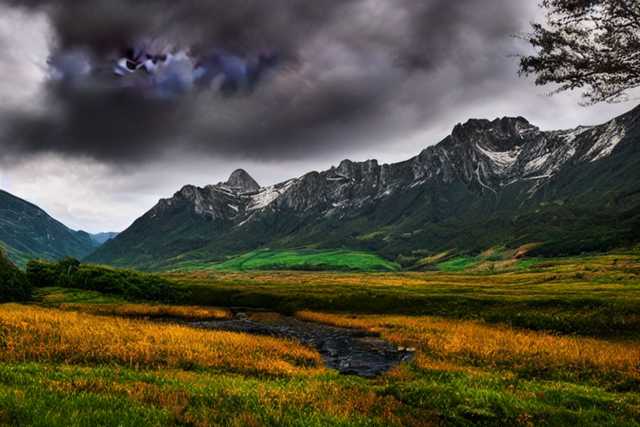
Известняк представляет собой осадочную породу. В процессе ее образования получается камень, обладающий пористой структурой, отличающийся плотностью и цветом, в составе которого преобладают кальциты. Он также содержит минеральные вещества, снижающие его пористость и повышающие прочность.
Чаще всего известняки образуются в соленых морских бассейнах, но иногда они формируются в процессе испарения озер. Цветовая гамма у них в основном светло-серая, бежевая или желтоватая. Наличие примесей в составе придает бурый или зеленоватый оттенок.
В природе встречается несколько видов известняка: мраморные, плотные породы и пористые минералы.
По структуре известняки бывают кристаллическими, органогенно-обломочными, обломочно-кристаллическими, натечными. По происхождению — биогенными, хемогенными, обломочными, смешанными.
История происхождения известняка
Обычно происхождение минерала обусловлено жизнедеятельностью организмов, синтезирующих из соленой воды карбонат кальция для получения скелетов с раковинами. В редких случаях он обладает хемогенным происхождением (образование в соленых водах происходит за счет осаждения извести). Порода оседает на протяжении миллионов лет. Известковые отложения могут иметь толщину от нескольких сантиметров до нескольких километров. Чем моложе отложения, тем более рыхлая у них структура.
Мраморовидные породы – это промежуточный пласт между известняком и мрамором. Их используют при возведении домов и скульптур.
Из плотных пород делают облицовочные плиты, которыми потом декорируют строения изнутри и снаружи. Их применяли еще для отделки египетских пирамид. Из плотного известняка строили храмы, которые не боялись перепадов температур и сохраняли презентабельный вид на протяжении многих лет.
Пористые минералы отличаются друг от друга зернистостью. Ракушечник является одной из самых популярных разновидностей. Он представляет собой миниатюрные осколки раковин. Некоторые виды ракушечника используют в качестве декоративного материала, их легко обрабатывать и полировать. Пористые породы задействуют при возведении стен, во внутренней и внешней облицовке строений.
Плотность кристаллического известняка приближена по структуре к мрамору, он отличается повышенной морозоустойчивостью.
К обломочно-кристаллической разновидности относят органогенный детрит, который образуется из останков живых существ и растений. Его недостатки заключаются в малой прочности и повышенном влагопоглощении.
Формирование натечной разновидности (известкового торфа) происходит из нерастворенной соли в источниках с проточной и стоячей водой.
Свойства известняка
Известняк отличается пластичностью, хорошо растворяется в воде и кислотах. Он нуждается в дополнительной обработке составами, отталкивающими влагу, если в планах его применение в отделке и ландшафтном дизайне.
Морозостойкость определяется химическим составом. Этот параметр максимальный у мраморизованной разновидности.
Важно! Свойства камня определяются источником его происхождения и структурой. В пределах одного месторождения могут быть залежи разной плотности, веса и прочности. Более плотные разновидности хорошо поддаются полировке, пористые, к примеру, ракушечник, хорошо распиливаются и обтесываются.
Плотность материала составляет 2700–2900 кг/м³.
Твердость по шкале Мооса – 3.
Основой известняка является карбонат кальция, его доля в составе — от 50 до 95 %. Оставшаяся часть приходится на кварц и прочие минералы. В природе встречается известняк разных цветов, но наиболее распространен белый. Минерал, содержащий нефтепродукты, обладает черной окраской.
Физическая и химическая стойкость известняка оставляют желать лучшего. Он хоть и медленно, но растворим в воде, демонстрирует уязвимость к действию кислот.
Месторождения
В Российской Федерации месторождения известняка сконцентрированы в европейской части, а также в Сибири и на Урале. Большую известность получили месторождения в Рязанской и Владимирской областях.
Добыча природного камня в РФ осуществляется в основном при помощи буровзрывных работ. Сначала верхний почвенный слой снимают бульдозером. В твердых пластах известняка бурят шурфы, глубина которых достигает 24 метров. Туда закладывают взрывчатку и тротил. Чтобы выполнить один подрыв, нужно сделать от 20 до 30 скважин и задействовать 5 тонн взрывчатого вещества.
Альтернативным способом добычи природного камня является технология рыхления и погрузки. К достоинствам этой методики относят селективную выемку минерала в месторождениях, имеющих слоистую структуру. При выполнении таких работ обязательно задействуют массивную промышленную технику.
На дробильно-обогатительных предприятиях минерал дробят на крупные, средние и мелкие фракции. В местах небольших залежей его просто распиливают на небольшие прямоугольные пласты и отвозят машинами на завод.
В Тульской области добывают не только обычный известняк, но и мраморизованный, представляющий особую ценность. В Подмосковье есть месторождения редкой породы кремового цвета.
Использование известняка
Известняк чрезвычайно востребован, его применяют при строительстве жилых зданий, возведении хозяйственных построек, в ландшафтном дизайне, при изготовлении цемента, в металлургии. На основе известняка возводят несущие конструкции и внутренние перегородки, выполняют облицовку поверхностей, изготавливают краску, шпатлевку, стекло, соду. Это универсальный материал, сфера использования которого разнится и зависит от места происхождения, физических свойств и состава.
Прочностные характеристики минерала позволяют строить на его основе малоэтажные объекты, но обычно камень применяют для облицовки. Из известняка делают панели для стен, декоративные плиты, пилястры, другие украшения.
Мелкофракционный камень служит щебнем при изготовлении бетона, крупные фракции задействуют при обустройстве оснований автомобильных магистралей и гидротехнических объектов. Бутовый известняк применяют при создании фундаментов.
Природным камнем отделывают фасады, он хорошо противостоит неблагоприятным погодным явлениям. На основе тонких срезов делают дорожки в садах и тротуары.
Мраморизованную разновидность используют в дизайне интерьеров для облицовки стеновых поверхностей, лестниц. Из известняка делают столешницы для кухни, подоконники, барные стойки. Из камня изысканных оттенков создают каминные порталы, журнальные столы, колонны. Особую ценность представляет минерал с характерным рельефом.
Известняк незаменим при изготовлении отделочных материалов. Это один из компонентов цемента – минерал смешивают с глиной, шлаком, корректирующими добавками.
В химической промышленности из известняка делают пластик, резину. Его также задействуют при выплавке металлов. За счет известнякового флюса снижается температура плавки, облегчается отхождение металла от пустой породы.
Известняк входит в состав зубных паст и обувных кремов. Ему находится применение в изготовлении фильтров и минеральных подкормок. А еще из известняка делают бумагу. Из одной тонны известняка реально получить 800 кг готовой продукции. Некоторые разновидности минерала используют в изготовлении абразивных составов, предназначенных для тонкой шлифовки. В сельскохозяйственной сфере известняк служит минеральной добавкой для животных и птицы. Фермерами он часто применяется в качестве удобрения при выращивании зерновых культур.
Защитные покрытия для изделий из известняка
Защитными покрытиями для известняка служат полимеры и силиконовые полироли. Этот камень обладает пористой структурой. Чтобы не допустить появления пятен, его нужно регулярно обрабатывать специальными составами. Они помогут сохранить первозданный вид минерала.
Рекомендации по уходу за поверхностями, облицованными известняком
Поверхности, облицованные известняком, нуждаются в регулярной уборке. Появившиеся пятна нельзя оставлять, иначе они проникнут вглубь. Их необходимо вывести в течение получаса.
Важно! После высыхания пятен уборка оказывается бесполезной. Если самостоятельно очистить камень не получается, следует воспользоваться услугами специалистов.
В случае со столешницей из известняка необходимо пользоваться разделочной доской, посуду размещать только на подставках. Недопустимо устанавливать на поверхность предметы, нагревающие ее до температуры, превышающей 150 градусов.
На время ремонтных работ и окрашивания изделия из камня нужно накрывать. Запрещено применять их в качестве основания при обращении с молотком или ножами – это чревато появлением трещин и сколов.
Поверхность каменного пола может быть скользкой при намокании. Уменьшить опасность помогут ковры. С каменных поверхностей на улице, например, с дорожек в саду нужно регулярно убирать воду, наледь и снег.
В каталоге на сайте можно выбрать и заказать необходимую обработку известняка под конкретный проект.
Заполните форму заказа или оставьте контакты для обратного звонка.
- Энциклопедия
- География
- Известняк полезное ископаемое
Известняк выдает собой горную породу, осадочную. Чаще всего, он происходит путём органических соединений. В состав известняк входит такие химические понятия как карбонат кальция, он представлен в виде особых кристаллов.
Классификация:
В состав карбоната входит карбонат кальция, как было сказано выше. Этот карбонат способен растворяться в воде с образованием карста. Кроме растворения, ему присуще разложение на гидроксид и углекислый газ.
Несколько видов известняка:
- Животные, проживающие в морях способны участвовать в образовании известняка. Но безусловно, не все могут заниматься таким делом, а только беспозвоночные. Такой вид известняка принято называть мшанковым.
- Известняк способен в процессе метаморфоза обращаться в мрамор. Таким образом, он может делиться на тонкослоистый и массивнослоистый.
- Нуммулитовый. Он состоит из уже раннее вымерших организмов, которые содержит одну клетку — нуммулиты.
Месторождения:
Как уже было сказано выше, известняк образуется с помощью других живых организмов. В свою очередь, эти организмы обитают в морях или других водных районах. Таким образом, место добычи известняков ясен, — как правило, это моря или океаны. Основное место добывания известняка — Альпы. Там замечено самое большое количество. В нашей стране находится также достаточное количество различных известняковых пород. Добывают эту горную породу с помощью карьера. Первый слой грунта снимают и образовывают тот самый карьер. В нем происходит отделение известняка от других пород.
Для чего нужен известняк?
Как правило, известняк используется для создаст цемента. Он является основным компонентом этой примеси. При создании соды, бумаги и соли, этот компонент также принимает участие. Если необходимо создать фундамент, то известняк тоже подойдёт, как главный материал.
Известняк — полезное ископаемое доклад
Люди с давних времен, много лет тому назад, стали использовать известняк в виде главного строительного материала, но о составе и о его глобальном происхождении даже и не догадывались. Их в то время это мало интересовала. А строение этого полезного и нужного природного ископаемого, узнали только ученые археологи, и только тогда когда у них появился микроскоп. Этой породе свойственны были многие разновидности цветов, такие например как серый, черный, розовый, а чаще всего, это был белый цвет. Важно знать, что белый цвет этого ископаемого использовался, намного чаще, в разных отраслях промышленности, чем все остальные цвета.
Место образование известковой породы
Начало свое известняк взял миллионы лет назад из глубин океанов, начал формироваться из мельчайших микроорганизмов, которые проживали огромными колонами на дне океана. Раковины и скелеты их, годами прессовались в одно целое, под влиянием атмосферного давления и определенной температуры окружающей среды. Спустя время океаны начинали постепенно, убывать, и отходить, а залежи известняка появлялись на самой поверхности земли. И в результате этого люди начали добывать этот природный ископаемый без особого труда, так как не нужно было погружаться подземные шахты. А можно было добывать и раскапывать на карьере. Для этого понадобились специальные машины и обученные люди, не обходилось это археологическое открытие без присутствия ученых.
Свойства известняка
Белый известковый камень издавна использовали, и по сей, день применяют для строительства помещений. Так как этот камень обдает неплохой проходимостью воздуха, и благодаря этому помещение не будет сырым и о появлении плесени можно позабыть. Важно отметить, что в таком доме будет очень тепло и уютно, он обладает накопительным свойством тепла, не выпуская его из дома.
Белый камень легко поддается деформации, и таким образом ему легко придать нужную форму. Ученики знают это ископаемое и применяют на практике в виде обычного мела для доски.
Никто даже представить себе не мог, что мрамор тоже является разновидностью известняка, только он создан под очень большим давлением воды. Из мрамора чаще всего встречаются созданные скульпторами красивые скульптуры, а также изготавливают плитку, делают облицовку строениям, как для внутренних архитектурных работ, так и для наружных.
Несмотря на то, что в современном строительстве стали чаще использовать металл, пластик и железобетон, но это не как не повлияло на количество добываемого и применяемого известняка. Так как эта порода практически во всех отраслях необходима, начиная от промышленной отрасли, в металлургии, а также в химической. Так же известняк широко распространен, своими свойствами и используется для очистки питьевой воды.
Можно сказать, что и производство мыла и минеральных удобрений не обошлось без этого полезного ископаемого. Подводя итог этому полезному ископаемому, он просто необходим и не заменим в природе.
Для 3 класса
Известняк полезное ископаемое
Популярные темы сообщений
- Хаммурапи царь
Хаммурапи – наимудрейший правитель, так о нем отзывались и при его жизни и после его смерти. Его вклад в развитие древнего Вавилонского государства не оценим, и до сих пор будоражит умы современных историков.
- Нуклеиновые кислоты
Нуклеиновая кислота представляет собой органическое соединение с остатками нуклеотидов. Делятся на дезоксирибонуклеиновую (ДНК) и рибонуклеиновую (РНК) кислоты. Эти элементы носят генетический характер клеточной структуры.
- Органы чувств
Организм человека устроен таким образом, что мы с вами умеем чувствовать такие вещи, как запахи, вкус или температуру. Каждый человек точно знает, как пахнут апельсины, как неприятно лекарство на вкус, какого цвета твой учебник по геометрии
- Творчество Александра Грина
Писательская карьера Александра Грина (Александра Степановича Гриневского) началась в 1906 году, когда 26-летний литератор опубликовал рассказ «Заслуга рядового Пантелеева». Рассказ, повествующий
- Крузенштерн Иван
Одним из выдающихся мореплавателей конца восемнадцатого – первой трети девятнадцатого века заслужено считается Иван Фёдорович Крузенштерн. Будущий адмирал родился в ноябре 1770 года в семье судьи и был седьмым ребенком в семье.
Известняк является одной из разновидностей пород осадочного происхождения. Он определяется во множестве проявлений – от ракушечника до сформированных коралловых рифов, горных массивов и тонких налетов, прочного мрамора и рассыпчатого белого мела.

Известняк не относится к прочным и плотным породам, кроме некоторых разновидностей (мраморные, коралловые). Он гигроскопичен, растворяется в воде, легко поддается резанию, при взаимодействии с кислотами выделяет углекислоту. Этот фактор опасен для человечества, так как подземные воды и осадки, насыщенные кислыми соединениями, в краткие сроки способны разлагать грунтовые отложения известняка. В результате вымытых пустот образовываются провалы, которые способны поглотить многоэтажные здания.
История происхождения
Зарождение известняковых пород началось сотни миллионов лет назад. С первобытных времен люди оборудовали жилище в гротах и пещерах, состоящих из известняков. С тех пор камень стал использоваться как уникальный, прочный строительный материал, из которого впоследствии возводились города Древней Руси, статуи, скульптуры и монументы.
К шедеврам культуры, созданным из известняка много веков назад и сохранившимся до настоящего времени, относят египетские пирамиды, Китайскую стену и Кремль в Москве.
Виды и цвета известняка

В зависимости от вида примесей можно объединить известняки различных цветов в следующие группы:
- Белый и серый цвет – «чистая» порода, не содержащая посторонних примесей;
- Красные и бурые оттенки – известняки, в составе которых имеется примесь марганца;
- Желтые и коричневые цвета – обеспечиваются примесями железа;
- Зеленые тона – камни с органическими включениями в виде морских водорослей;
- Темно-серые и черные оттенки – редкие известняки с примесями органики.
В зависимости от структурных особенностей и химического состава породы:
- Доломитизированные – известняки, в составе которых содержится 4 до 17% оксида магния. При увеличении доли магния происходит преобразование этой разновидности породы в доломиты.
- Мраморизованные – карбонатные известняки с палитрой оттенков от светло-бежевого до серо-голубого и высоким содержанием органических включений (окаменевших раковин моллюсков).
- Коралловые – твердые известняки с пористой структурой, формирующиеся в рифы из раковин моллюсков и панцирей других древних обитателей морской фауны.
- Глинистые – образования, имеющие промежуточный состав между известняками и мергелем, при этом соотношение частиц глины и карбонатов может варьироваться. Они мягче известняков и более хрупкие в сравнении со сланцевыми глинами.
По происхождению выделяют следующие разновидности известняков:
- Юрский (мраморный) – органическая порода с историей в сотни миллионов лет, которая имеет высокую прочность, плотность и мелкую зернистость. В Средневековье разновидность известняка называли мраморным за его подверженность полировке.
- Путиловский – известняк с уникальными физическими характеристиками, низким процентом поглощения влаги и истирания. В период становления Петербурга являлся основным строительным материалом, назван в честь места добычи известняка – Путиловского карьера, расположенного в Ленинградской области.
В зависимости от сферы применения:
- Флюсовый – прочный вид известняка, основное сырье для получения флюса, который имеет широкое применение в металлургии, где используется для выплавки металлов.
- Облицовочный – строительный камень органического происхождения, который используется для облицовки экстерьеров и интерьеров помещений.
По особенностям залегания и макротекстуре различают трещиноватые, слоистые, оползневые, плитчатые, кавернозные известняки.
К содержанию
Добыча известняка и его месторождения

Основные месторождения России расположены в западной части государства, которая в прошлом была покрыта морями. Массовые разработки ведутся от Белгородской и Тульской области к Москве, в Вологодской, Воронежской области и окрестностях Санкт-Петербурга, в регионах Краснодарского края и Архангельска. В настоящее время активные разработки известняка ведутся в Ждановском месторождении, которое находится в Оренбургской области. Урал и Сибирь отличаются единичными месторождениями.
В странах ближнего зарубежья крупнейшее Еленовское месторождение камня находится в Донецкой области Украины. Множество горных массивов Альп имеют известняковое происхождение.
Лечебные свойства минерала

Целебные свойства также проявляются в зависимости от цвета минерала:
- кальцит красных и розовых оттенков – снимает нервное перенапряжение, нормализует сон, помогает в лечении заболеваний крови;
- голубой известняк – способствует снижению артериального давления, поэтому его следует аккуратно использовать гипотоникам;
- желтый минерал – улучшает пищеварение, а также используется для медитаций.
Для достижения результата известняк прикладывают к проблемному месту, держат в руках определенное время, а также пьют очищенную минералом воду.
Несмотря на выраженный лечебный эффект известняк может нанести вред. Так, частое вдыхание большого количества известняковой пыли может негативно сказаться на здоровье и вызвать заболевания дыхательных путей.
Магия камня
Магическое действие известняка аналогично силе кальцита. Он так же развивает в людях интуицию, способность предвидеть действия и последствия. Своей энергетикой камень на эмоциональном уровне притягивает к своему хозяину внимание окружающих. Это свойство часто используют девушки для приворота к себе понравившегося парня.
Оберег с известняком оградит от ошибочных решений, защитит от неприятностей. Камень помогает избавиться от лени и плохого настроения. В творческих натурах он разовьет фантазию и тягу к прекрасному.
К содержанию
Применение известняка
Свойства и структурные особенности камня способствуют его широкому применению во многих направлениях народного хозяйства. Основными сферами, в которых он используется, являются:
- Строительство и дизайн (облицовка фасадов зданий и интерьеров, устройство полов, ступеней и каминов, оформление ландшафтов, производство известняковых смесей, цемента, мела и многих видов щебня, изготовление элементов декора);
- Стекольное дело (один из компонентов в производстве термостойкого стекла);
- Металлургическая промышленность (флюсовые известняки применяют при изготовлении сплавов);
- Строительство дорог (щебень фракций различной величины);
- Кабельное производство, изготовление известняковых растворов для покрытия сварочных электродов;
- Изготовление зубного порошка, мелков для рисования;
- Химическая отрасль (производство соды, изготовление резины и лакокрасочных составов);
- Известняк также используется в качестве сырья в мыловарении, полиграфии и производстве удобрений. В пищевой промышленности камень применяется в качестве фильтра при изготовлении сахара.
В ювелирном деле используются полупрозрачные камни, окрашенные в пастельные тона. Их гранят для украшений, после чего оправляют преимущественно в мельхиоровую или серебряную оправу.
Знаки зодиака
Известняк, основой которого является кальцит, можно порекомендовать всем знакам зодиака, кроме Скорпионов. Представители этого знака Зодиака более всего склонны к черной магии и оккультизму, в то время как энергетика камня светлая. Именно поэтому волевые Скорпионы не находят общий язык с ним.
Остальные знаки Зодиакального круга могут в полной мере испытать на себе позитивные свойства известняка. Особенно ощутят помощь камня представители астрального дома, которым в профессиональной деятельности нужна четкость и безошибочность. Это финансисты, бухгалтера, медики и представители адвокатских структур.
К содержанию

